Netgear orporated 12400216 D6200 WiFi Modem Router User Manual D6200 WiFi Modem Router
Netgear Incorporated D6200 WiFi Modem Router D6200 WiFi Modem Router
Contents
- 1. Users manual I
- 2. Users manual II
- 3. User manual I
- 4. User manual II
Users manual I
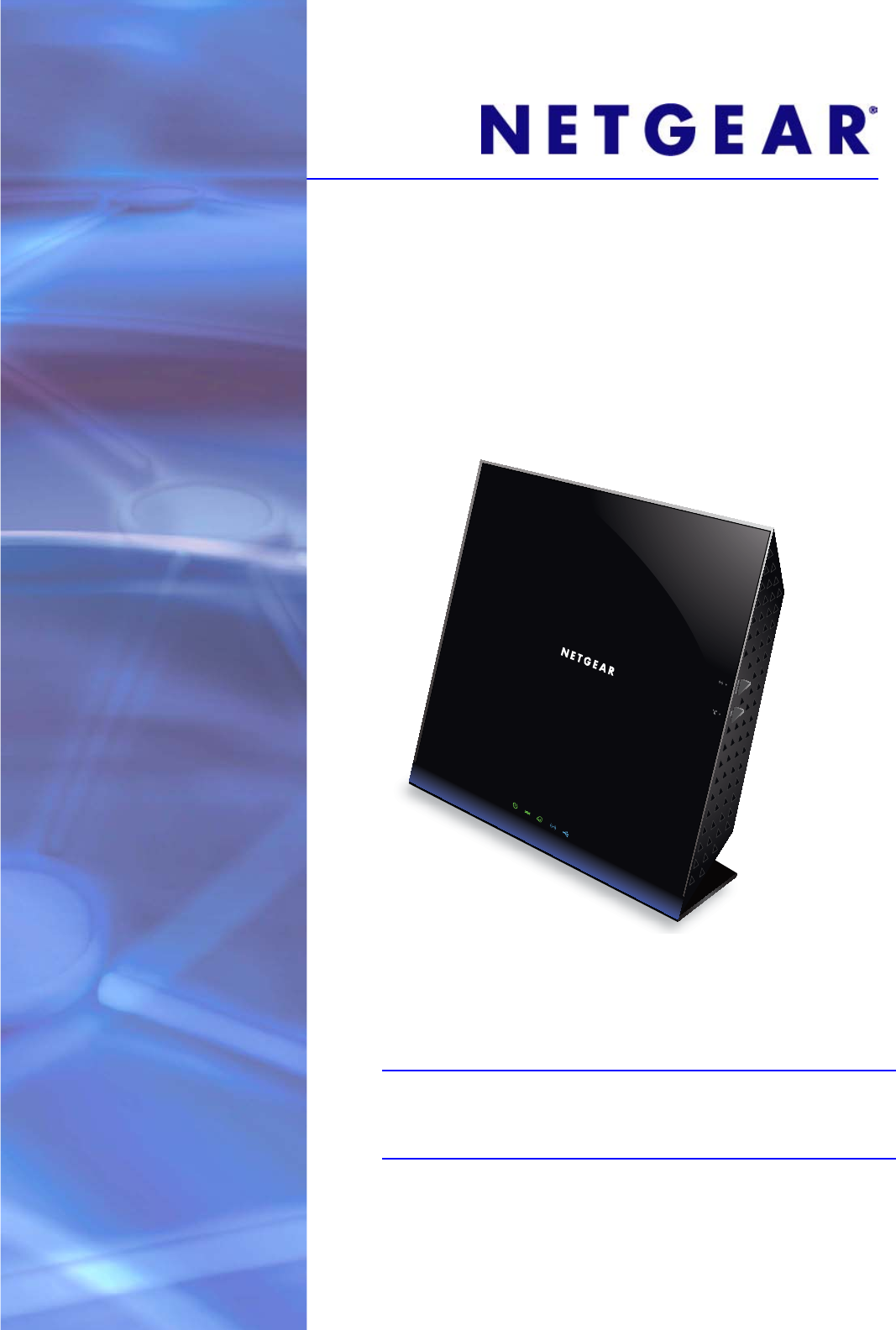
350 East Plumeria Drive
San Jose, CA 95134
USA
January 2013
CERTIFICATION DRAFT
v1.0
D6200 WiFi Modem Router
User Manual
Note: This draft is a certification document and
there might be some differences between
this user manual and the actual unit.

2
D6200 WiFi Modem Router
Support
Thank you for choosing NETGEAR.
After installing your device, locate the serial number on the label of your product and use it to register your product
at https://my.netgear.com. You must register your product before you can use NETGEAR telephone support.
NETGEAR recommends registering your product through the NETGEAR web site. For product updates and web
support, visit http://support.netgear.com.
Phone (US & Canada only): 1-888-NETGEAR.
Phone (Other Countries): Check the list of phone numbers at
http://support.netgear.com/general/contact/default.aspx.
NETGEAR recommends that you use only the official NETGEAR support resources.
Trademarks
NETGEAR, the NETGEAR logo, and Connect with Innovation are trademarks and/or registered trademarks of
NETGEAR, Inc. and/or its subsidiaries in the United States and/or other countries. Information is subject to change
without notice. Other brand and product names are registered trademarks or trademarks of their respective
holders. © NETGEAR All rights reserved.

3
Contents
Chapter 1 Hardware Setup
Unpack Your New Router. . . . . . . . . . . . . . . . . . . . . . . . . . . . . . . . . . . . . .11
Hardware Features. . . . . . . . . . . . . . . . . . . . . . . . . . . . . . . . . . . . . . . . . . .12
Label. . . . . . . . . . . . . . . . . . . . . . . . . . . . . . . . . . . . . . . . . . . . . . . . . . . .12
Back Panel . . . . . . . . . . . . . . . . . . . . . . . . . . . . . . . . . . . . . . . . . . . . . . . 13
Front Panel. . . . . . . . . . . . . . . . . . . . . . . . . . . . . . . . . . . . . . . . . . . . . . .14
Side Panel . . . . . . . . . . . . . . . . . . . . . . . . . . . . . . . . . . . . . . . . . . . . . . .17
Position Your Wireless Router . . . . . . . . . . . . . . . . . . . . . . . . . . . . . . . . . . 18
ADSL Microfilters . . . . . . . . . . . . . . . . . . . . . . . . . . . . . . . . . . . . . . . . . . . . 18
One-Line ADSL Microfilter (Not Included) . . . . . . . . . . . . . . . . . . . . . . .19
Two-Line ADSL Microfilter (Included). . . . . . . . . . . . . . . . . . . . . . . . . . . 19
Summary . . . . . . . . . . . . . . . . . . . . . . . . . . . . . . . . . . . . . . . . . . . . . . . .19
Cable Your D6200 WiFi Modem Router. . . . . . . . . . . . . . . . . . . . . . . . . . .20
Verify the Cabling . . . . . . . . . . . . . . . . . . . . . . . . . . . . . . . . . . . . . . . . . . . .21
Chapter 2 Get Started with NETGEAR genie
Prepare to Set Up the WiFi Modem Router . . . . . . . . . . . . . . . . . . . . . . . .23
Use Standard TCP/IP Properties for DHCP . . . . . . . . . . . . . . . . . . . . . . 23
Gather ISP Information. . . . . . . . . . . . . . . . . . . . . . . . . . . . . . . . . . . . . . 23
Wireless Devices and Security Settings . . . . . . . . . . . . . . . . . . . . . . . . .23
Types of Logins and Access. . . . . . . . . . . . . . . . . . . . . . . . . . . . . . . . . . . .23
NETGEAR genie Setup . . . . . . . . . . . . . . . . . . . . . . . . . . . . . . . . . . . . . . . 24
Use NETGEAR genie after Installation. . . . . . . . . . . . . . . . . . . . . . . . . . . .25
Upgrade WiFi Modem Router Firmware. . . . . . . . . . . . . . . . . . . . . . . . . . .25
WiFi Modem Router Dashboard (BASIC Home Screen) . . . . . . . . . . . . . . 26
Add Wireless Devices or Computers to Your Network. . . . . . . . . . . . . . . . 27
Manual Method. . . . . . . . . . . . . . . . . . . . . . . . . . . . . . . . . . . . . . . . . . . . 27
Wi-Fi Protected Setup (WPS) Method . . . . . . . . . . . . . . . . . . . . . . . . . .27
Chapter 3 NETGEAR genie BASIC Settings
Internet Basic Settings . . . . . . . . . . . . . . . . . . . . . . . . . . . . . . . . . . . . . . . . 30
Internet Basic Settings Screen Fields. . . . . . . . . . . . . . . . . . . . . . . . . . . 30
Attached Devices . . . . . . . . . . . . . . . . . . . . . . . . . . . . . . . . . . . . . . . . . . . .32
Parental Controls . . . . . . . . . . . . . . . . . . . . . . . . . . . . . . . . . . . . . . . . . . . .33
ReadySHARE USB Storage and Printer . . . . . . . . . . . . . . . . . . . . . . . . . .34
USB Storage (Basic Settings) . . . . . . . . . . . . . . . . . . . . . . . . . . . . . . . . 34
ReadySHARE Printer . . . . . . . . . . . . . . . . . . . . . . . . . . . . . . . . . . . . . . . 35
Basic Wireless Settings . . . . . . . . . . . . . . . . . . . . . . . . . . . . . . . . . . . . . . .35
Wireless Settings Screen Fields. . . . . . . . . . . . . . . . . . . . . . . . . . . . . . .36

4
D6200 WiFi Modem Router
Change WPA Security Option and Passphrase . . . . . . . . . . . . . . . . . . . 37
Guest Networks . . . . . . . . . . . . . . . . . . . . . . . . . . . . . . . . . . . . . . . . . . . . . 38
Guest Network Wireless Security Options . . . . . . . . . . . . . . . . . . . . . . . 39
NETGEAR genie App. . . . . . . . . . . . . . . . . . . . . . . . . . . . . . . . . . . . . . . . . 40
NETGEAR genie Mobile App . . . . . . . . . . . . . . . . . . . . . . . . . . . . . . . . . 41
Chapter 4 NETGEAR genie ADVANCED Home
Setup Wizard . . . . . . . . . . . . . . . . . . . . . . . . . . . . . . . . . . . . . . . . . . . . . . . 43
WPS Wizard . . . . . . . . . . . . . . . . . . . . . . . . . . . . . . . . . . . . . . . . . . . . . . . . 45
VPN Wizard . . . . . . . . . . . . . . . . . . . . . . . . . . . . . . . . . . . . . . . . . . . . . . . . 46
Setup Menu . . . . . . . . . . . . . . . . . . . . . . . . . . . . . . . . . . . . . . . . . . . . . . . . 48
ADSL Setup . . . . . . . . . . . . . . . . . . . . . . . . . . . . . . . . . . . . . . . . . . . . . . . . 49
WAN Setup. . . . . . . . . . . . . . . . . . . . . . . . . . . . . . . . . . . . . . . . . . . . . . . . . 50
Default DMZ Server . . . . . . . . . . . . . . . . . . . . . . . . . . . . . . . . . . . . . . . . 51
Change the MTU Size . . . . . . . . . . . . . . . . . . . . . . . . . . . . . . . . . . . . . . 51
LAN Setup . . . . . . . . . . . . . . . . . . . . . . . . . . . . . . . . . . . . . . . . . . . . . . . . . 53
LAN Setup Screen Settings . . . . . . . . . . . . . . . . . . . . . . . . . . . . . . . . . . 54
Use the WiFi Modem Router as a DHCP Server . . . . . . . . . . . . . . . . . . 54
Address Reservation . . . . . . . . . . . . . . . . . . . . . . . . . . . . . . . . . . . . . . . 55
Quality of Service Setup. . . . . . . . . . . . . . . . . . . . . . . . . . . . . . . . . . . . . . . 56
Chapter 5 USB Storage
USB Drive Requirements . . . . . . . . . . . . . . . . . . . . . . . . . . . . . . . . . . . . . . 62
ReadySHARE Access . . . . . . . . . . . . . . . . . . . . . . . . . . . . . . . . . . . . . . . . 62
File-Sharing Scenarios. . . . . . . . . . . . . . . . . . . . . . . . . . . . . . . . . . . . . . . . 63
USB Storage Basic Settings. . . . . . . . . . . . . . . . . . . . . . . . . . . . . . . . . . . . 65
Add or Edit a Network Folder . . . . . . . . . . . . . . . . . . . . . . . . . . . . . . . . . 66
USB Storage Advanced Settings . . . . . . . . . . . . . . . . . . . . . . . . . . . . . . . . 67
Safely Remove a USB Drive . . . . . . . . . . . . . . . . . . . . . . . . . . . . . . . . . . . 68
Media Server Settings . . . . . . . . . . . . . . . . . . . . . . . . . . . . . . . . . . . . . . . . 69
Specify Approved USB Devices . . . . . . . . . . . . . . . . . . . . . . . . . . . . . . . . . 70
Connect to the USB Drive from a Remote Computer. . . . . . . . . . . . . . . . . 71
Access the WiFi Modem Router USB Drive Remotely Using FTP. . . . . 71
Chapter 6 USB Printer Control
Control Center Configuration . . . . . . . . . . . . . . . . . . . . . . . . . . . . . . . . . . . 74
USB Printer . . . . . . . . . . . . . . . . . . . . . . . . . . . . . . . . . . . . . . . . . . . . . . . . 74
Scan with a Multifunction Printer . . . . . . . . . . . . . . . . . . . . . . . . . . . . . . . . 75
Chapter 7 Security
Keyword Blocking of HTTP Traffic . . . . . . . . . . . . . . . . . . . . . . . . . . . . . . . 77
Firewall Rules. . . . . . . . . . . . . . . . . . . . . . . . . . . . . . . . . . . . . . . . . . . . . . . 78
Add Custom Services to Allow or Block . . . . . . . . . . . . . . . . . . . . . . . . . . . 80
Schedule for Firewall Rules . . . . . . . . . . . . . . . . . . . . . . . . . . . . . . . . . . . . 82
Security Event Email Notifications . . . . . . . . . . . . . . . . . . . . . . . . . . . . . . . 83

5
D6200 WiFi Modem Router
Chapter 8 Administration
Upgrade the WiFi Modem Router Firmware. . . . . . . . . . . . . . . . . . . . . . . .85
View WiFi Modem Router Status . . . . . . . . . . . . . . . . . . . . . . . . . . . . . . . .86
Router Information . . . . . . . . . . . . . . . . . . . . . . . . . . . . . . . . . . . . . . . . .86
Internet Port . . . . . . . . . . . . . . . . . . . . . . . . . . . . . . . . . . . . . . . . . . . . . .86
Wireless Settings (2.4 GHz and 5 GHz) . . . . . . . . . . . . . . . . . . . . . . . . .88
Guest Network (2.4 GHz and 5 GHz) . . . . . . . . . . . . . . . . . . . . . . . . . . .89
View VPN Status . . . . . . . . . . . . . . . . . . . . . . . . . . . . . . . . . . . . . . . . . . . .89
View Logs of Web Access or Attempted Web Access . . . . . . . . . . . . . . . .90
Attached Devices . . . . . . . . . . . . . . . . . . . . . . . . . . . . . . . . . . . . . . . . . . . .92
Manage the Configuration File . . . . . . . . . . . . . . . . . . . . . . . . . . . . . . . . . .92
Back Up Settings . . . . . . . . . . . . . . . . . . . . . . . . . . . . . . . . . . . . . . . . . .92
Restore Configuration Settings. . . . . . . . . . . . . . . . . . . . . . . . . . . . . . . .92
Erase . . . . . . . . . . . . . . . . . . . . . . . . . . . . . . . . . . . . . . . . . . . . . . . . . . .93
Set Password . . . . . . . . . . . . . . . . . . . . . . . . . . . . . . . . . . . . . . . . . . . . . . .93
Password Recovery . . . . . . . . . . . . . . . . . . . . . . . . . . . . . . . . . . . . . . . .94
Diagnostics. . . . . . . . . . . . . . . . . . . . . . . . . . . . . . . . . . . . . . . . . . . . . . . . .94
Chapter 9 Advanced Settings
Advanced Wireless Settings. . . . . . . . . . . . . . . . . . . . . . . . . . . . . . . . . . . .97
Wireless Repeating Function (WDS) . . . . . . . . . . . . . . . . . . . . . . . . . . . .100
Wireless Repeating Function . . . . . . . . . . . . . . . . . . . . . . . . . . . . . . . .101
Set Up the Base Station . . . . . . . . . . . . . . . . . . . . . . . . . . . . . . . . . . . .102
Set Up a Repeater Unit. . . . . . . . . . . . . . . . . . . . . . . . . . . . . . . . . . . . .102
Port Forwarding and Triggering . . . . . . . . . . . . . . . . . . . . . . . . . . . . . . . .103
Remote Computer Access Basics . . . . . . . . . . . . . . . . . . . . . . . . . . . .103
Port Triggering to Open Incoming Ports . . . . . . . . . . . . . . . . . . . . . . . .105
Port Forwarding to Permit External Host Communications . . . . . . . . .106
How Port Forwarding Differs from Port Triggering . . . . . . . . . . . . . . . .107
Set Up Port Forwarding to Local Servers. . . . . . . . . . . . . . . . . . . . . . . . .107
Add a Custom Service . . . . . . . . . . . . . . . . . . . . . . . . . . . . . . . . . . . . .109
Edit or Delete a Port Forwarding Entry. . . . . . . . . . . . . . . . . . . . . . . . .109
Set Up Port Triggering . . . . . . . . . . . . . . . . . . . . . . . . . . . . . . . . . . . . . . .110
Dynamic DNS . . . . . . . . . . . . . . . . . . . . . . . . . . . . . . . . . . . . . . . . . . . . . .112
Static Routes . . . . . . . . . . . . . . . . . . . . . . . . . . . . . . . . . . . . . . . . . . . . . .113
Remote Management. . . . . . . . . . . . . . . . . . . . . . . . . . . . . . . . . . . . . . . .116
USB Settings . . . . . . . . . . . . . . . . . . . . . . . . . . . . . . . . . . . . . . . . . . . . . .117
Universal Plug and Play . . . . . . . . . . . . . . . . . . . . . . . . . . . . . . . . . . . . . .117
IPv6 . . . . . . . . . . . . . . . . . . . . . . . . . . . . . . . . . . . . . . . . . . . . . . . . . . . . .119
Traffic Meter . . . . . . . . . . . . . . . . . . . . . . . . . . . . . . . . . . . . . . . . . . . . . . .119
ReadySHARE Cloud . . . . . . . . . . . . . . . . . . . . . . . . . . . . . . . . . . . . . . . .121
Device Mode. . . . . . . . . . . . . . . . . . . . . . . . . . . . . . . . . . . . . . . . . . . . . . .123
VPN Policies. . . . . . . . . . . . . . . . . . . . . . . . . . . . . . . . . . . . . . . . . . . . . . .123
Add or Edit an Auto VPN Policy . . . . . . . . . . . . . . . . . . . . . . . . . . . . . .125
Add or Edit a Manual VPN Policy . . . . . . . . . . . . . . . . . . . . . . . . . . . . .128

6
D6200 WiFi Modem Router
Chapter 10 Troubleshooting
Quick Tips . . . . . . . . . . . . . . . . . . . . . . . . . . . . . . . . . . . . . . . . . . . . . . . . 131
Sequence to Restart Your Network . . . . . . . . . . . . . . . . . . . . . . . . . . . 131
Check Ethernet Cable Connections . . . . . . . . . . . . . . . . . . . . . . . . . . . 131
Wireless Settings . . . . . . . . . . . . . . . . . . . . . . . . . . . . . . . . . . . . . . . . . 131
Network Settings . . . . . . . . . . . . . . . . . . . . . . . . . . . . . . . . . . . . . . . . . 131
Troubleshoot with the LEDs . . . . . . . . . . . . . . . . . . . . . . . . . . . . . . . . . . . 132
Power LED Is Off or Blinking . . . . . . . . . . . . . . . . . . . . . . . . . . . . . . . . 132
Power LED Stays Red . . . . . . . . . . . . . . . . . . . . . . . . . . . . . . . . . . . . . 132
LEDs Never Turn Off . . . . . . . . . . . . . . . . . . . . . . . . . . . . . . . . . . . . . . 132
Internet or Ethernet Port LEDs Are Off. . . . . . . . . . . . . . . . . . . . . . . . . 133
Wireless LEDs Are Off . . . . . . . . . . . . . . . . . . . . . . . . . . . . . . . . . . . . .133
The Push 'N' Connect (WPS) Button Blinks Green . . . . . . . . . . . . . . . 133
Cannot Log In to the Router . . . . . . . . . . . . . . . . . . . . . . . . . . . . . . . . . . . 134
Cannot Access the Internet . . . . . . . . . . . . . . . . . . . . . . . . . . . . . . . . . . . 134
Troubleshoot PPPoE . . . . . . . . . . . . . . . . . . . . . . . . . . . . . . . . . . . . . .136
Troubleshoot Internet Browsing . . . . . . . . . . . . . . . . . . . . . . . . . . . . . . 136
Changes Not Saved . . . . . . . . . . . . . . . . . . . . . . . . . . . . . . . . . . . . . . . . . 137
Incorrect Date or Time . . . . . . . . . . . . . . . . . . . . . . . . . . . . . . . . . . . . . . . 137
Wireless Connectivity . . . . . . . . . . . . . . . . . . . . . . . . . . . . . . . . . . . . . . . . 137
Wireless Signal Strength . . . . . . . . . . . . . . . . . . . . . . . . . . . . . . . . . . . 138
Restore the Factory Settings and Password . . . . . . . . . . . . . . . . . . . . . . 138
Troubleshoot Your Network Using the Ping Utility . . . . . . . . . . . . . . . . . .138
Test the LAN Path to Your Router . . . . . . . . . . . . . . . . . . . . . . . . . . . . 138
Test the Path from Your Computer to a Remote Device . . . . . . . . . . . 139
Appendix A Supplemental Information
Factory Settings . . . . . . . . . . . . . . . . . . . . . . . . . . . . . . . . . . . . . . . . . . . . 141
Technical Specifications. . . . . . . . . . . . . . . . . . . . . . . . . . . . . . . . . . . . . . 143
Appendix B Notification of Compliance
Index

7
1
1. Hardware Setup
Get to know your wireless router
The NETGEAR D6200 WiFi Modem Router offers maximum-performance wireless speeds of up
to 450 Mbps needed for demanding applications, such as large file transfers, streaming HD
video, and multiplayer gaming. Complete with a built-in DSL modem, it is compatible with all
major DSL Internet service providers. Simultaneous dual-band technology runs both 2.4 GHz
and 5 GHz bands at the same time, ensuring top speeds and the greatest range, while Gigabit
offers ultrafast wired connections. The unit supports a wide range of premium features and
applications such as ReadySHARE® Cloud, ReadySHARE® Printer, and NETGEAR genie.
•All-in-one. Built-in ADSL2+ modem and WAN Gigabit Ethernet port for cable or fiber
combined with a wireless router create an integrated home gateway.
•ReadySHARE Cloud. Access and share files on an attached USB hard drive anywhere
you have an Internet connection.
•ReadySHARE Printer. Wirelessly print from your Mac or Windows computer to a
connected USB printer.
•ReadySHARE USB. Wirelessly share a USB hard drive with Macs and PCs.
•Faster multimedia streaming. Provides up to 450 Mbps wireless speed for streaming
HD videos, simultaneous downloads, and online gaming in addition to basic Internet
applications.
•Simultaneous dual band. Runs both 2.4 GHz and 5 GHz bands concurrently, ensuring
top speeds and the greatest range while minimizing interference.
•NETGEAR genie. Easy setup and dashboard control to manage, monitor, and repair
home networks.
•Ultrafast wired. Four Gigabit Ethernet ports deliver ultrafast wired connections for
gaming and video.
•Live Parental Controls. Keeps your Internet experience safe using flexible and
customizable filter settings.
•Guest network access. Provides separate security and access restrictions for guests
using the network.
•Broadband usage meter. Monitors Internet traffic and sends customized reports to help
keep costs under control.
•Secured connection. Push 'N' Connect ensures a quick and secure network connection.
•NETGEAR green features. Use Power and WiFi On/Off buttons, and schedule WiFi to
turn on and off to save energy when not in use.

Hardware Setup
8
D6200 WiFi Modem Router
•Compatibility. Compatible with all major ADSL Internet service providers (ISPs).
Product Specifications
Package Contents
•D6200 WiFi Modem Router
•Ethernet cable
•Phone cable and filter
•Power adapter, localized to country of sale
Warranty
•Localized to country of sale
System Requirements
•Broadband Internet service
-ADSL broadband Internet service
-Cable or fiber. Connects to cable modem or fiber termination node through the Gigabit
Ethernet WAN port
•802.11-a/b/g/n 2.4 GHz or 5.0 GHz specification wireless adapter or an Ethernet adapter
and cable for each computer
•Microsoft Windows 7, Vista, XP, 2000, Me, Mac OS, UNIX, or Linux
•Microsoft Internet Explorer 5.0, Firefox 2.0, Safari 1.4, or later
•Use with an N600 Wireless Dual Band USB Adapter (WNDA3100 for maximum
performance)
Standards
•IEEE 802.11-b/g/n 2.4 GHz
•IEEE 802.11-a/n 5.0 GHz
•Five (5) 10/100/1000 (1 WAN and 4 LAN) Gigabit Ethernet ports
•Two (2) USB 2.0 ports
•One (1) ADSL2+ port
Performance
•All-in-one. High-speed ADSL2+ modem (built-in) and WAN Gigabit Ethernet port for cable
or fiber
•Powerful dual-core (400 MHz each) processor
•High-speed access to external USB storage using two USB 2.0 ports
•Memory. 128 MB flash and 128 MB RAM
•Five (5) (1 WAN, 4 LAN) Gigabit-Ethernet ports
•Advanced Quality of Service (QoS)
Security
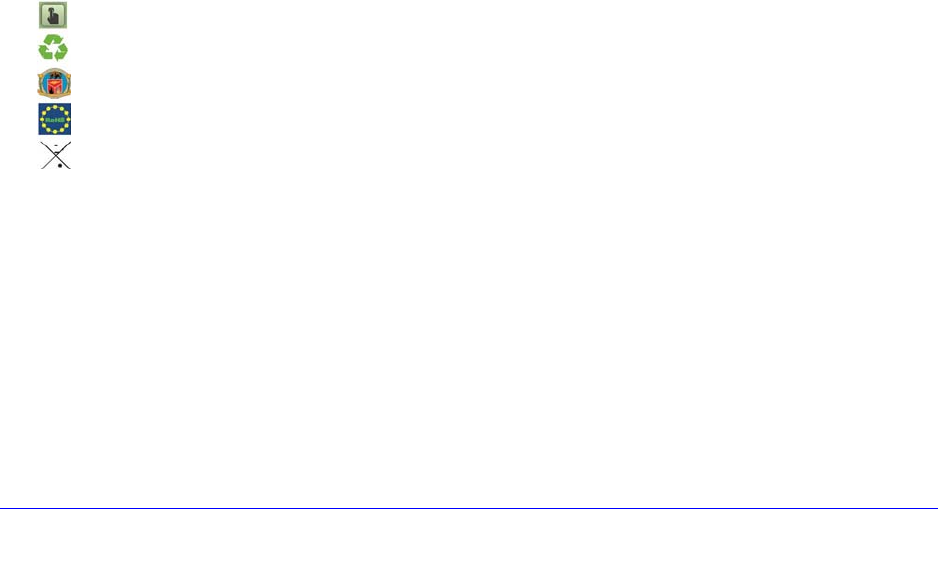
Hardware Setup
9
D6200 WiFi Modem Router
•Wi-Fi Protected Access® (WPA/WPA2-PSK) and WEP
•Double firewall protection (SPI and NAT firewall)
•Denial of service (DoS) attack prevention
Ease of Use
•Easy installation. Connect to computer and open your browser to install
•Push 'N' Connect using Wi-Fi Protected Setup® (WPS)
Physical Specifications
•Dimensions: 205 x 255 x 77 mm (8.07 x 10.04 x 3.03 inches)
•Weight: 654g (1.44 lb)
Premium Features:
•ReadySHARE CLOUD. Access and share a USB hard drive remotely.
•ReadySHARE PRINTER. Wirelessly access and share a USB printer.
Advanced Features
•Live Parental Controls with flexible and customizable filter settings.
•Simultaneous dual band. 2.4 GHz and 5 GHz operation.
•Two (2) ports for ReadySHARE® USB storage access. Supports FAT16/32, NTFS
Read/Write.
•DLNA®. Stream media to DLNA media players.
•Multiple SSID guest networks (separate security and access restrictions).
•Broadband usage meter measures Internet usage.
•Power and Wi-Fi On/Off buttons.
NETGEAR Green Features
Power On/Off button
80% recycled packaging
CEC (California Efficiency)
RoHS
WEEE
If you did not set up your new modem router already using the installation guide that comes in
the box, this chapter walks you through the hardware setup. Chapter 3, NETGEAR genie BASIC
Settings, explains how to set up your Internet connection.
For more information about the topics covered in this manual, visit the support website at
http://support.netgear.com/general/contact/default.aspx.
This chapter contains the following sections:
•Unpack Your New Router
•Hardware Features

Hardware Setup
10
D6200 WiFi Modem Router
•Position Your Wireless Router
•ADSL Microfilters
•Cable Your D6200 WiFi Modem Router
•Verify the Cabling
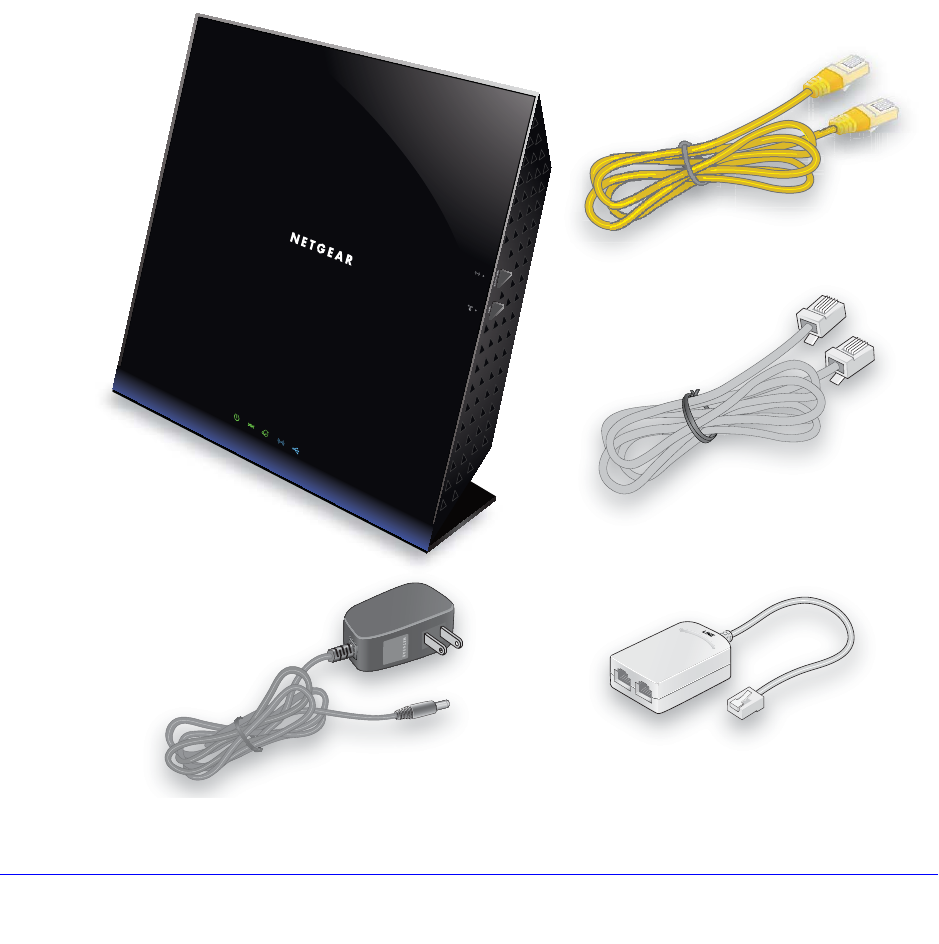
Hardware Setup
11
D6200 WiFi Modem Router
Unpack Your New Router
Your box should contain the following items:
•D6200 WiFi Modem Router
•AC power adapter (plug varies by region)
•Category 5 (Cat 5) Ethernet cable
•Telephone cable with RJ-11 connector
•Microfilters and splitters (quantity and type vary by region)
•Installation guide with cabling and router setup instructions
If any of the parts are incorrect, missing, or damaged, contact your NETGEAR dealer. Keep
the carton, including the original packing materials, in case you need to return the product for
repair. See Position Your Wireless Router on page 18 for information about where to place
and how to position your router.
Filter splitter
Ethernet cable
Power adapter
Telephone cable
D6200
Modem Router
The filter or splitter
provided depends
on the region.
Figure 1. Box contents
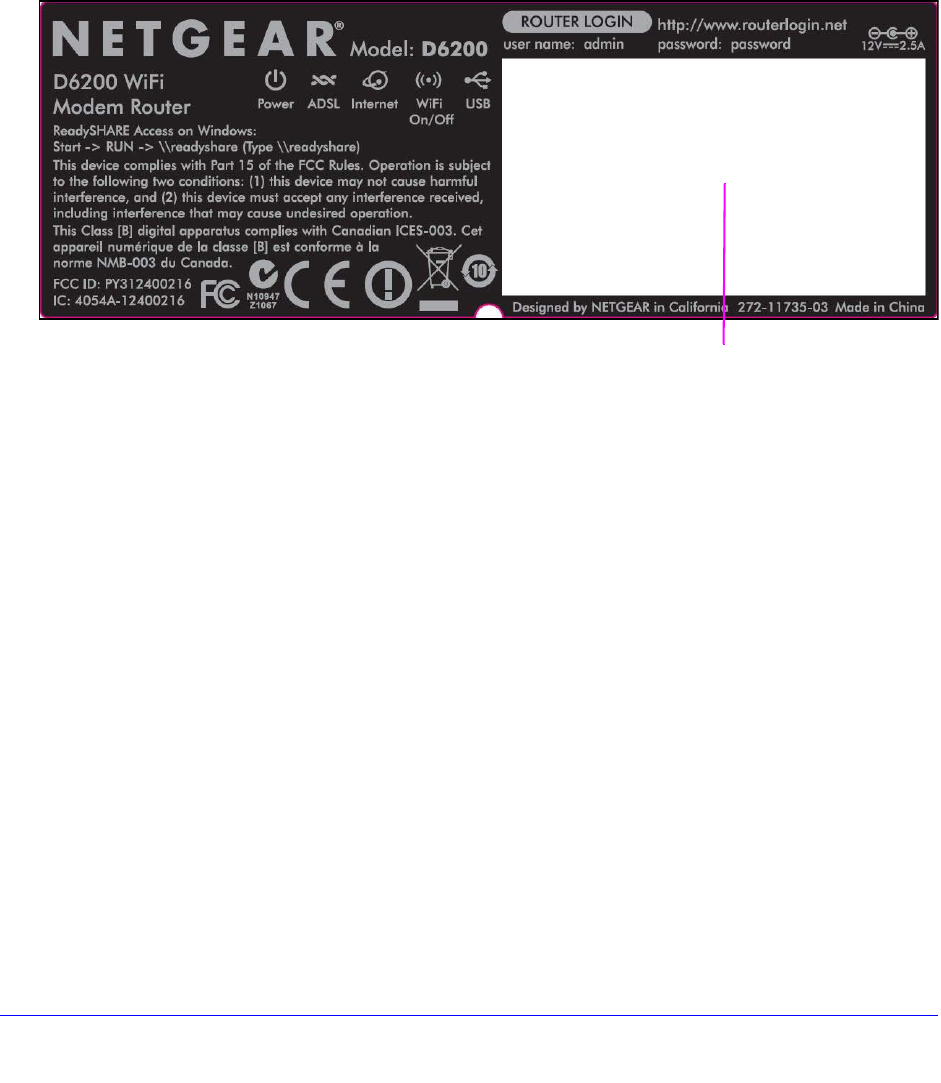
Hardware Setup
12
D6200 WiFi Modem Router
Hardware Features
Before you cable your router, take a moment to become familiar with the label and the front
and back panels. Pay particular attention to the LEDs on the front panel.
Label
The label on the bottom of the WiFi modem router shows the router’s WiFi network name
(SSID) and network key (password).
WiFi network name (SSID) and network key (password)
Figure 2. Label on router bottom
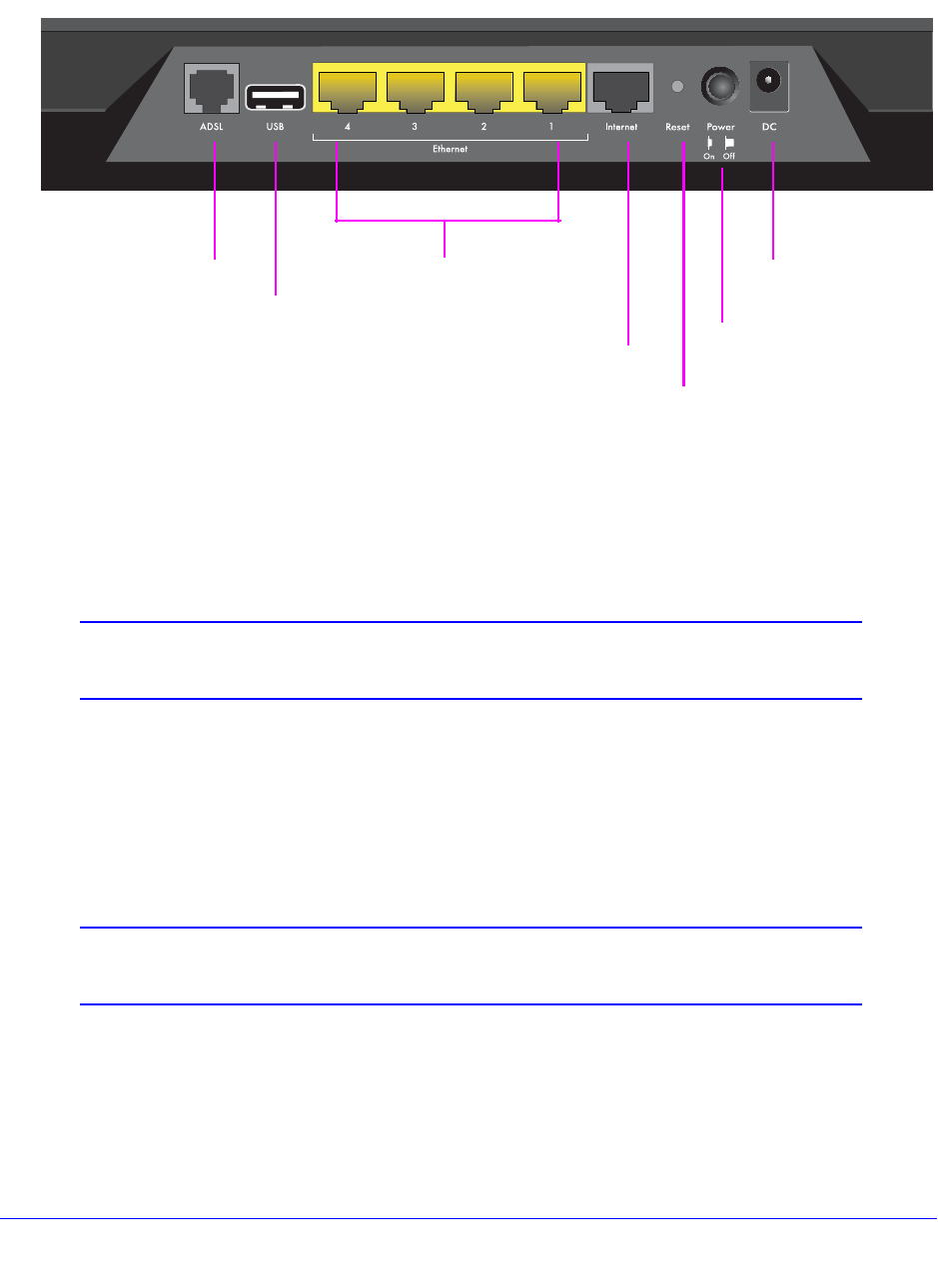
Hardware Setup
13
D6200 WiFi Modem Router
Back Panel
The back panel has the Power On/Off button and port connections shown in the figure:
4. Gigabit Ethernet
7. Power
1. ADSL line
6. AC power
2. USB port
3. Gigabit Ethernet
5. Reset button
On/Off button
adapter input
WAN port
LAN ports
Figure 3. Back panel port connections
Viewed from left to right, the back panel contains the following elements:
1. RJ-11 asynchronous DSL (ADSL) port for connecting the WiFi modem router to an
ADSL line
Note: An ADSL port can send data over an ADSL line at one speed and
receive it at another speed.
2. USB port for connecting USB storage devices like flash drives, hard drives, or USB printers
3. Four Gigabit Ethernet RJ-45 LAN ports for cabling the WiFi modem router to the local
computers
4. One Gigabit Ethernet WAN port for connecting the WiFi modem router to a fiber or cable
modem
Note: You can use either the ADSL or Gigabit Ethernet port for WAN
connectivity.
5. Reset button
See Factory Settings on page 141 for information about the Restore Factory Settings
button and the factory setting values.
6. Power On/Off button
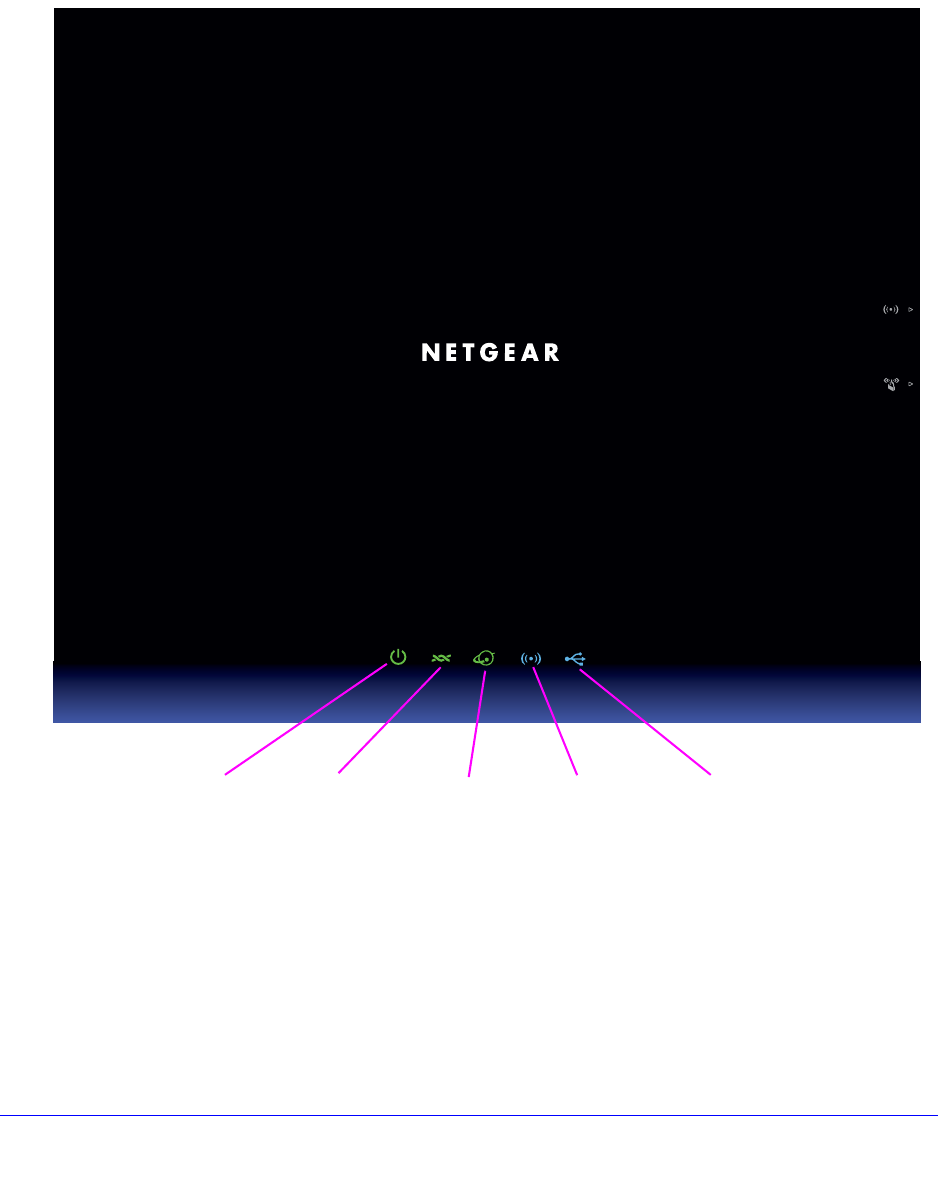
Hardware Setup
14
D6200 WiFi Modem Router
7. AC power adapter input
Front Panel
The WiFi modem router front panel has the 5 status LEDs, icons, and ports shown in the
figure.
Power DSL Internet Wireless USB
Figure 4. Front panel LEDs
The following tables describe the LEDs and icons on the front panel from left to right.
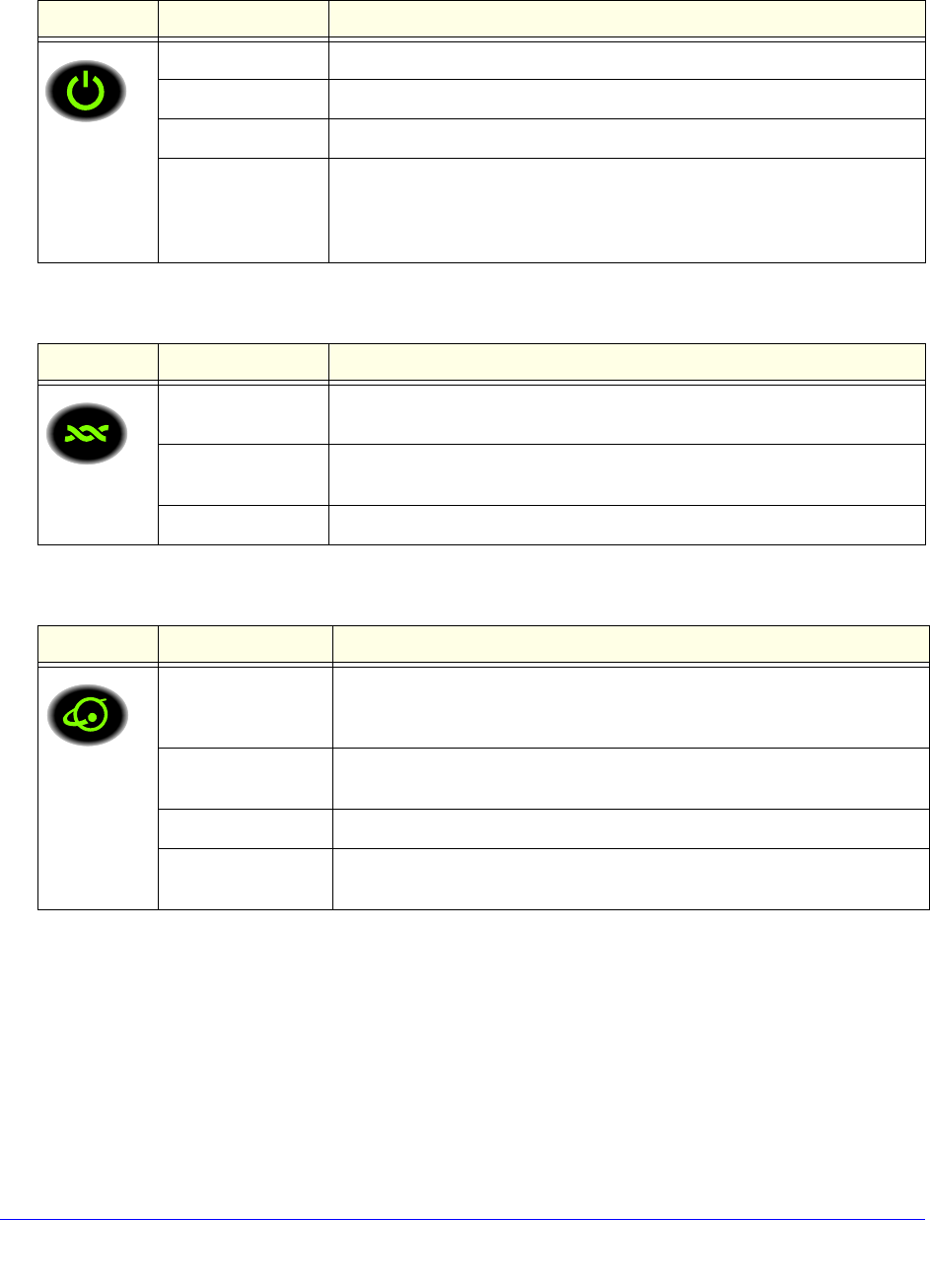
Table 1. Power On/Off LED
Icon LED Activity Description
Solid green Power is supplied to the router.
Solid red POST (power-on self-test) failure or a device malfunction occurred.
Off Power is not supplied to the router.
Restore Factory
Settings
LED blinks momentarily when the Restore Factory Settings button on the
bottom of the unit is pressed for 6 seconds. The Power LED then blinks red
three times when the Restore Factory Settings button is released and then
turns green as the gateway resets to the factory defaults.
Table 2. DSL LED
Icon LED Activity Description
Solid green You have an ADSL connection. In technical terms, the ADSL port is
synchronized with an ISP network-access device.
Blinking green Indicates that the WiFi modem router is negotiating the best possible
speed on the ADSL line.
Off The unit is off or has no ADSL connection.
Table 3. Internet LED
Icon LED Activity Description
Solid green You have an Internet connection. If this connection is dropped due to an
idle time-out but the connection is still present, the LED stays green. If the
Internet connection is dropped for any other reason, the LED turns off.
Solid red The Internet (IP) connection failed. See Cannot Access the Internet on
page 134 for troubleshooting information.
Blinking green Data is being transmitted over the Internet connection.
Off No Internet connection is detected or the device is in bridge mode (an
external device handles the ISP connection).
Hardware Setup
15
D6200 WiFi Modem Router
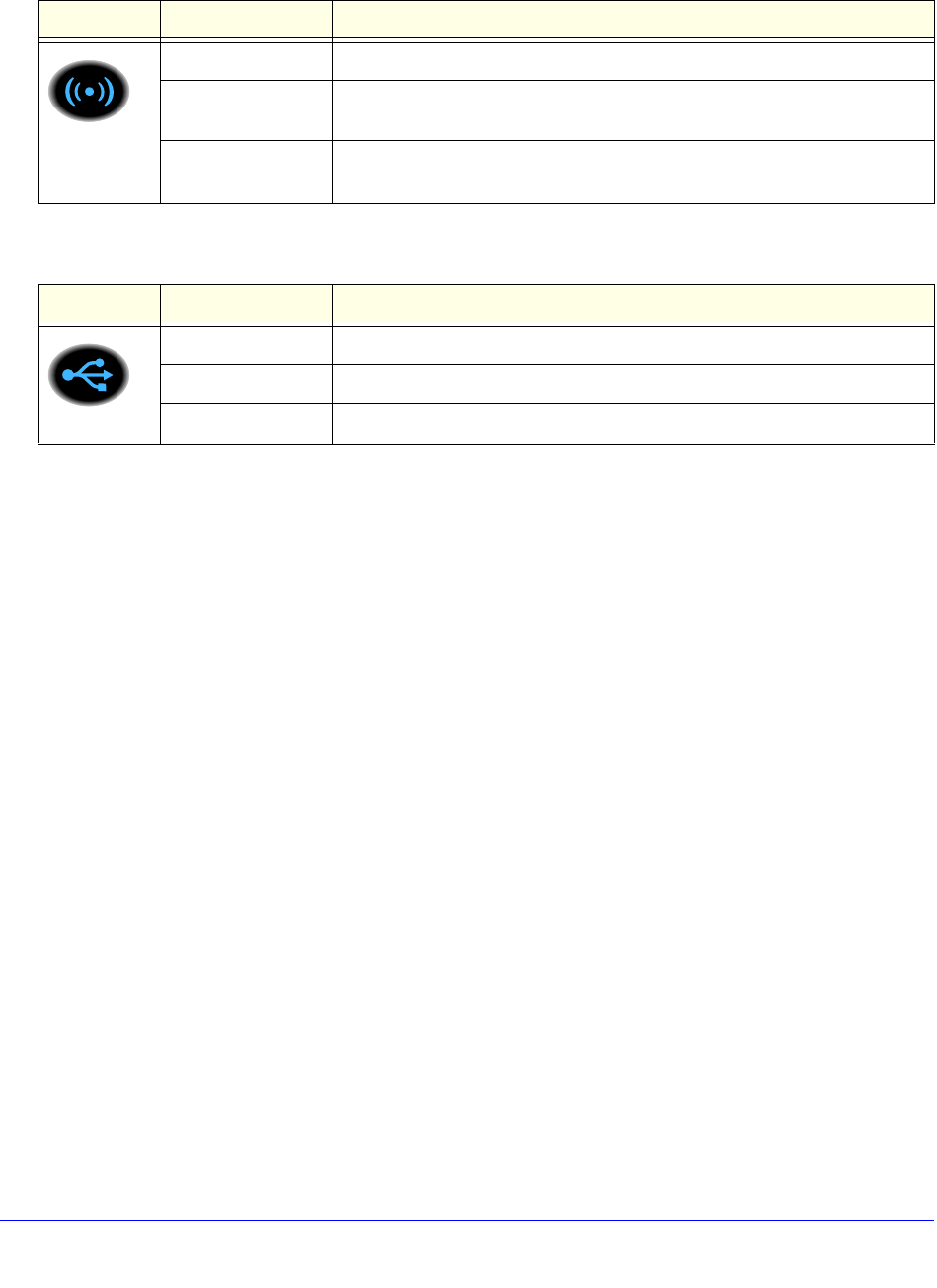
Table 4. Wireless LED
Icon LED Activity Description
Solid blue There is wireless connectivity.
Blinking blue Data is being transmitted or received over a wireless link or a
WPS-capable device is connecting to the device.
Off There is no wireless connectivity. You can still plug an Ethernet cable into
one of the LAN ports to get wired connectivity.
Table 5. USB LED
Icon LED Activity Description
Solid blue A USB port detected a USB device.
Blinking blue Data is being transmitted or received.
Off No link is detected on these ports.
Hardware Setup
16
D6200 WiFi Modem Router
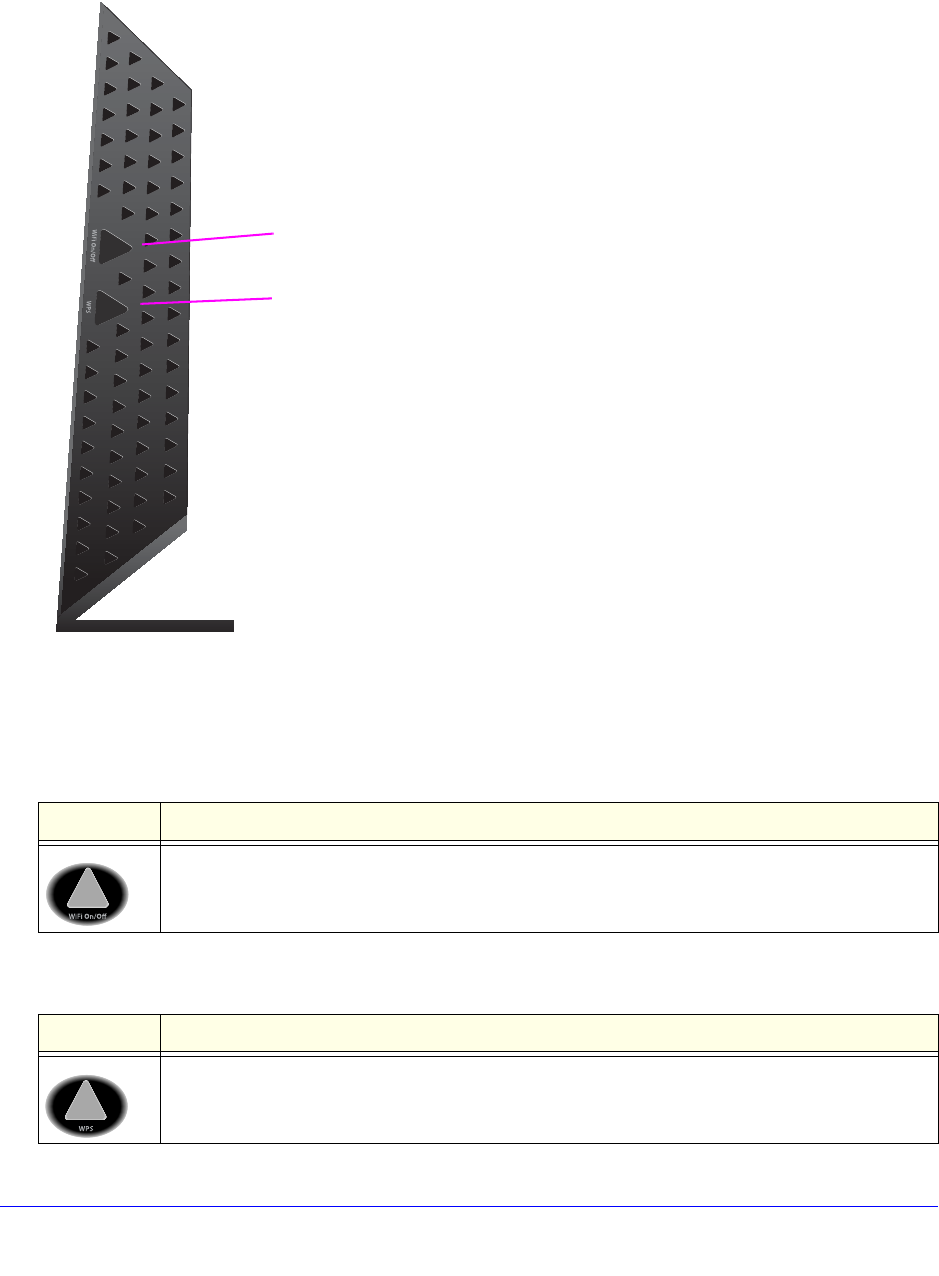
Hardware Setup
17
D6200 WiFi Modem Router
Side Panel
The WiFi modem router side panel has the port and buttons shown in the figure.
Wireless On/Off button
WPS On/Off button
Figure 5. Side panel buttons and port
The following tables describe the buttons and port on the side panel from top to bottom.
Table 6. Wireless button
Icon Description
For information about the use of this button, see Wireless Connectivity on page 137.
Table 7. WPS button
Icon Description
For information about the use of this button, see Wi-Fi Protected Setup (WPS) Method on
page 27.

Hardware Setup
18
D6200 WiFi Modem Router
Position Your Wireless Router
The WiFi modem router lets you access your network from anywhere within the operating
range of your wireless network. However, the operating distance or range of your wireless
connection can vary significantly depending on the physical placement of your router. For
example, the thickness and number of walls the wireless signal passes through can limit the
range. For best results, place your router:
•Near the center of the area where your computers and other devices operate and
preferably within line of sight to your wireless devices.
•So it is accessible to an AC power outlet and near Ethernet cables for wired computers.
•In an elevated location such as a high shelf, keeping the number of walls and ceilings
between the WiFi modem router and your other devices to a minimum.
•Away from electrical devices that are potential sources of interference, such as ceiling
fans, home security systems, microwaves, computers, or the base of a cordless phone or
2.4 GHz cordless phone.
•Away from any large metal surfaces, such as a solid metal door or aluminum studs. Large
expanses of other materials such as glass, insulated walls, fish tanks, mirrors, brick, and
concrete can also affect your wireless signal.
Note: The D6200 should be put in a vertical position only.
Also be aware that when you use multiple access points, it is better if adjacent access points
use different radio frequency channels to reduce interference. The recommended channel
spacing between adjacent access points is five channels (for example, use Channels 1 and
6, or 6 and 11).
ADSL Microfilters
If this installation is the first time you have cabled a wireless router between an ADSL phone
line and your computer or laptop, you might not be familiar with ADSL microfilters. If you are,
you can skip this section and proceed to Cable Your D6200 WiFi Modem Router on page 20.
An ADSL microfilter is a small inline device that filters ADSL interference out of standard
phone equipment that shares line with your ADSL service. Every telephone device that
connects to a telephone line that provides ADSL service needs an ADSL microfilter to filter
out the ADSL interference. Example devices are telephones, fax machines, answering
machines, and caller ID displays. Not every phone line in your home necessarily carries
ADSL service. That depends on the ADSL service setup in your home.
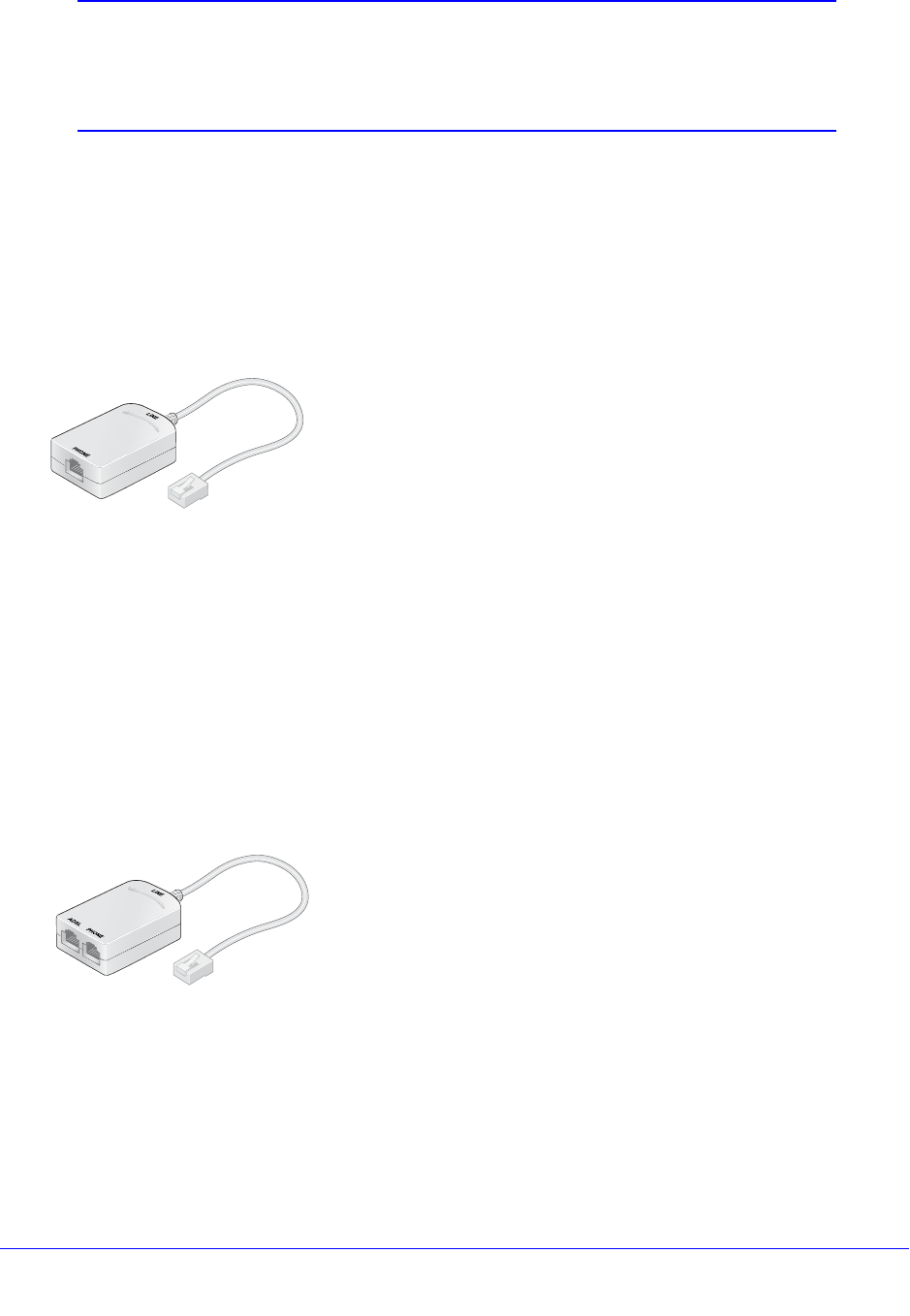
Hardware Setup
19
D6200 WiFi Modem Router
Note: Often the ADSL microfilter is included in the box with the wireless
modem router. If you purchased the WiFi modem router in a country
where a microfilter is not included, you have to acquire the ADSL
microfilter separately.
One-Line ADSL Microfilter (Not Included)
Plug the ADSL microfilter into the wall outlet and plug your phone equipment into the jack
labeled Phone. The wireless modem router plugs directly into a separate ADSL line. Plugging
the wireless modem router into the phone jack blocks the Internet connection. If you do not
have a separate ADSL line for the router, the best thing to do is to use an ADSL microfilter
with a built-in splitter.
Plugs into ADSL line
Figure 6. One-line ADSL microfilter
Second best when you do not have a separate ADSL line for the router is to get a separate
splitter. To use a one-line filter with a separate splitter, insert the splitter into the phone outlet,
connect the one-line filter to the splitter, and connect the phone to the filter.
Two-Line ADSL Microfilter (Included)
Use an ADSL microfilter with a built-in splitter when there is a single wall outlet that provides
connectivity for both the WiFi modem router and your telephone equipment. Plug the ADSL
microfilter into the wall outlet, plug your phone equipment into the jack labeled Phone, and
plug the wireless modem router into the jack labeled ADSL.
Plugs into the ADSL line
Figure 7. Two-line ADSL microfilter with built-in splitter
Summary
•One-line ADSL microfilter (not included). Use with a phone or fax machine.
•Splitter (not included). Use with a one-line ADSL microfilter to share an outlet with a
phone and the WiFi modem router.
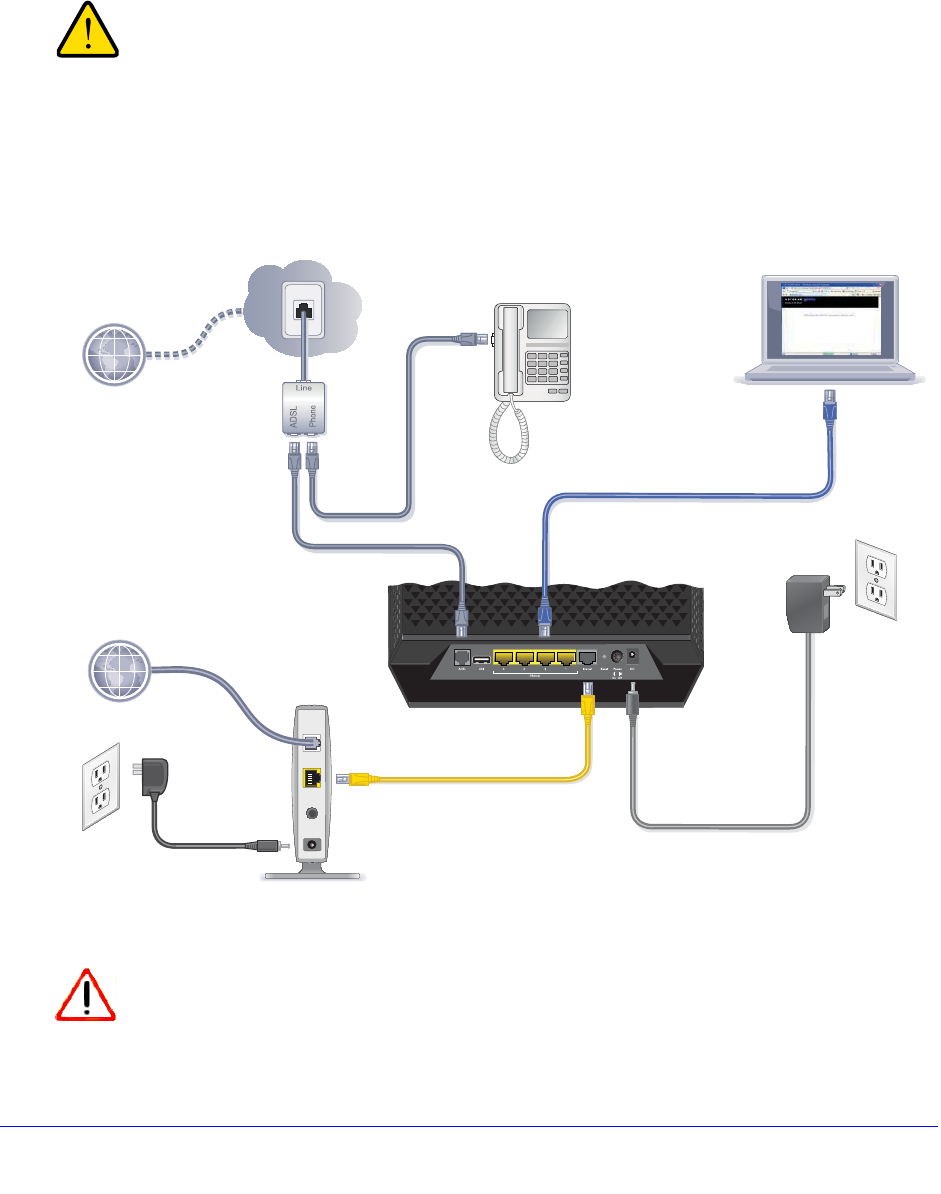
Hardware Setup
20
D6200 WiFi Modem Router
•Two-line ADSL microfilter with built-in splitter (included). Use to share an outlet with a
phone and the WiFi modem router.
Cable Your D6200 WiFi Modem Router
WARNING:
Do not stack equipment or place equipment in tight spaces, in
drawers, or on carpets. Be sure that your equipment is
surrounded by at least 2 inches of air space. The unit should not
be wall mounted.
The installation guide that came in the box has a cabling diagram on the second page.
1 ADSL or
cable fiber
modem
3 Power
2 Computer
4 Browser
Figure 8. Cabling diagram
CAUTION:
Incorrectly connecting a filter to your WiFi modem router blocks your ADSL
connection.

Hardware Setup
21
D6200 WiFi Modem Router
Verify the Cabling
Verify that your router is cabled correctly by checking the WiFi modem router LEDs. Turn on
the wireless router by pressing the Power On/Off button on the back.
•The Power LED is green when the modem router is turned on.
•The Wireless LED is lit when the modem router is turned on.
•The DSL LED is green when you have an ADSL connection.
•The Internet LED is green when an Internet connection exists.
Turn on your computer. If software usually logs you in to your Internet connection, do not run
that software. Cancel it if it starts automatically.

22
2
2. Get Started with NETGEAR genie
Connect to the WiFi modem router
This chapter explains how to use NETGEAR genie to set up your WiFi modem router after you
complete cabling as described in the installation guide and in the previous chapter in this book.
This chapter contains the following sections:
•Prepare to Set Up the WiFi Modem Router
•Types of Logins and Access
•NETGEAR genie Setup
•Use NETGEAR genie after Installation
•Upgrade WiFi Modem Router Firmware
•WiFi Modem Router Dashboard (BASIC Home Screen)
•Add Wireless Devices or Computers to Your Network

Get Started with NETGEAR genie
23
D6200 WiFi Modem Router
Prepare to Set Up the WiFi Modem Router
You can set up your WiFi modem router with the NETGEAR genie automatically, or you can
use the genie menus and screens to set up your WiFi modem router manually. However,
before you start the setup process, you need to have your ISP information about hand and
make sure the laptops, computers, and other devices in the network have the settings
described here.
Use Standard TCP/IP Properties for DHCP
If you set up your computer to use a static IP address, you need to change the settings so
that it uses Dynamic Host Configuration Protocol (DHCP).
Gather ISP Information
If you have DSL broadband service, you might need the following information to set up your
WiFi modem router and to check that your Internet configuration is correct. Your Internet
service provider (ISP) should have provided you with all of the information needed to connect
to the Internet. If you cannot locate this information, ask your ISP to provide it. When your
Internet connection is working, you no longer need to launch the ISP login program on your
computer to access the Internet. When you start an Internet application, your WiFi modem
router automatically logs you in.
•The ISP configuration information for your DSL account
•ISP login name and password
•Fixed or static IP address settings (special deployment by ISP; this situation is rare)
Wireless Devices and Security Settings
Make sure that the wireless device or computer that you are using supports WPA or WPA2
wireless security, which is the wireless security supported by the WiFi modem router. See
Basic Wireless Settings on page 35 for information about the WiFi modem router’s
preconfigured security settings.
Types of Logins and Access
Different types of logins have different purposes. It is important that you understand the
difference so that you know which login to use when.
•Wireless modem router login logs you in to the WiFi modem router interface from
NETGEAR genie. See Use NETGEAR genie after Installation on page 25 for details
about this login.

Get Started with NETGEAR genie
24
D6200 WiFi Modem Router
Wireless network key or password. Your WiFi modem router is preset with a unique
wireless network name (SSID) and password for wireless access. This information is on
the label on the bottom of your WiFi modem router.
•ISP login logs you in to your Internet service. Your service provider provided you with this
login information in a letter or some other way. If you cannot find this login information,
contact your service provider.
NETGEAR genie Setup
NETGEAR genie runs on any device with a web browser. It is the easiest way to set up the
WiFi modem router because it automates many of the steps and verifies that those steps
have been successfully completed. It takes about 15 minutes to complete.
To use NETGEAR genie to set up your WiFi modem router:
1. Turn the WiFi modem router on by pressing the On/Off button, if not done yet.
2. Make sure that your device is connected with an Ethernet cable to your WiFi modem router.
3. Launch your Internet browser.
•If this installation is the first time you are setting up the Internet connection for your
WiFi modem router, the browser automatically goes to http://www.routerlogin.net, and
the NETGEAR genie screen displays.
•If you already used the NETGEAR genie, type http://www.routerlogin.net in the
address field for your browser to display the NETGEAR genie screen. See Use
NETGEAR genie after Installation on page 25.
4. Follow the onscreen instructions to complete NETGEAR genie setup. NETGEAR genie
guides you through connecting the WiFi modem router to the Internet.
If the browser cannot display the web page:
•Make sure that the computer is connected to one of the 4 Gigabit Ethernet LAN ports, or
wirelessly to the WiFi modem router.
•Make sure that the WiFi modem router is ready. Its Wireless LEDs should light.
•Close and reopen the browser to make sure that the browser does not cache the previous
page.
•Browse to http://routerlogin.net.
•If your computer is set to a static or fixed IP address (this situation is uncommon), change
the setting to obtain an IP address automatically from the WiFi modem router.
If the WiFi modem router does not connect to the Internet:
1. Review your settings to be sure that you selected the correct options and typed
everything correctly.
2. Contact your ISP to verify that you have the correct configuration information.
3. Read Chapter 10, Troubleshooting. If problems persist, register your NETGEAR product and
contact NETGEAR technical support.
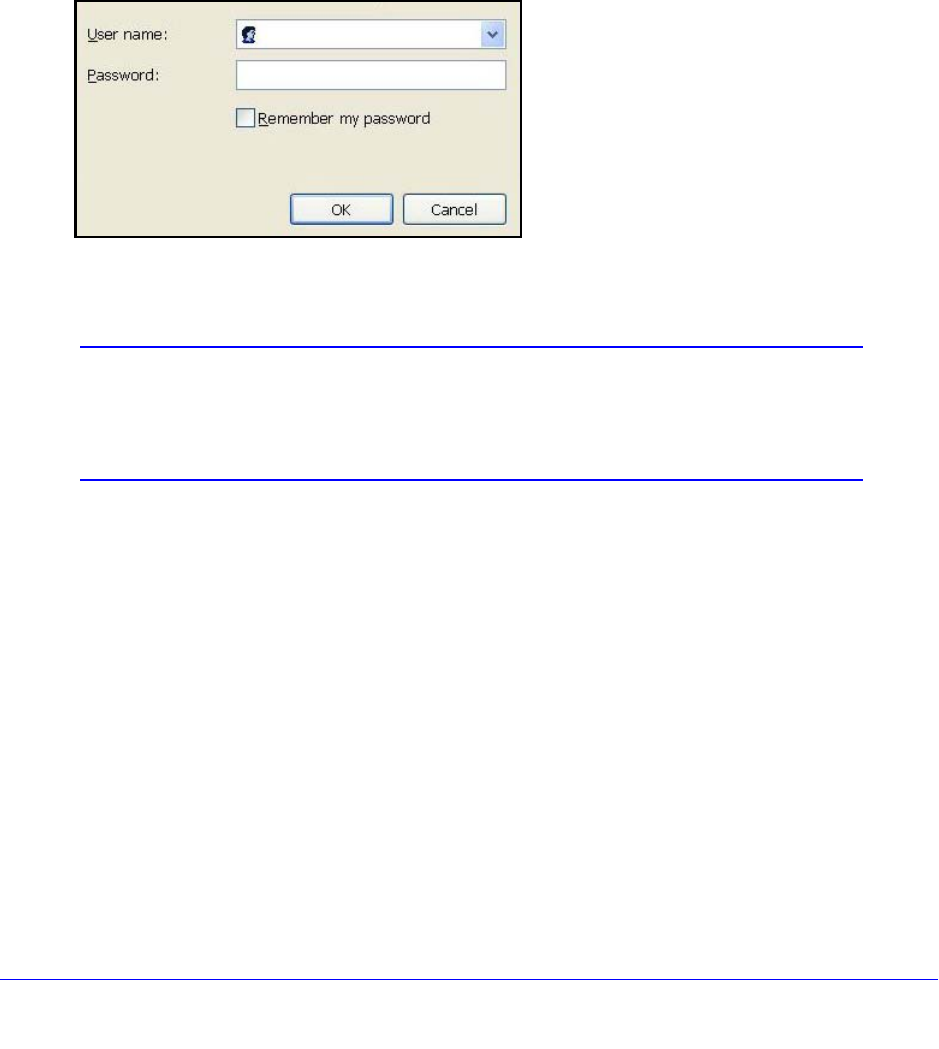
Get Started with NETGEAR genie
25
D6200 WiFi Modem Router
Use NETGEAR genie after Installation
When you first set up your WiFi modem router, NETGEAR genie automatically starts when
you launch an Internet browser on a computer that is connected to the WiFi modem router.
You can use NETGEAR genie again if you want to view or change settings for the WiFi
modem router.
1. Launch your browser from a computer or wireless device that is connected to the WiFi
modem router.
2. Enter http://www.routerlogin.net in the web browser address bar.
A login window displays.
admin
********
3. Enter admin for the WiFi modem router user name and password for the WiFi modem
router password, both in lowercase letters.
Note: The WiFi modem router user name and password are different from
the user name and password for logging in to your Internet
connection. See Types of Logins and Access on page 23 for more
information.
Upgrade WiFi Modem Router Firmware
When you set up your WiFi modem router and are connected to the Internet, the WiFi
modem router automatically checks for you to see if newer firmware is available. If it is, a
message is displayed on the top of the screen. See Upgrade the WiFi Modem Router
Firmware on page 85 for more information about upgrading firmware.
Click the message when it shows up, and click Yes to upgrade the WiFi modem router with
the latest firmware. After the upgrade, the WiFi modem router restarts.
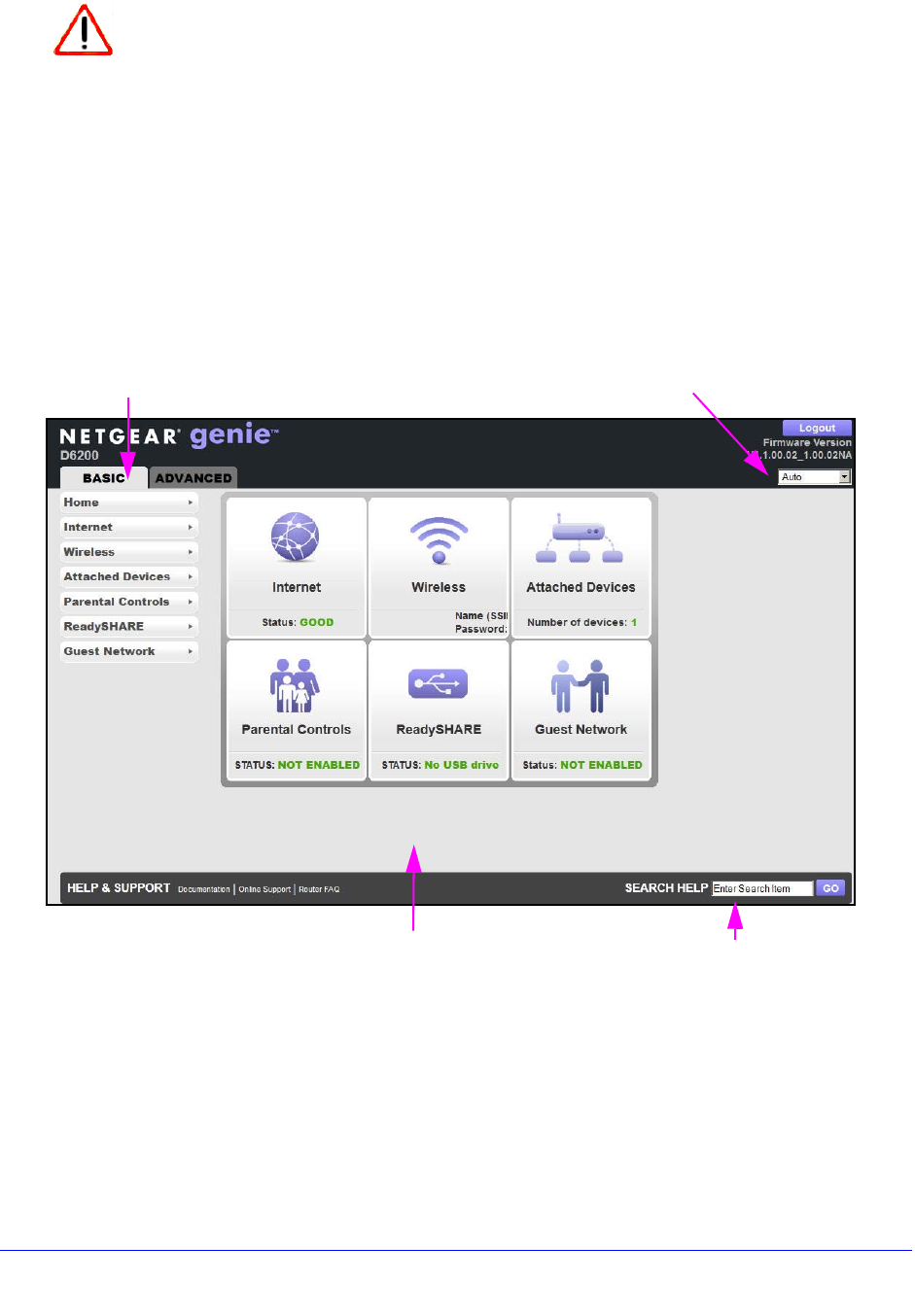
Get Started with NETGEAR genie
26
D6200 WiFi Modem Router
CAUTION:
Do not try to go online, turn off the WiFi modem router, shut down the
computer, or do anything else to the WiFi modem router until the WiFi
modem router finishes restarting and the Power LED has stopped blinking
for several seconds.
WiFi Modem Router Dashboard (BASIC Home Screen)
The WiFi modem router BASIC Home screen has a dashboard that lets you see the status of
your Internet connection and network at a glance. You can click any of the six sections of the
dashboard to view more detailed information. Menus are on the left, and the Advanced tab
that is used to access additional menus and screens is at the top.
Language
Help
Dashboard (Click to view details)
Menus (Click the Advanced tab to view more)
Figure 9. Wireless modem router BASIC Home screen with dashboard, language, and online
help
•Home. This dashboard screen displays when you log in to the WiFi modem router.
•Internet. Set, update, and check the ISP settings of your WiFi modem router.
•Wireless. View or change the wireless settings for your WiFi modem router.
•Attached Devices. View the devices connected to your network.
•Parental Controls. Download and set up parental controls to prevent objectionable
content from reaching your computers.

Get Started with NETGEAR genie
27
D6200 WiFi Modem Router
•ReadySHARE. If you connected a USB storage device to the WiFi modem router, then it
is displayed here.
•Guest Network. Set up a guest network to allow visitors to use your WiFi modem router’s
Internet connection.
•Advanced tab. Set the WiFi modem router up for unique situations such as when remote
access by IP or by domain name from the Internet is needed. See Chapter 9, Advanced
Settings. Using this tab requires a solid understanding of networking concepts.
•Help & Support. Go to the NETGEAR support site to get information, help, and product
documentation. These links work after you have an Internet connection.
Add Wireless Devices or Computers to Your Network
Choose either the manual or the WPS method to add wireless devices and other equipment
to your wireless network. See Guest Networks on page 38 for instructions for how to set up a
guest network.
Manual Method
To connect manually:
1. Open the software that manages your wireless connections on the wireless device
(laptop computer, gaming device, iPhone) that you want to connect to your WiFi modem
router. The wireless software scans for all wireless networks in your area.
2. Look for your network and select it. If you did not change the name of your network during
the setup process, look for the default WiFi Network Name (SSID) and select it. The default
SSID is on the product label on the bottom of the WiFi modem router.
3. Enter the WiFi modem router password and click Connect. The default WiFi modem router
passphrase is on the product label on the bottom of the WiFi modem router.
4. Repeat steps 1–3 to add other wireless devices.
Wi-Fi Protected Setup (WPS) Method
Wi-Fi Protected Setup (WPS) is a standard for easily adding computers and other devices to
a home network while maintaining security. To use WPS, make sure that all wireless devices
to be connected to the network are Wi-Fi certified and support WPS. During the connection
process, the client gets the security settings from the WiFi modem router so that every device
in the network has the same security settings.
If your wireless device supports WPS (Push 'N' Connect), use the following procedure.
To use WPS to join the wireless network:
1. Press the WPS button on the WiFi modem router top panel.
2. Within 2 minutes, press the WPS button on your wireless device or follow the WPS
instructions that came with the device. The device is now connected to your WiFi modem
router.

Get Started with NETGEAR genie
28
D6200 WiFi Modem Router
3. Repeat steps 1–2 to add other WPS wireless devices.
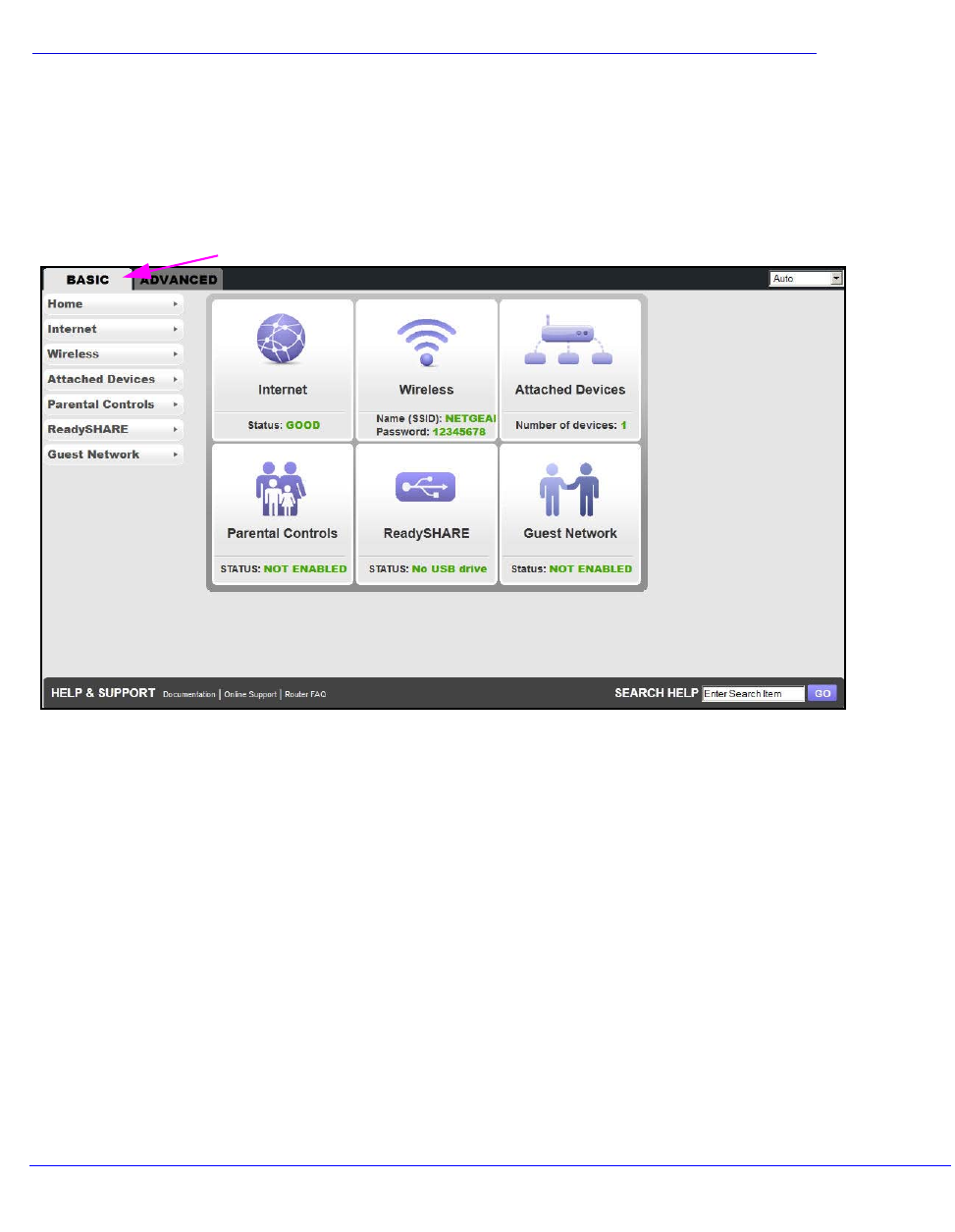
29
3
3. NETGEAR genie BASIC Settings
Your Internet connection and network
This chapter explains the features available from the NETGEAR genie BASIC Home screen,
shown in the following figure:
This chapter contains the following sections:
•Internet Basic Settings
•Attached Devices
•Parental Controls
•ReadySHARE USB Storage and Printer
•Basic Wireless Settings
•Guest Networks
•NETGEAR genie App
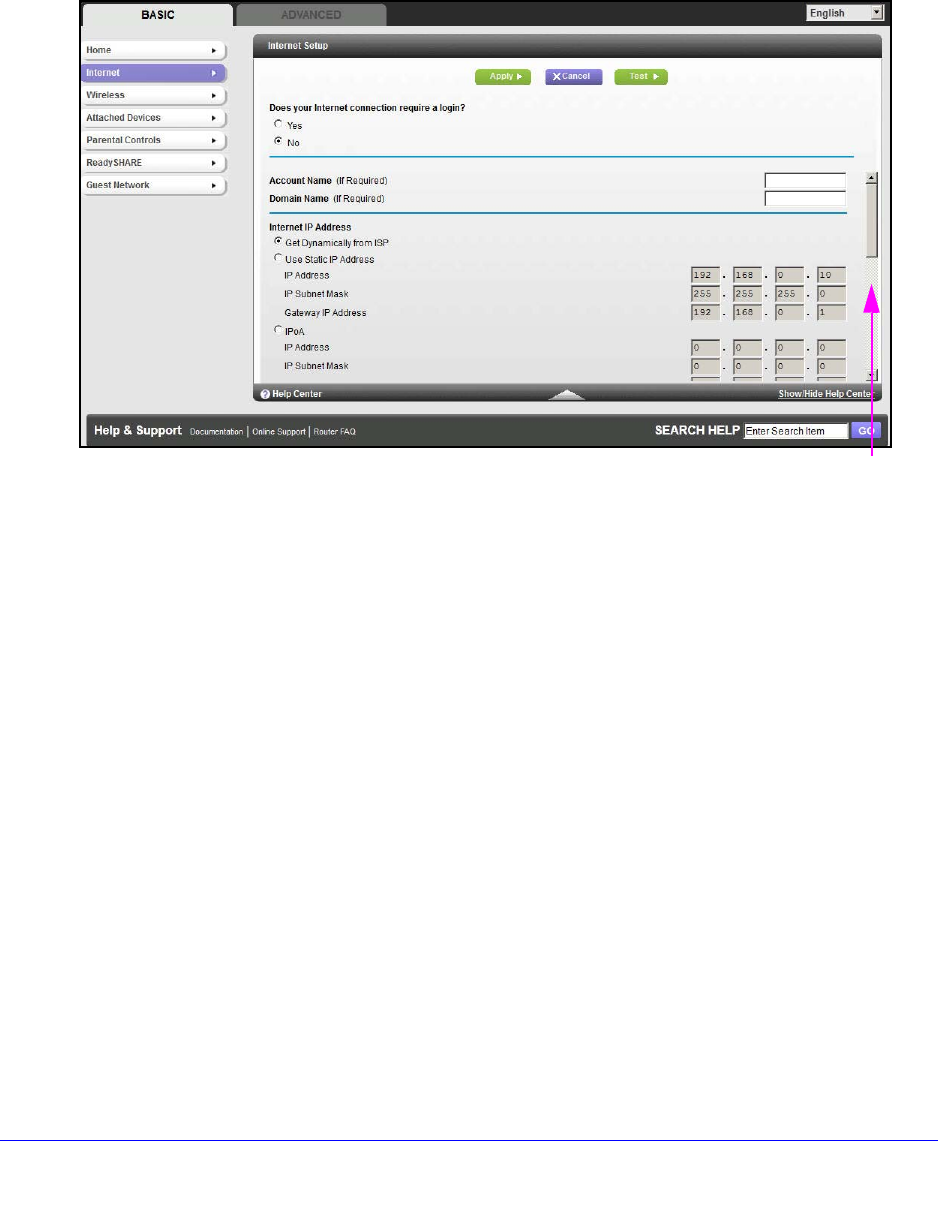
NETGEAR genie BASIC Settings
30
D6200 WiFi Modem Router
Internet Basic Settings
The Internet Basic Settings screen is where you view or change ISP information.
1. From the BASIC Home screen, select Internet. The following screen displays:
Scroll to view more settings
D6200
The fields that display in the Internet Basic Settings screen depend on whether your
Internet connection requires a login.
•Yes. Select the encapsulation method and enter the login name. If you want to
change the login time-out, enter a new value in minutes.
•No. Enter the account and domain names, only if needed.
2. Enter the settings for the IP address and DNS server. The default settings usually work fine.
If you have problems with your connection, check the ISP settings.
3. Click Apply to save your settings.
4. Click Test to test your Internet connection. If the NETGEAR website does not display within
1 minute, see Chapter 10, Troubleshooting.
Internet Basic Settings Screen Fields
The following descriptions explain all of the possible fields in the Internet Basic Settings
screen. Which fields display in this screen depends on whether an ISP login is required.
Does Your ISP Require a Login? Answer either yes or no.
These fields display when no login is required:
•Account Name (If Required). Enter the account name provided by your ISP. This name
might also be called the host name.

NETGEAR genie BASIC Settings
31
D6200 WiFi Modem Router
•Domain Name (If required). Enter the domain name provided by your ISP.
These fields display when your ISP requires a login:
•Internet Service Provider Encapsulation. ISP types. The choices are PPPoE or
PPPoA.
•Login. The login name provided by your ISP. This name is often an email address.
•Password. The password that you use to log in to your ISP.
•Idle Timeout (In minutes). If you want to change the login time-out, enter a new value in
minutes. This setting determines how long the WiFi modem router keeps the Internet
connection active after no Internet activity from the LAN. Entering a value of 0 (zero)
means never log out.
Internet IP Address.
•Get Dynamically from ISP. Your ISP uses DHCP to assign your IP address. Your ISP
automatically assigns these addresses.
•Use Static IP Address. Enter the IP address, IP subnet mask, and the gateway IP
address that your ISP assigned. The gateway is the ISP WiFi modem router to which
your WiFi modem router connects.
Domain Name Server (DNS) Address. The DNS server is used to look up site addresses
based on their names.
•Get Automatically from ISP. Your ISP uses DHCP to assign your DNS servers. Your ISP
automatically assigns this address.
•Use These DNS Servers. If you know that your ISP does not automatically transmit DNS
addresses to the WiFi modem router during login, select this option, and enter the IP
address of your ISP primary DNS server. If a secondary DNS server address is available,
enter it also.
WiFi Modem Router MAC Address. The Ethernet MAC address used by the WiFi modem
router on the Internet port. Some ISPs register the MAC address of the network interface
card in your computer when your account is first opened. They then accept traffic only from
the MAC address of that computer. This feature allows your WiFi modem router to use your
computer’s MAC address (this procedure is also called cloning).
•Use Default Address. Use the default MAC address.
•Use Computer MAC Address. The WiFi modem router captures and use the MAC
address of the computer that you are now using. You have to use the one computer that
the ISP allows.
•Use This MAC Address. Enter the MAC address that you want to use.
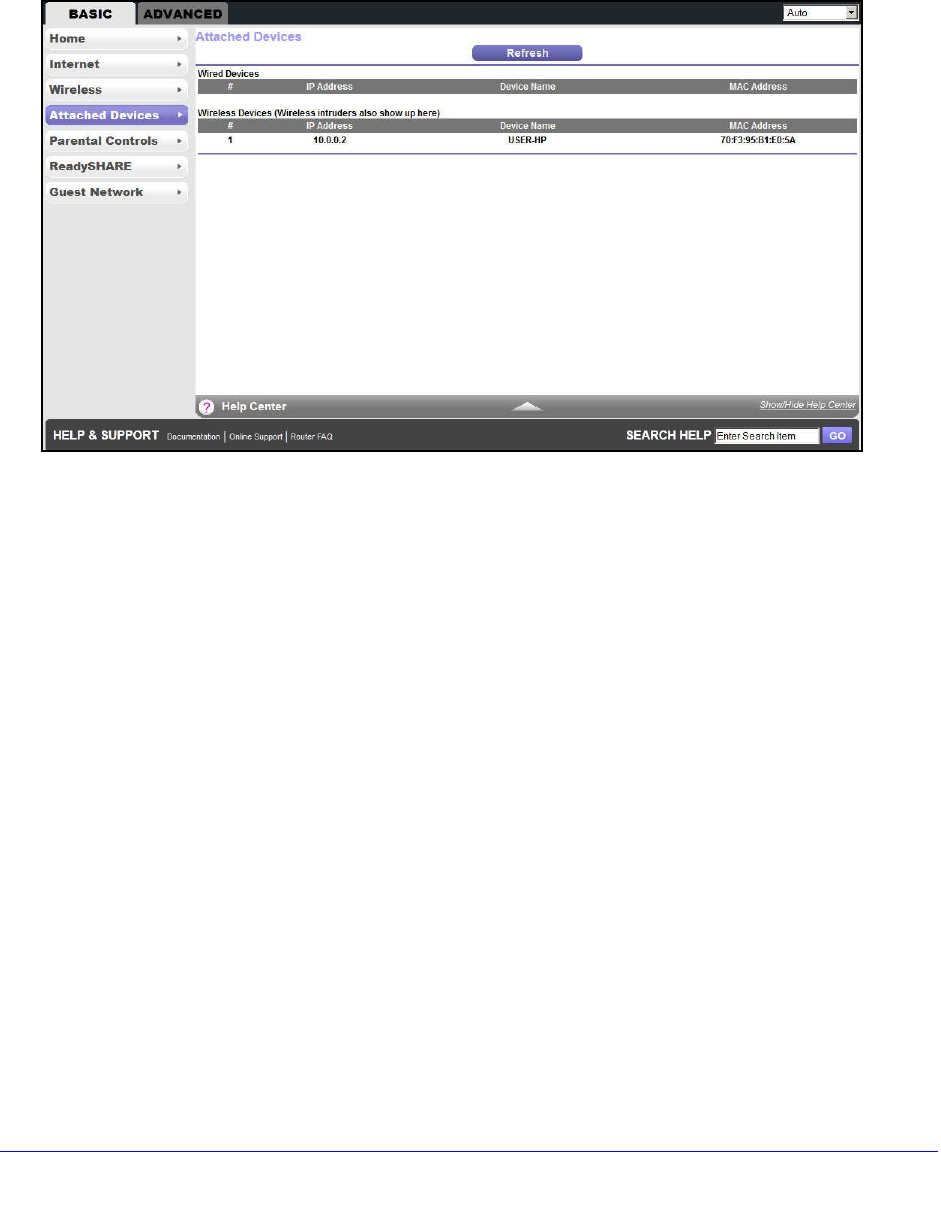
NETGEAR genie BASIC Settings
32
D6200 WiFi Modem Router
Attached Devices
You can view all computers or devices that are currently connected to your network here.
From the Basic Home screen, select Attached Devices to display the following screen:
Wired devices are connected to the WiFi modem router with Ethernet cables. Wireless
devices have joined the wireless network.
•# (number). The order in which the device joined the network.
•IP Address. The IP address that the WiFi modem router assigned to this device when it
joined the network. This number can change when a device is disconnected and rejoins
the network.
•Device Name. If the device name is known, it is shown here.
•MAC Address. The unique MAC address for each device does not change. The MAC
address is typically shown on the product label.
You can click Refresh to update this screen.
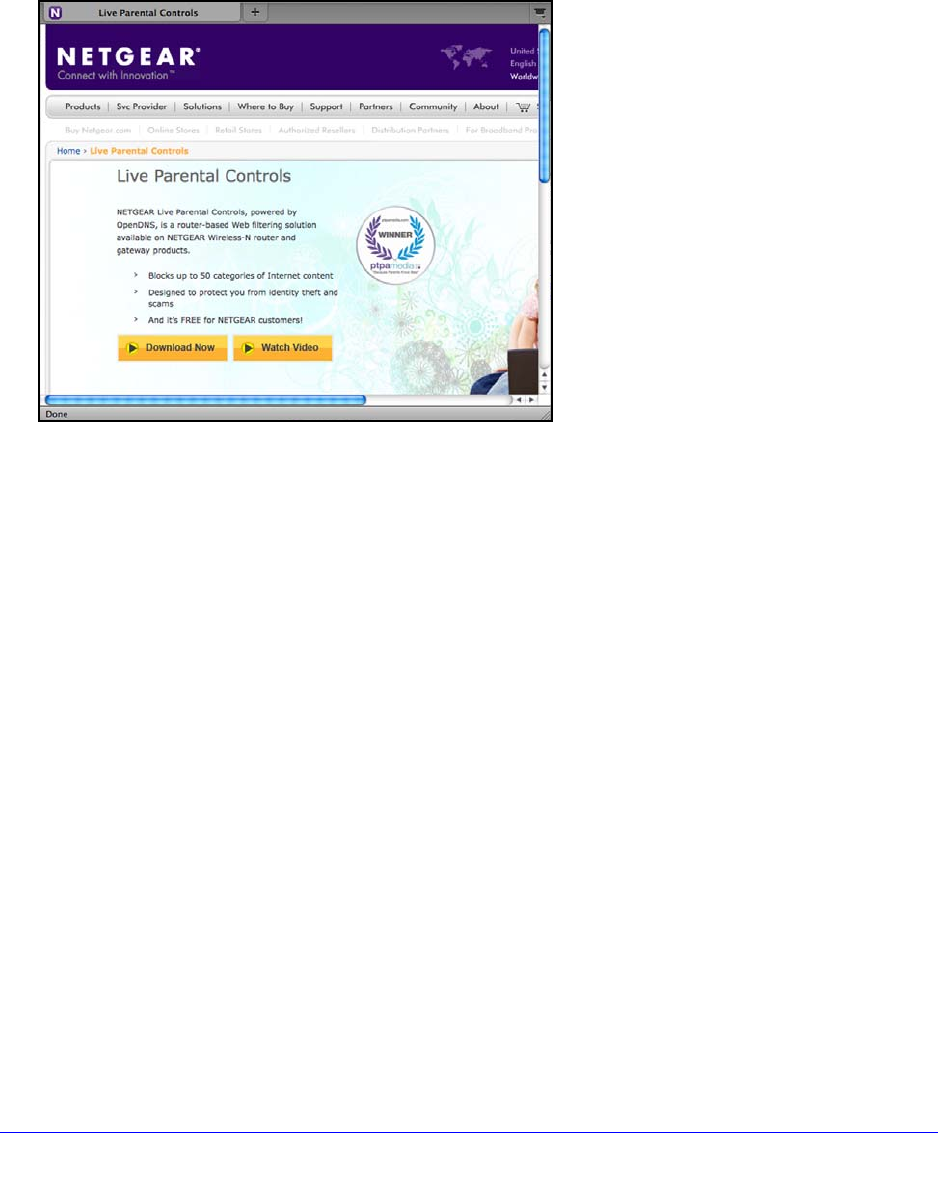
NETGEAR genie BASIC Settings
33
D6200 WiFi Modem Router
Parental Controls
The first time you select Parental Controls from the BASIC Home screen, you are
automatically directed to the Internet, where you can learn more about Live Parental Controls
or download the application. The following screen displays:
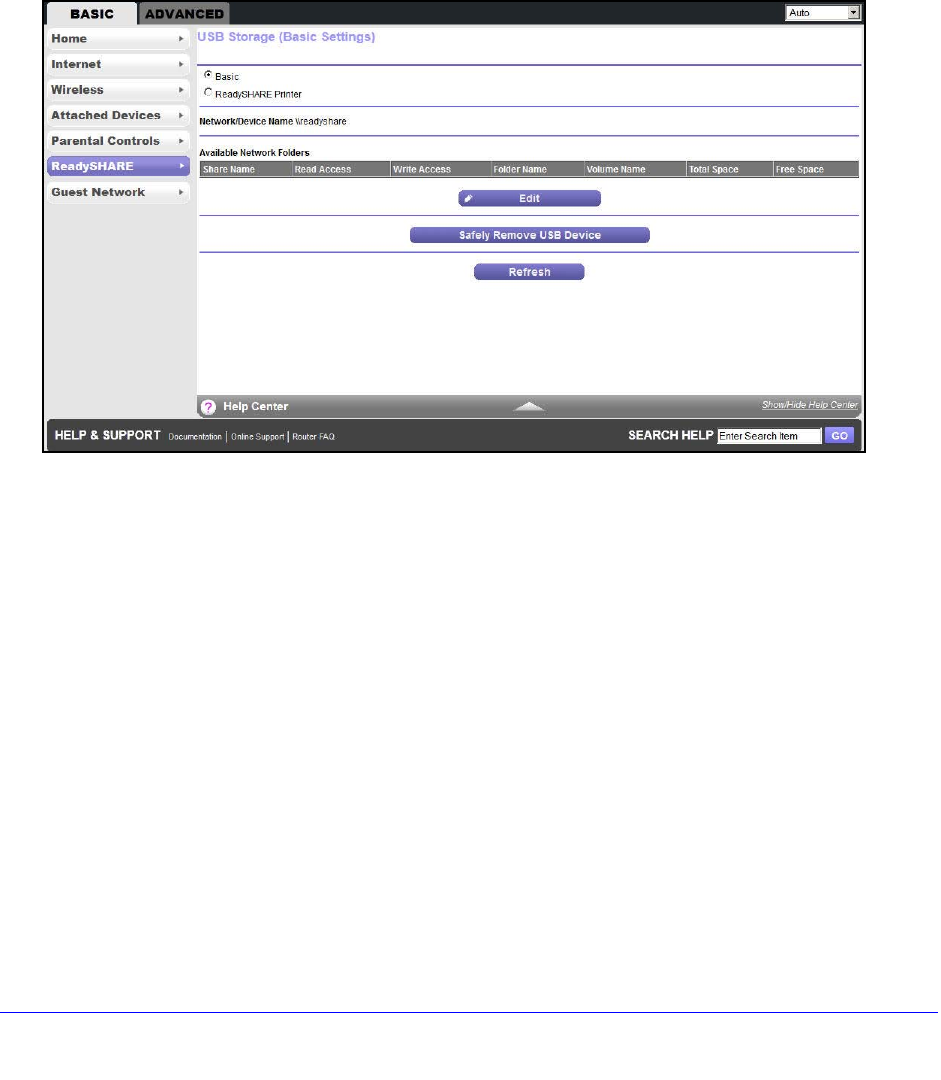
NETGEAR genie BASIC Settings
34
D6200 WiFi Modem Router
ReadySHARE USB Storage and Printer
You can view information about a USB storage device that is connected to the WiFi modem
router’s USB port here.
USB Storage (Basic Settings)
From the Basic Home screen, select ReadySHARE to display the USB Storage (Basic
Settings) screen:
This screen displays the following when Basic is selected:
•Network/Device Name. The default is \\readyshare. This name is the name used to
access the USB device connected to the WiFi modem router.
•Available Network Folders. The folders on the USB device.
Share Name. If only one device is connected, the default share name is USB_Storage.
You can click the name shown, or you can type it in the address field of your web browser.
If Not Shared is shown, the default share was deleted and no other share for the root
folder exists. Click the link to change this setting.
Read Access and Write Access. Show the permissions and access controls on the
network folder: All – no password (the default) allows all users to access the network
folder. The user name (account name) for All – no password is guest. The password for
admin is the same one that you use to log in to the WiFi modem router. By default, it is
password.
Folder Name. Full path used by the network folder.
Volume Name. Volume name from the storage device (either USB drive or HDD).
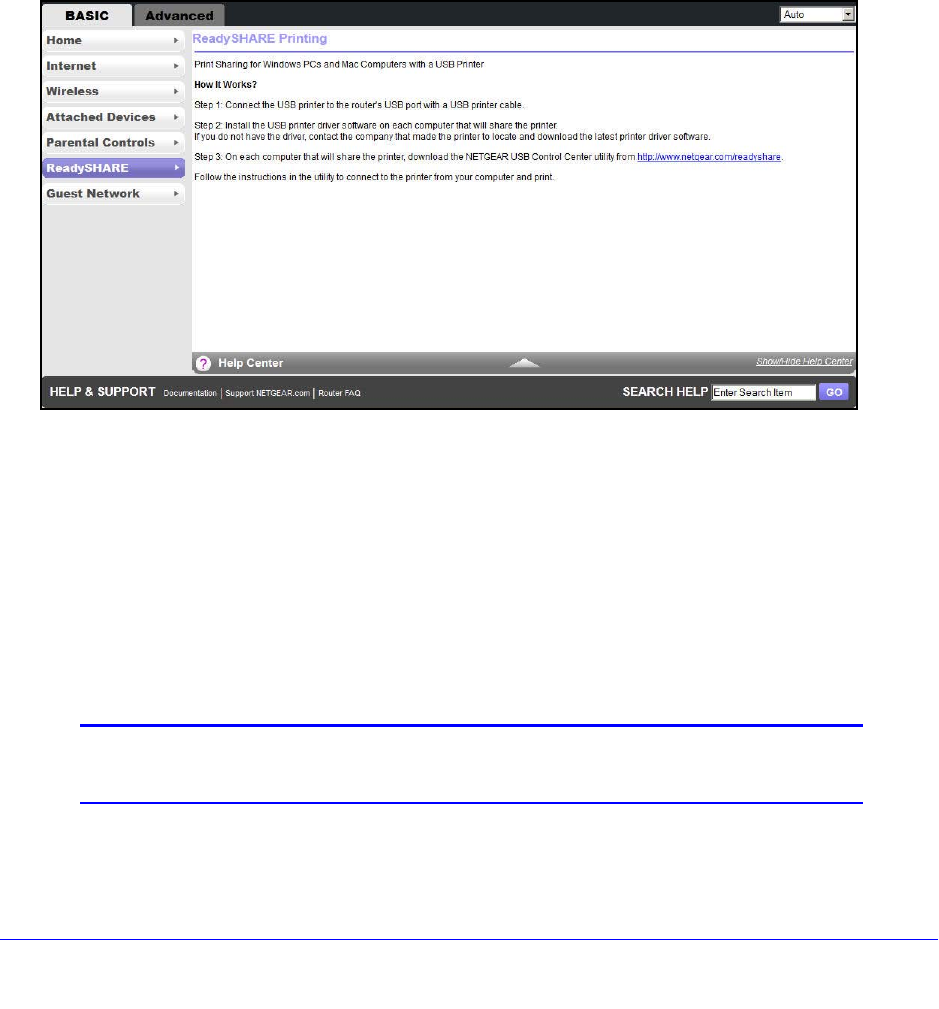
NETGEAR genie BASIC Settings
35
D6200 WiFi Modem Router
Total Space and Free Space. Show the current utilization of the storage device.
•Edit. Click the Edit button to edit the Available Network Folders settings.
•Safely Remove a USB Device. Click to safely remove the USB device attached to your
WiFi modem router.
You can click Refresh to update this screen.
For more information about USB storage, see Chapter 5, USB Storage.
ReadySHARE Printer
From the BASIC Home screen, select ReadySHARE, and from the USB Storage (Basic
Settings) screen, select ReadySHARE Printer to display the following screen:
For more information about USB printing, see Chapter 6, USB Printer Control.
Basic Wireless Settings
The Wireless Settings screen lets you view or configure the wireless network setup.
The WiFi Modem Router comes with preset security. This means that the WiFi network name
(SSID), network key (password), and security option (encryption protocol) are preset in the
factory. You can find the preset SSID and password on the bottom of the unit.
Note: The preset SSID and password are uniquely generated for every
device to protect and maximize your wireless security.
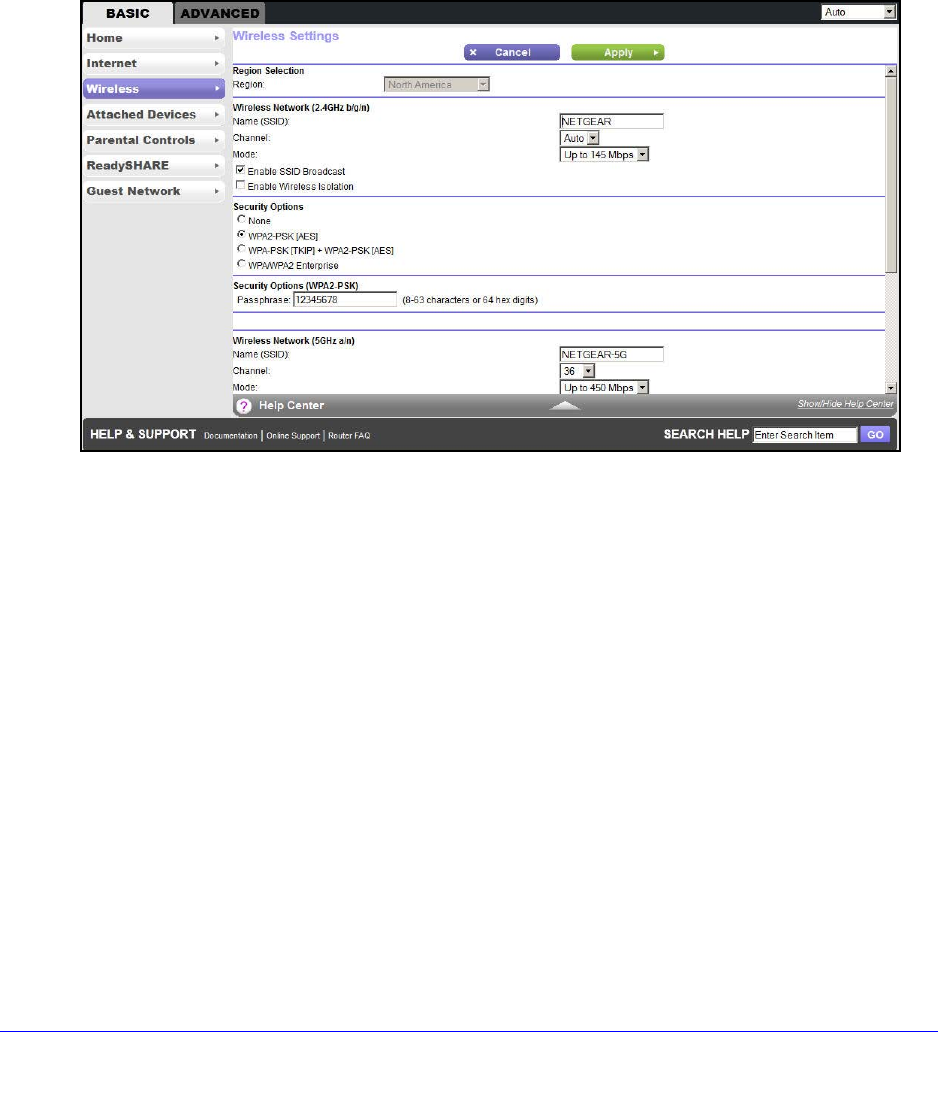
NETGEAR genie BASIC Settings
36
D6200 WiFi Modem Router
NETGEAR recommends that you do not change your preset security settings. If you do
decide to change your preset security settings, make a note of the new settings and store it in
a safe place where you can easily find it.
If you use a wireless computer to change the wireless network name (SSID) or other wireless
security settings, you are disconnected when you click Apply. To avoid this problem, use a
computer with a wired connection to access the WiFi modem router.
To view or change basic wireless settings:
1. On the Basic Home screen, select Wireless to display the Wireless Settings screen.
The screen sections, settings, and procedures are explained in the following sections.
2. Make any necessary changes, and click Apply to save your settings.
3. Set up and test your wireless devices and computers to make sure that they can connect
wirelessly. If they do not, check the following:
•Is your wireless device or computer connected to your network or another wireless
network in your area? Some wireless devices automatically connect to the first open
network (without wireless security) that they discover.
•Does your wireless device or computer show up on the Attached Devices screen? If it
does, then it is connected to the network.
•If you are not sure what the network name (SSID) or password is, look on the label on
the bottom of your WiFi modem router.
Wireless Settings Screen Fields
Region. The location where the WiFi modem router is used. Select from the countries in the
list. In the United States, the region is fixed to United States and is not changeable.

NETGEAR genie BASIC Settings
37
D6200 WiFi Modem Router
Wireless Network
Note: These settings apply separately to the 2.4 GHz b/g/n and 5 GHz a/n
bands.
Name (SSID). The SSID is also known as the wireless network name. Enter a 32-character
(maximum) name in this field. This field is case-sensitive. The default SSID is randomly
generated, and NETGEAR strongly recommends that you do not change this setting.
Channel. This setting is the wireless channel used by the gateway. Enter a value from 1
through 13. For products in the North America market, only channels 1 through 11 can be
operated. Do not change the channel unless you experience interference (when indicated by
lost connections or slow data transfers). If this interference happens, experiment with
different channels to see which is the best.
Mode. Up to 130 Mbps is the default and allows 802.11n and 802.11g wireless devices to join
the network. g & b supports up to 54 Mbps. The 300 Mbps setting allows 802.11n devices to
connect at this speed.
Enable SSID Broadcast. This setting allows the WiFi modem router to broadcast its SSID so
wireless stations can see this wireless name (SSID) in their scanned network lists. This
check box is selected by default. To turn off the SSID broadcast, clear the Enable SSID
Broadcast check box and click Apply.
Enable Wireless Isolation. If this check box is selected, wireless clients (computers or
wireless devices) that join the network can use the Internet, but cannot access each other or
access Ethernet devices on the network.
Security Options Settings
Note: These settings apply separately to the 2.4 GHz b/g/n and 5 GHz a/n
bands.
The Security Options section of the Wireless Setup screen lets you change the security
option and password. NETGEAR recommends that you do not change the security
option or passphrase, but if you want to change these settings, this section explains how.
Do not disable security.
Change WPA Security Option and Passphrase
Note: These settings apply separately to the 2.4 GHz b/g/n and 5 GHz a/n
bands.
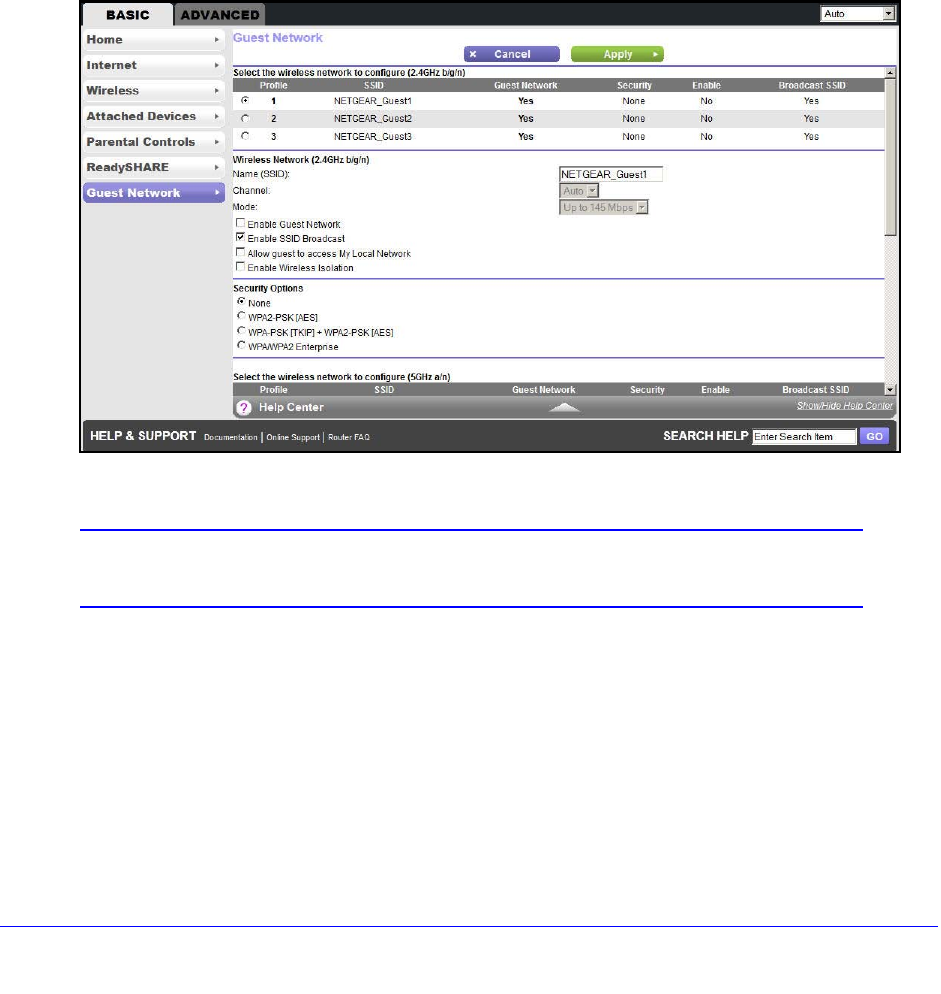
NETGEAR genie BASIC Settings
38
D6200 WiFi Modem Router
1. Under Security Options, select the WPA option you want.
2. In the Passphrase field that displays when you select a WPA security option, enter the
network key (passphrase) that you want to use. It is a text string from 8 to 63 characters.
Guest Networks
Adding a guest network allows visitors at your home to use the Internet without using your
wireless security key. You can add a guest network to each wireless network: 2.4 GHz b/g/n
and 5.0 GHz a/n
To set up a guest network:
1. From the BASIC Home screen, select Guest Network to display the following screen:
2. Select any of the following wireless settings:
Note: These settings apply separately to the 2.4 GHz b/g/n and 5 GHz a/n
bands.
Enable Guest Network. When this check box is selected, the guest network is enabled,
and guests can connect to your network using the SSID of this profile.
Enable SSID Broadcast. If this check box is selected, the wireless access point
broadcasts its name (SSID) to all wireless stations. Stations with no SSID can adopt the
correct SSID for connections to this access point.
Allow guest to access My Local Network. If this check box is selected, any user who
connects to this SSID has access to your local network, not just Internet access.

NETGEAR genie BASIC Settings
39
D6200 WiFi Modem Router
Enable Wireless Isolation. If this check box is selected, wireless clients (computers or
wireless devices) that join the network can use the Internet, but cannot access each other
or access Ethernet devices on the network.
3. Give the guest network a name.
The guest network name is case-sensitive and can be up to 32 characters. You then
manually configure the wireless devices in your network to use the guest network name
in addition to the main nonguest SSID.
4. Select a security option from the list. The security options are described in Guest Network
Wireless Security Options on page 39.
5. Click Apply to save your selections.
Guest Network Wireless Security Options
A security option is the type of security protocol applied to your wireless network. The
security protocol in force encrypts data transmissions and ensures that only trusted devices
receive authorization to connect to your network.
This section presents an overview of the security options and provides guidance on when to
use which option. It is also possible to set up a guest network without wireless security.
NETGEAR does not recommend using no security on a wireless network.
Wi-Fi Protected Access (WPA) encryption is built into all hardware that has the Wi-Fi-certified
seal. This seal means that the product is authorized by the Wi-Fi Alliance
(http://www.wi-fi.org/) because it complies with the worldwide single standard for high-speed
wireless local area networking.
WPA-PSK uses a passphrase to authenticate and generate the initial data encryption keys.
Then it dynamically varies the encryption key. WPA-PSK uses Temporal Key Integrity
Protocol (TKIP) data encryption, implements most of the IEEE 802.11i standard, and is
designed to work with all wireless network interface cards, but not all wireless access points.
It is superseded by WPA2-PSK.
WPA2-PSK is stronger than WPA. It is advertised to be indecipherable due to the greater
degree of randomness in encryption keys that it generates. WPA2-PSK gets higher speed
because it is implemented through hardware, while WPA-PSK is implemented through
software. WPA2-PSK uses a passphrase to authenticate and generate the initial data
encryption keys. Then it dynamically varies the encryption key.
WPS-PSK + WPA2-PSK Mixed Mode can provide broader support for all wireless clients.
WPA2-PSK clients get higher speed and security, and WPA-PSK clients get decent speed
and security. The product documentation for your wireless adapter and WPA client software
should have instructions about configuring their WPA settings.

NETGEAR genie BASIC Settings
40
D6200 WiFi Modem Router
NETGEAR genie App
The genie app is your home network dashboard. It lets you easily view, manage, and control
your entire home network, and helps you fix common network problems. You can use the
genie app or the genie mobile app.
Internet
STATUS GOOD
Network Map
Number of devices 16
Parental Controls
WiFi Connection
STATUS Connected
Router Settings
Click here
ReadySHARE
Click here
Click here
genie app
Visit the NETGEAR genie web page at www.netgear.com/genie.
From the genie app, you can select the following:
•Internet. Monitor and repair Internet connectivity issues, for both wired and wireless
connections.
•WiFi Connection. View or change your router wireless settings.
•Router Settings. Log in to your router to view or change its settings.
•Network Map. View the devices connected to your network.
•Parental Controls. Manage parental controls to protect devices in your network from
inappropriate contents.
•ReadySHARE. If you connected a USB storage device or printer to the USB port on the
router, then you can access its contents.
•Support. Support FAQs are available on your computer without an Internet connection.
You can get answers to common router issues here. Some simple network tools are
available to help you debug the network as well.
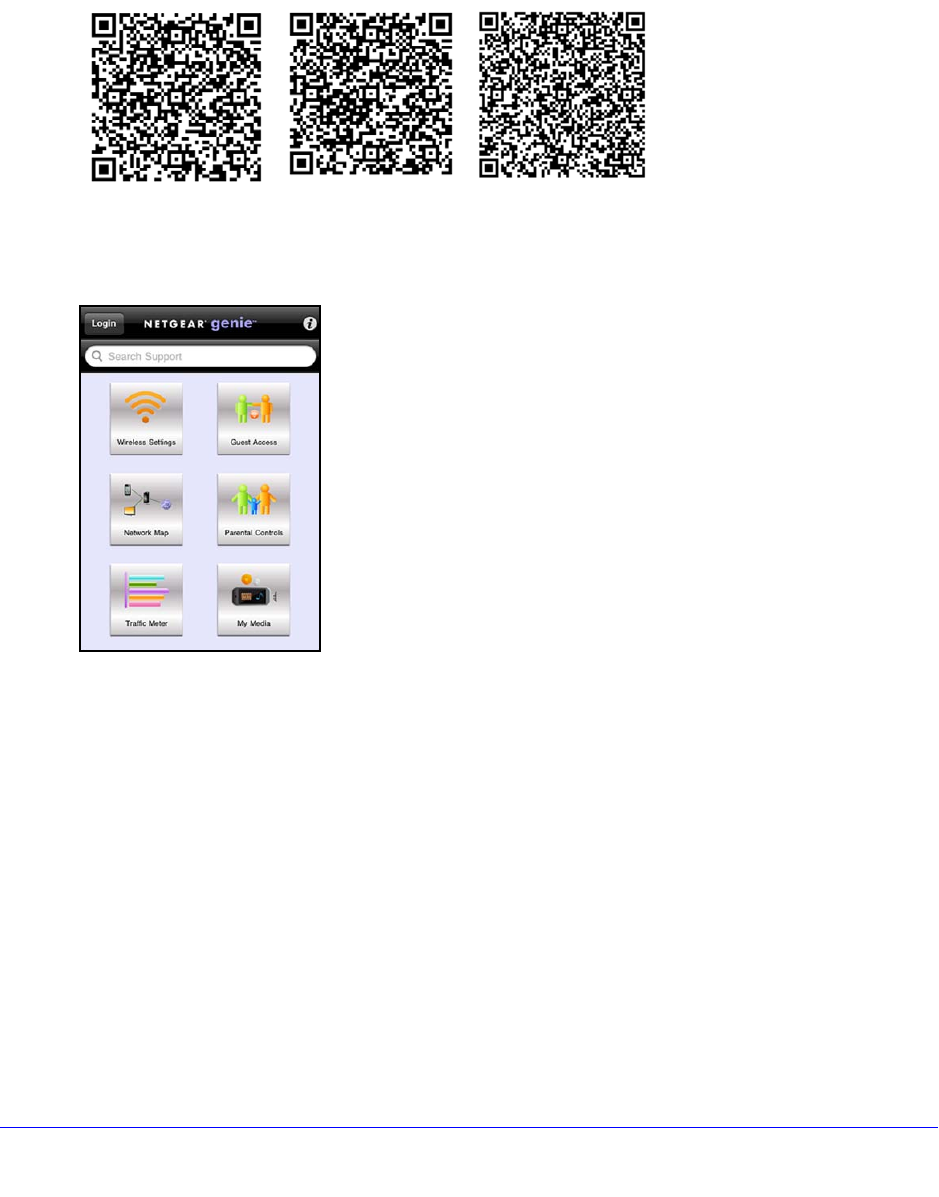
NETGEAR genie BASIC Settings
41
D6200 WiFi Modem Router
NETGEAR genie Mobile App
To install the genie mobile app:
1. Using your mobile device, navigate to the Apple AppStore or Google Play for Android,
and search for NETGEAR genie. You can use the following QR codes to speed up this
process:
Android appiPad app iPhone app
2. Install the app on your iPad or phone.
3. Launch the app, and it displays the dashboard screen.
To use this app, you need a
Wi-Fi connection from your phone or iPad to your
NETGEAR home network.
•Manage Wi-Fi settings and guest access for
your home network.
•View a map of your network.
•Set up or manage Parental Controls.
•Use the traffic meter to check your Internet
usage.
•With My Media, play media on devices on
your network.
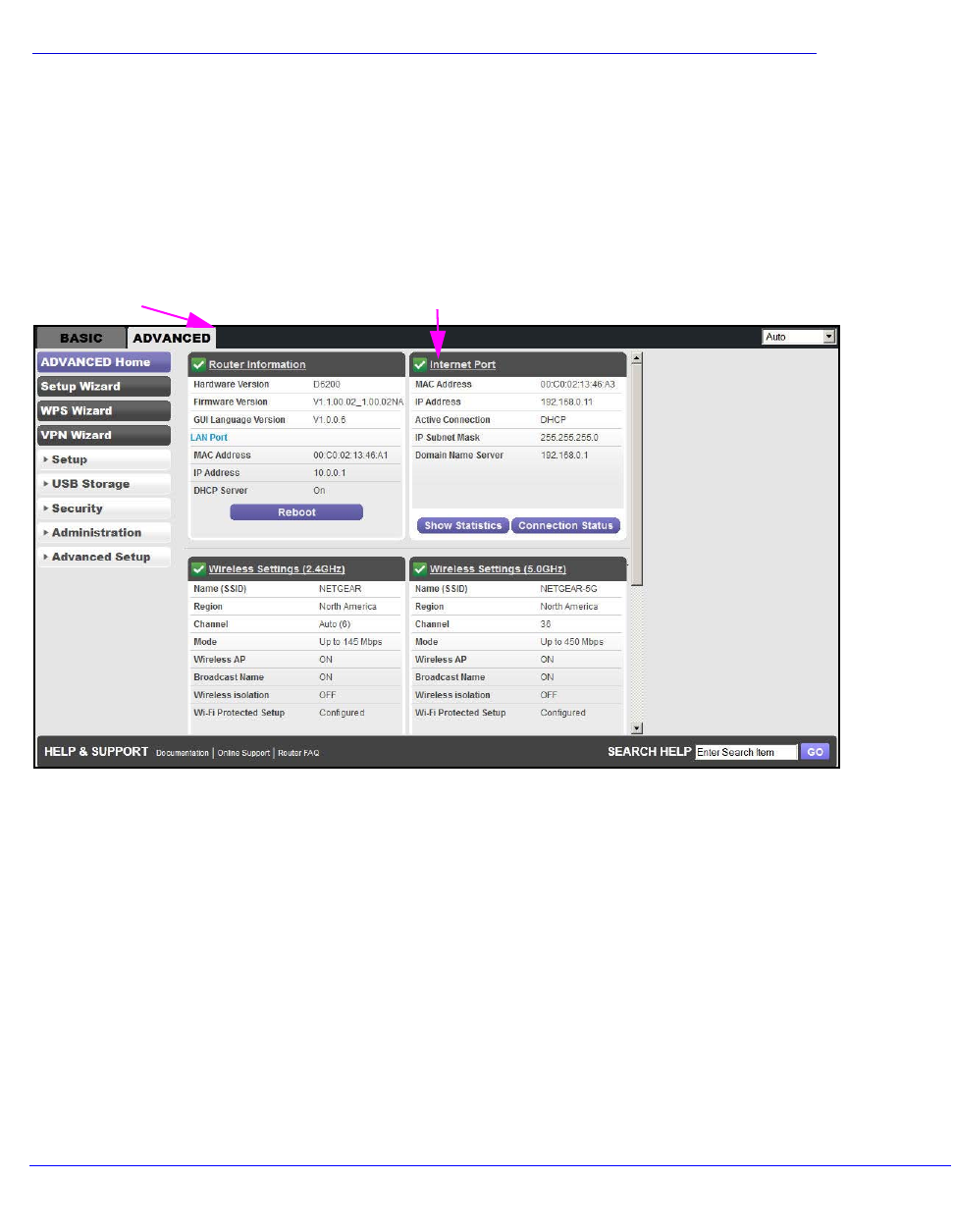
42
4
4. NETGEAR genie ADVANCED Home
Specify custom settings
The ADVANCED screens are for advanced users who want to specify custom settings.
This chapter explains the features available from the NETGEAR genie ADVANCED Home
screen, shown in the following figure:
This screen is also displayed through the Administration menu.
This chapter contains the following sections:
•Setup Wizard
•WPS Wizard
•VPN Wizard
•Setup Menu
•ADSL Setup
•WAN Setup
•LAN Setup
•Quality of Service Setup
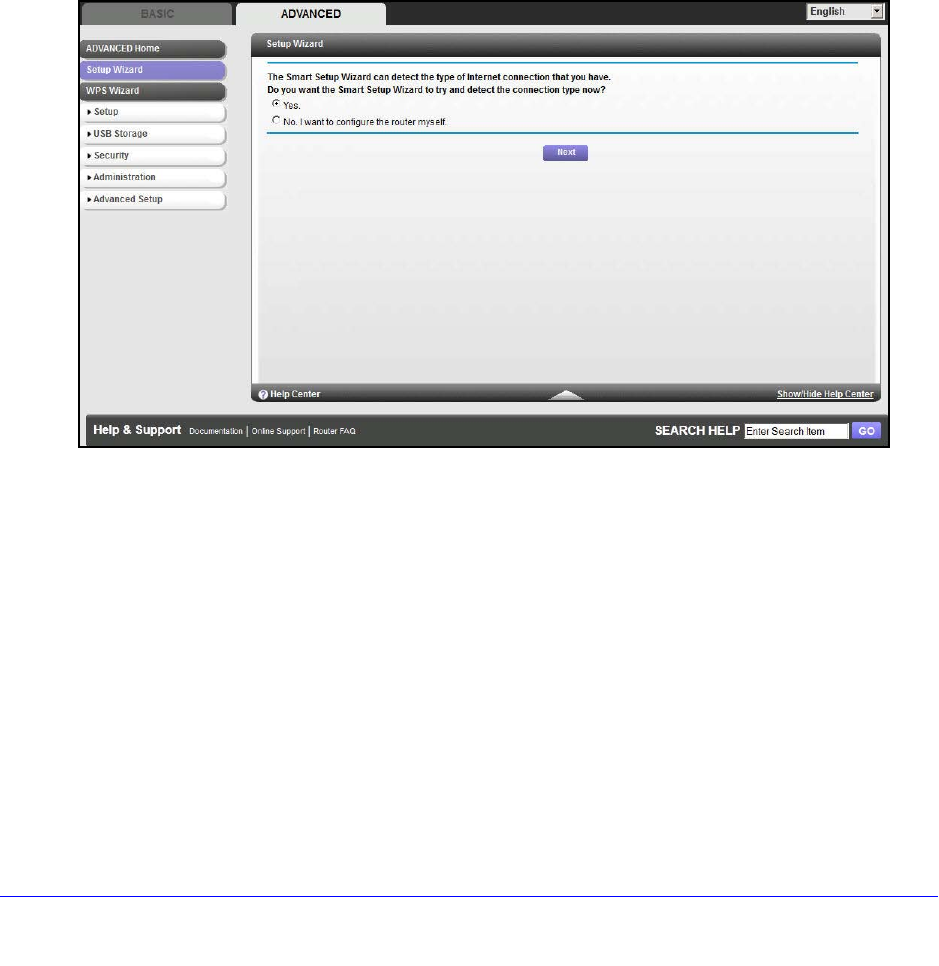
NETGEAR genie ADVANCED Home
43
D6200 WiFi Modem Router
Some selections on the Advanced Home screen are described in separate chapters:
•USB Storage. See Chapter 5, USB Storage.
•Security. See Chapter 7, Security.
•Administration. See Chapter 8, Administration.
•Advanced Setup. See Chapter 9, Advanced Settings.
Setup Wizard
The NETGEAR genie installation process is launched the first time you set up the WiFi
modem router. After setting up the WiFi modem router the first time, if you want to perform
this task again, you can run Setup Wizard from the Advanced tab of the genie.
1. Select Setup Wizard to display the following screen:
2. Select either Yes or No, I want to configure the router myself. If you select No, you are
taken to the Internet Basic Settings screen (see Internet Basic Settings on page 30).
3. If you selected Yes, click Next. A series of screens are displayed as the router discovers and
processes your Internet connection. Click Next when prompted to advance to the next
screen.
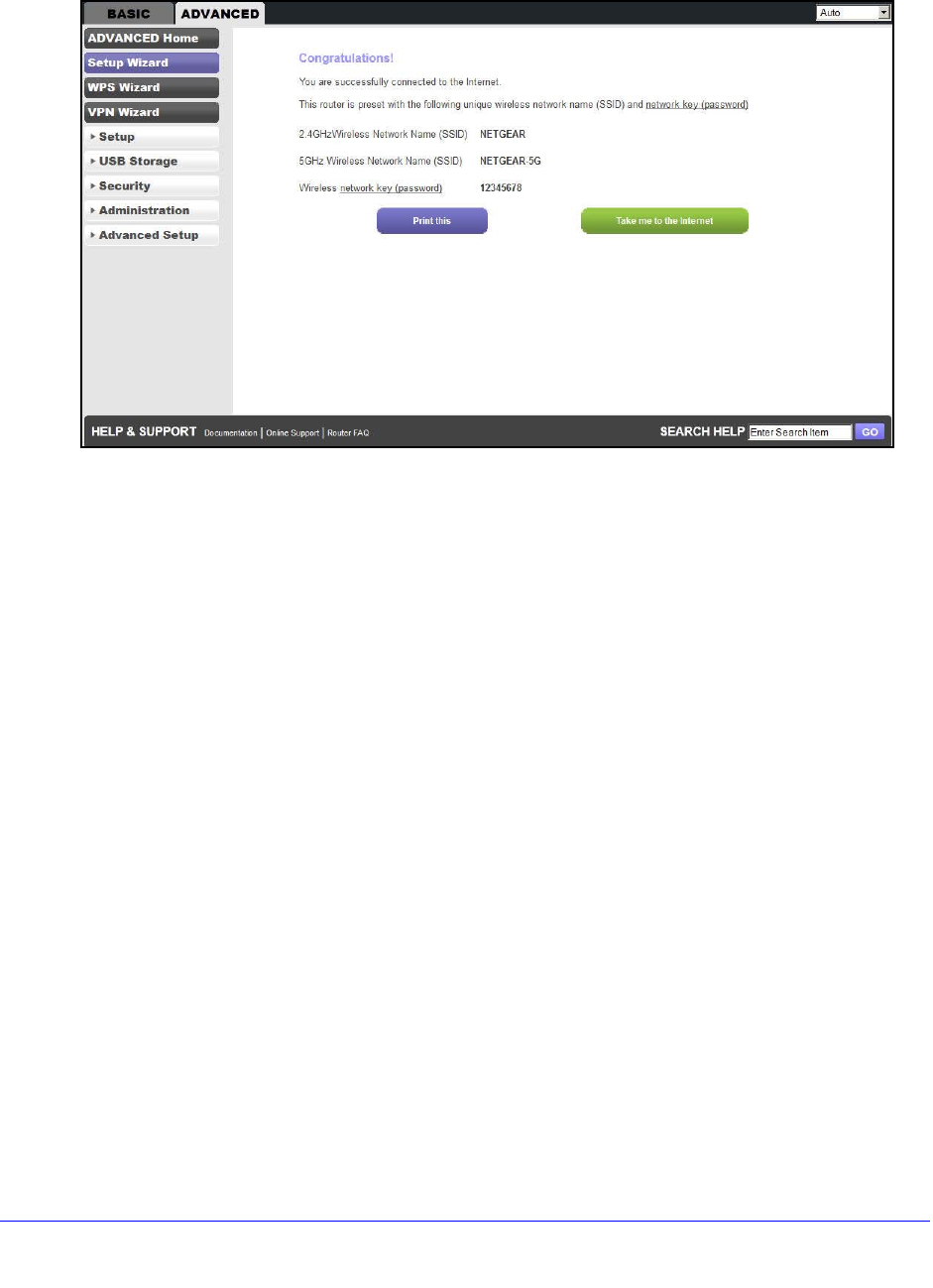
NETGEAR genie ADVANCED Home
44
D6200 WiFi Modem Router
The Setup Wizard searches your Internet connection for servers and protocols to
determine your ISP configuration. The following screen displays:
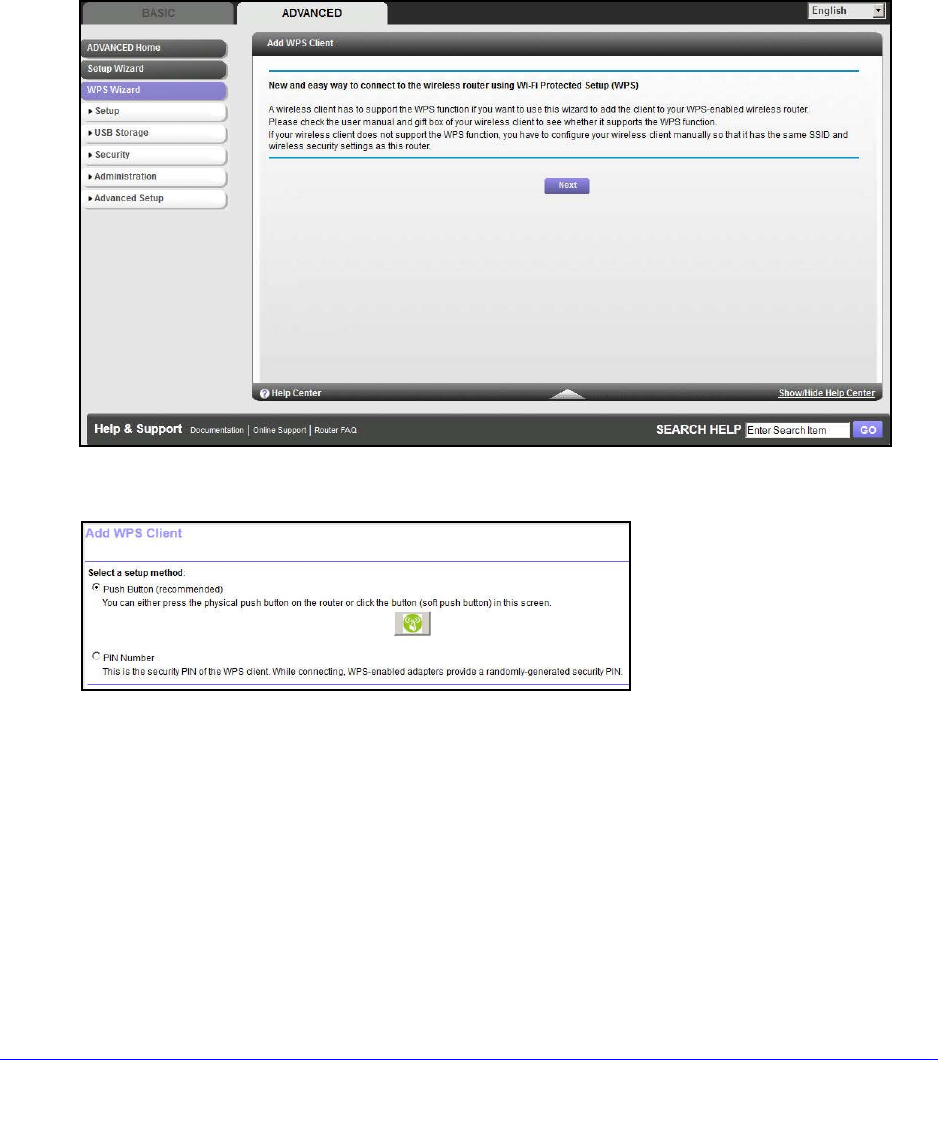
NETGEAR genie ADVANCED Home
45
D6200 WiFi Modem Router
WPS Wizard
The WPS Wizard helps you add a WPS-capable client device (a wireless device or
computer) to your network. On the client device, you have to either press its WPS button or
locate its WPS PIN.
To use the WPS Wizard:
1. Select ADVANCED > WPS Wizard. The following screen displays:
2. Click Next. The following screen lets you select the method for adding the WPS client (a
wireless device or computer).
You can use either the push button or PIN method.
3. Select either Push Button or PIN Number.
•To use the push button method, either click the WPS button on this screen, or press
the WPS button on the top of the WiFi modem router. Within 2 minutes, go to the
wireless client and press its WPS button to join the network without entering a
password.
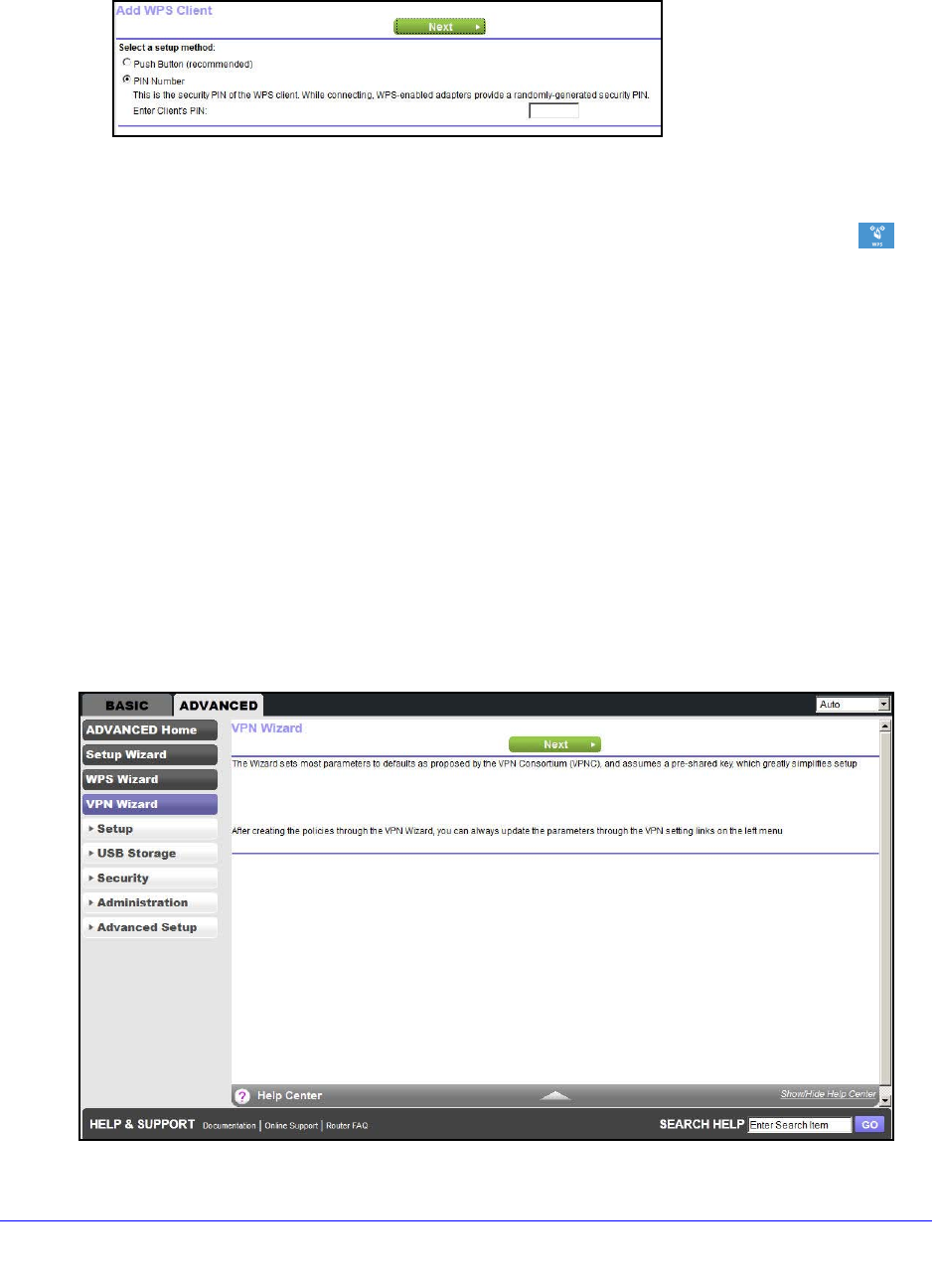
NETGEAR genie ADVANCED Home
46
D6200 WiFi Modem Router
•To use the PIN method, select the PIN Number radio button, enter the client security
PIN, and click Next.
Within 2 minutes, go to the client device and use its WPS software to join the network
without entering a password.
The WiFi modem router attempts to add the WPS-capable device. The WPS LED on
the top of the WiFi modem router blinks green. When the WiFi modem router establishes
a WPS connection, the LED is solid green, and the WiFi modem router WPS screen
displays a confirmation message.
4. Repeat Step 2 and Step 3 to add another WPS client to your network.
VPN Wizard
The Wizard asks you series of questions that determine the IPSec keys and VPN policies it
sets up. The VPN Wizard sets the parameters for the network connection, Security
Association, traffic selectors, authentication algorithm, and encryption. These parameters are
based on the VPNC recommendations. More information about the VPNC recommendations
is presented in the VPN Wizard summary page.
To use the VPN Wizard:
1. Select ADVANCED > VPN Wizard. The following screen displays:
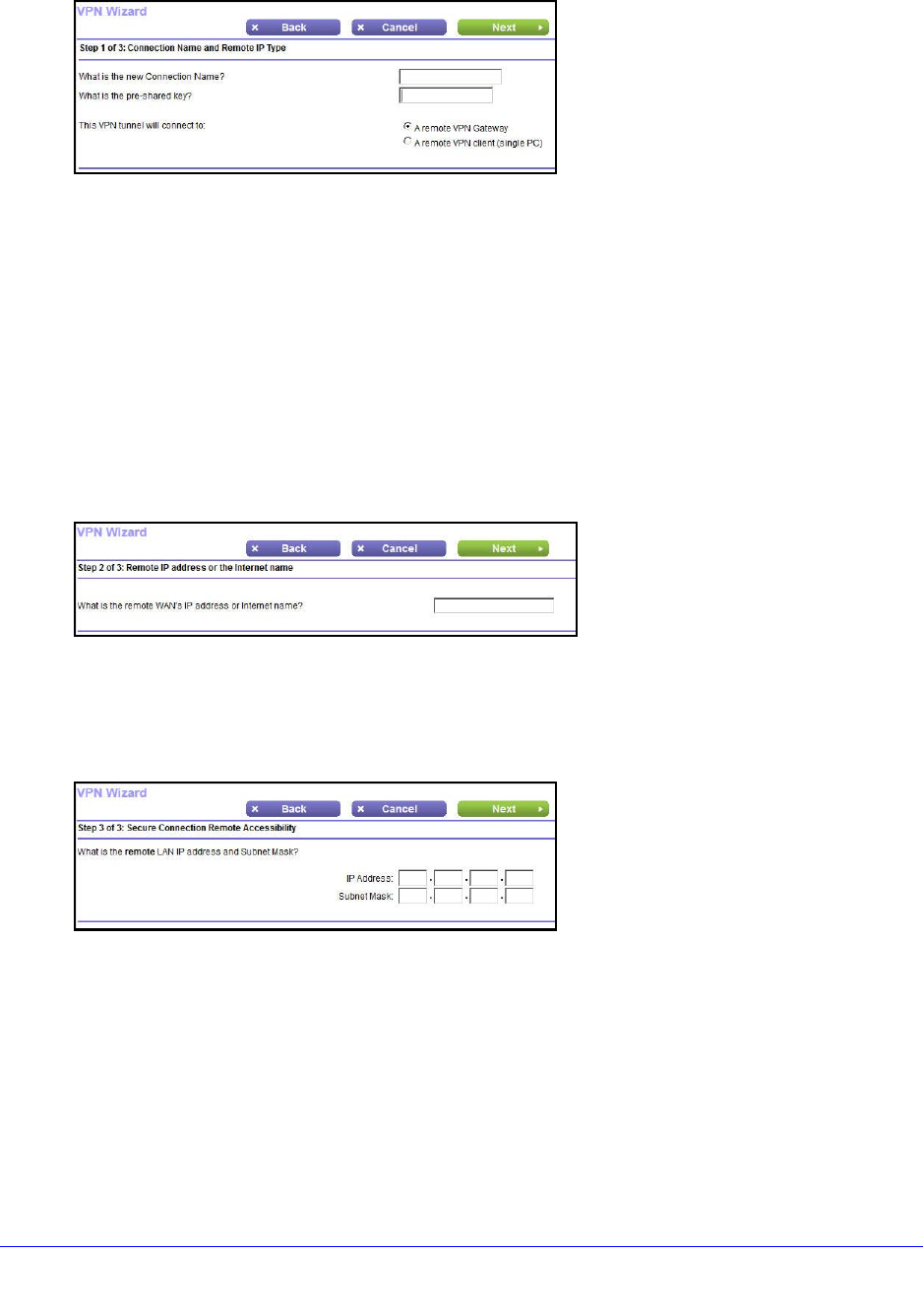
NETGEAR genie ADVANCED Home
47
D6200 WiFi Modem Router
2. Click Next. The following screen displays:
Enter the requested information:
•Connection name. Enter an appropriate name for the connection. This name is not
supplied to the remote VPN endpoint. Rather, it is used to help you manage the VPN
settings.
•Pre-shared key. The key has to be entered both here and on the remote VPN
Gateway or the remote VPN client. This method does not require using a CA
(Certificate Authority).
•VPN tunnel connection. The wizard has to know if you are planning to connect to a
remote gateway or setting up the connection for a remote client or computer to
establish a secure connection to this device.
3. Click Next. The following screen displays:
Enter the remote IP address of the gateway you want to connect to, or provide the
Internet name of the gateway. The Internet name is the fully qualified domain name, as
set up in a Dynamic DNS service.
4. Click Next. The following screen displays:
Enter the remote LAN IP address and subnet mask of the remote gateway.
•If this information does not match the LAN IP address and subnet mask in the remote
gateway, the secure tunnel fails to connect.
•The IP address range used on the remote LAN has to be different from the IP address
range used on the local LAN.
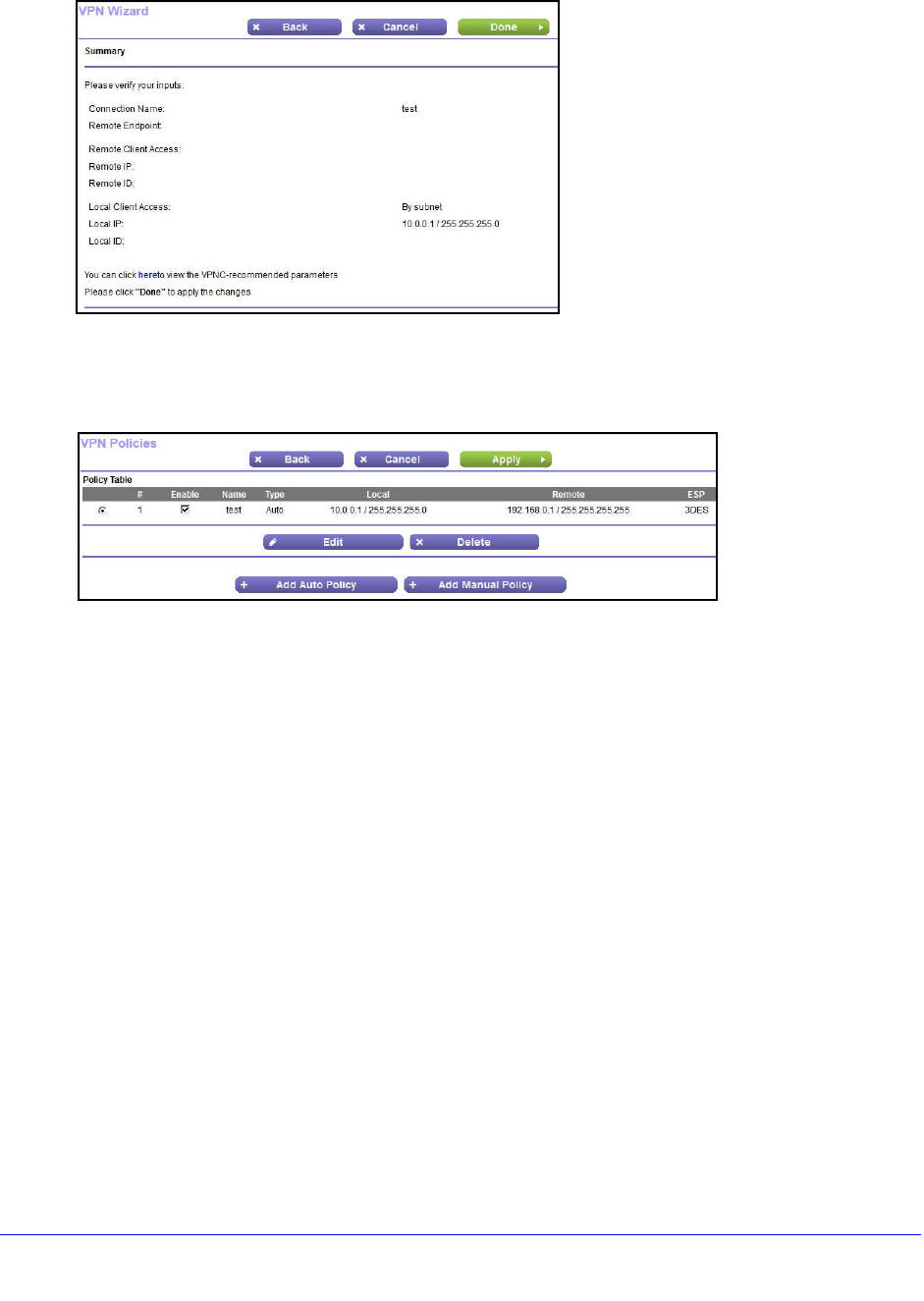
NETGEAR genie ADVANCED Home
48
D6200 WiFi Modem Router
5. Click Next. The following screen displays:
This screen shows the summary of the Wizard configuration with a link to view the VPNC
recommended parameters (click here to view the VPNC-recommended parameters).
6. Click Done. The following screen displays:
7. For information about how to add or modify VPN policies, see VPN Policies on page 123.
Setup Menu
Select ADVANCED > Setup to display the Setup menu. The following selections are
available:
•Internet Setup. This selection is a shortcut to the same Internet Basic Settings screen
that you can access from the dashboard on the BASIC Home screen. See Internet Basic
Settings on page 30.
•ADSL Setup. Internet (ADSL) setup. See ADSL Setup on page 49.
•Wireless Setup. This selection is a shortcut to the same Wireless Settings screen that
you can access from the dashboard on the BASIC Home screen. See Basic Wireless
Settings on page 35.
•WAN Setup. Internet (WAN) setup. See WAN Setup on page 50.
•LAN Setup. Local area network (LAN) setup. See LAN Setup on page 53.
•QoS Setup. Quality of Service (QoS) setup. See Quality of Service Setup on page 56.
•Guest Network. This selection is a shortcut to the same Wireless Settings (for guest
networks) screen that you can access from the dashboard on the BASIC Home screen.
See Guest Networks on page 38.
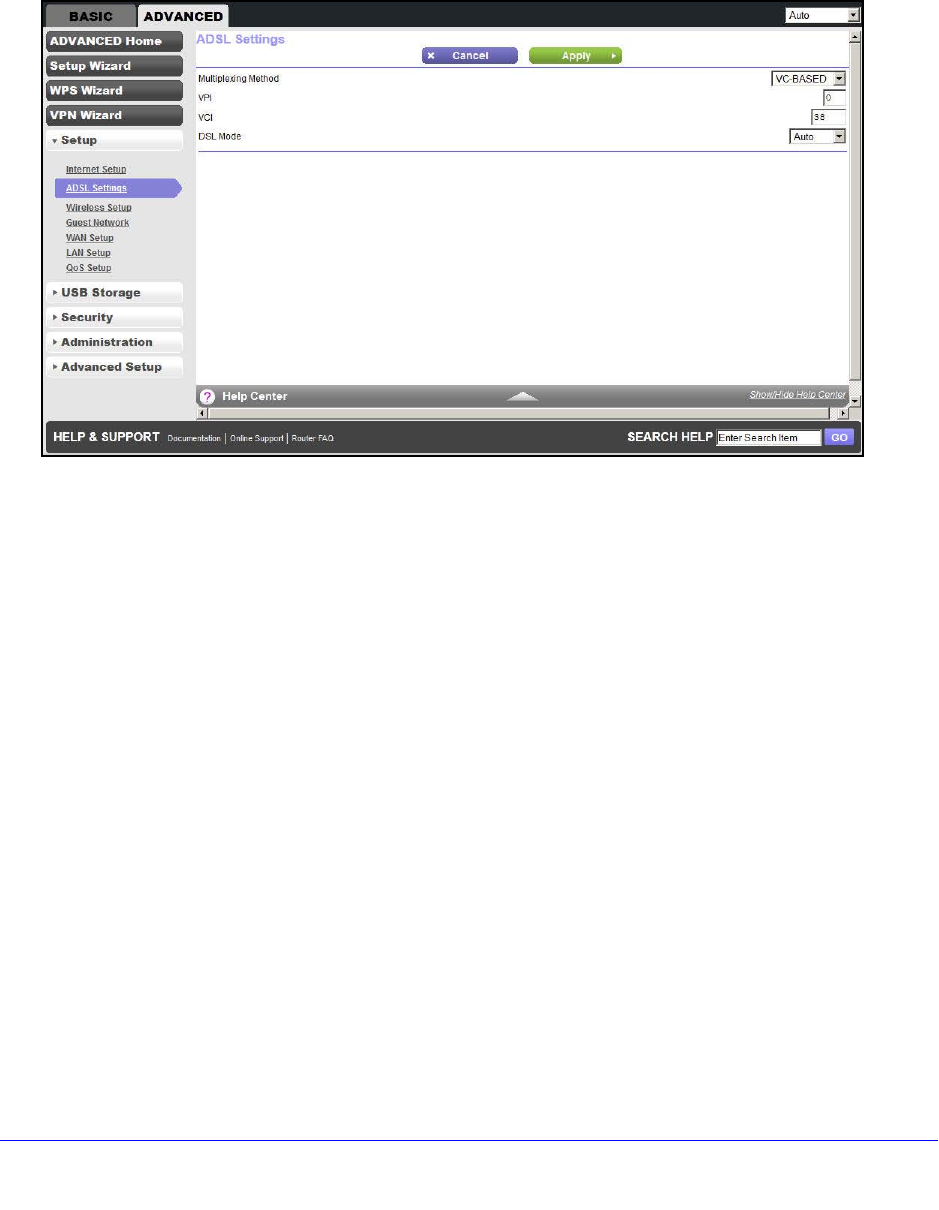
NETGEAR genie ADVANCED Home
49
D6200 WiFi Modem Router
ADSL Setup
The ADSL Settings screen lets you configure the multiplexing method and virtual circuit of
your ADSL connection. The default parameters should be correct to match the system used
by your ISP. Select ADVANCED > Setup > ADSL Settings to dispay the following screen:
•Multiplexing Method. Your ISP indicates whether your multiplexing method is
VC-BASED or LLC-BASED.
•VPI, VCI. Your ISP indicates which VPI and VCI combination is used for your service.
•DSL Mode. Your ISP indicates that the best setting is used for your DSL connection.
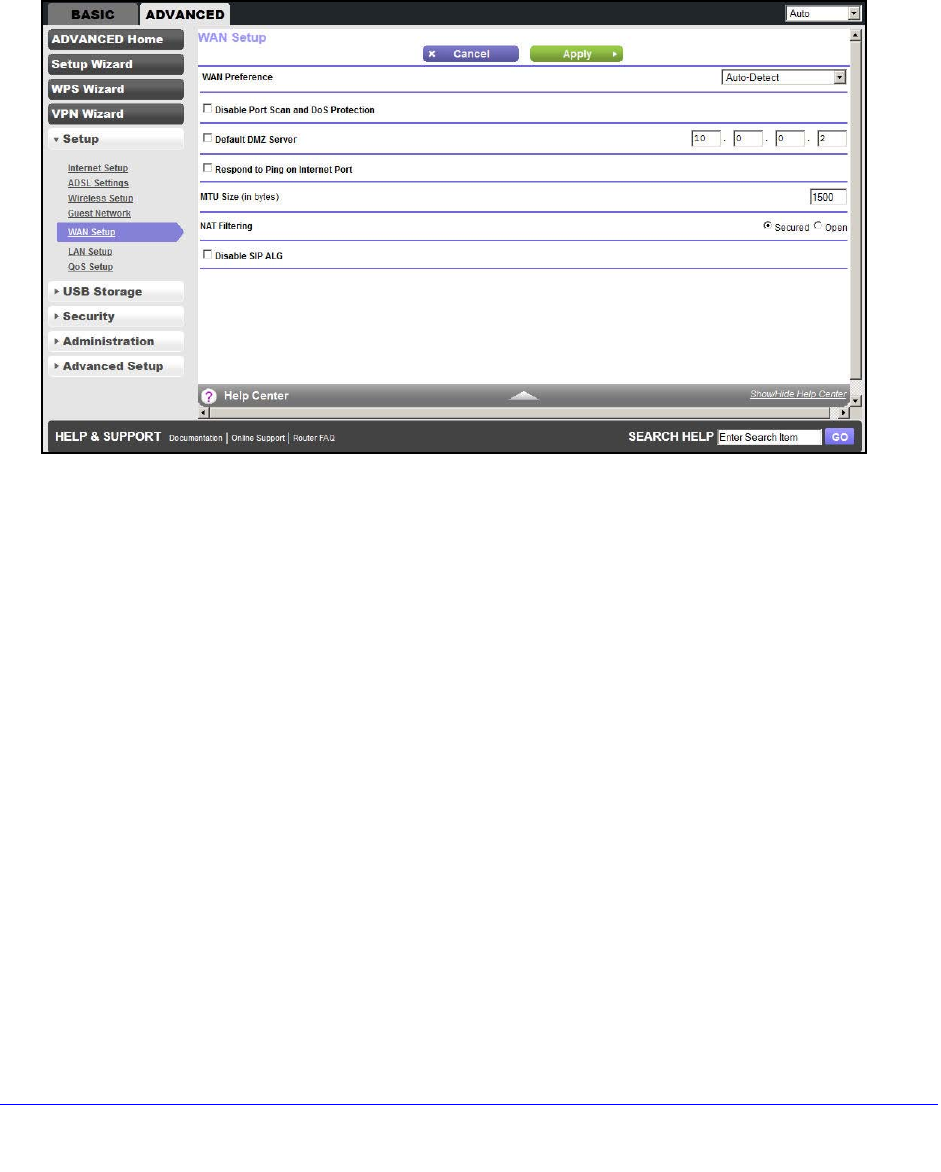
NETGEAR genie ADVANCED Home
50
D6200 WiFi Modem Router
WAN Setup
The WAN Setup screen lets you configure a DMZ (demilitarized zone) server, change the
maximum transmit unit (MTU) size, and enable the WiFi modem router to respond to a ping
on the WAN (Internet) port. Select ADVANCED > Setup > WAN Setup to view the following
screen:
•WAN Preference. Select your WAN preference: Auto Detect, Must use DSL WAN, or
Must use Ethernet WAN.
•Disable Port Scan and DoS Protection. DoS protection protects your LAN against
denial of service attacks such as Syn flood, Smurf Attack, Ping of Death, Teardrop Attack,
UDP Flood, ARP Attack, Spoofing ICMP, Null Scan, and many others. This feature should
be disabled only in special circumstances.
•Default DMZ Server. This feature is sometimes helpful when you are playing online
games or videoconferencing. Be careful when using this feature because it makes the
firewall security less effective. See the following section, Default DMZ Server, for more
details.
•Respond to Ping on Internet Port. If you want the WiFi modem router to respond to a
ping from the Internet, select this check box. Use this setting only as a diagnostic tool
because it allows your WiFi modem router to be discovered. Do not select this check box
unless you have a specific reason.
•MTU Size (in bytes). The normal MTU (Maximum Transmit Unit) value for most Ethernet
networks is 1500 bytes, or 1492 bytes for PPPoE connections. For some ISPs, you might
need to reduce the MTU. This change is rarely required, and should not be done unless
you are sure that it is necessary for your ISP connection. See Change the MTU Size on
page 51.

NETGEAR genie ADVANCED Home
51
D6200 WiFi Modem Router
•Disable IGMP Proxying. The IGMP Proxying function lets a LAN computer receive the
multicast traffic it is interested in from the Internet. Click this check box to disable the
function if you do not need it.
•NAT Filtering. Network Address Translation (NAT) determines how the WiFi modem
router processes inbound traffic. Secured NAT provides a secured firewall to protect the
computers on the LAN from attacks from the Internet, but might prevent some Internet
games, point-to-point applications, or multimedia applications from functioning. Open
NAT provides a much less secured firewall, but allows almost all Internet applications to
function.
•Disable SIP ALG. Some VoIP applications do not work well with the SIP ALG. Enabling
this option to turn off the SIP ALG might help your VoIP devices to create or accept a call
through the router.
Default DMZ Server
The default DMZ server feature is helpful when you are using some online games and
videoconferencing applications that are incompatible with Network Address Translation
(NAT). The WiFi modem router is programmed to recognize some of these applications and
to work correctly with them, but other applications might not function well. In some cases, one
local computer can run the application correctly if that computer’s IP address is entered as
the default DMZ server.
WARNING:
DMZ servers pose a security risk. A computer designated as the
default DMZ server loses much of the protection of the firewall
and is exposed to exploits from the Internet. If compromised, the
DMZ server computer can be used to attack other computers on
your network.
Incoming traffic from the Internet is discarded by the WiFi modem router unless the traffic is a
response to one of your local computers or a service that you have configured in the Port
Forwarding/Port Triggering screen. Instead of discarding this traffic, you can forward it to one
computer on your network. This computer is called the default DMZ server.
To set up a default DMZ server:
1. On the WAN Setup screen, select the Default DMZ Server check box.
2. Type the IP address.
3. Click Apply.
Change the MTU Size
The maximum transmission unit (MTU) is the largest data packet a network device transmits.
When one network device communicates across the Internet with another, the data packets
travel through many devices along the way. If any device in the data path has a lower MTU
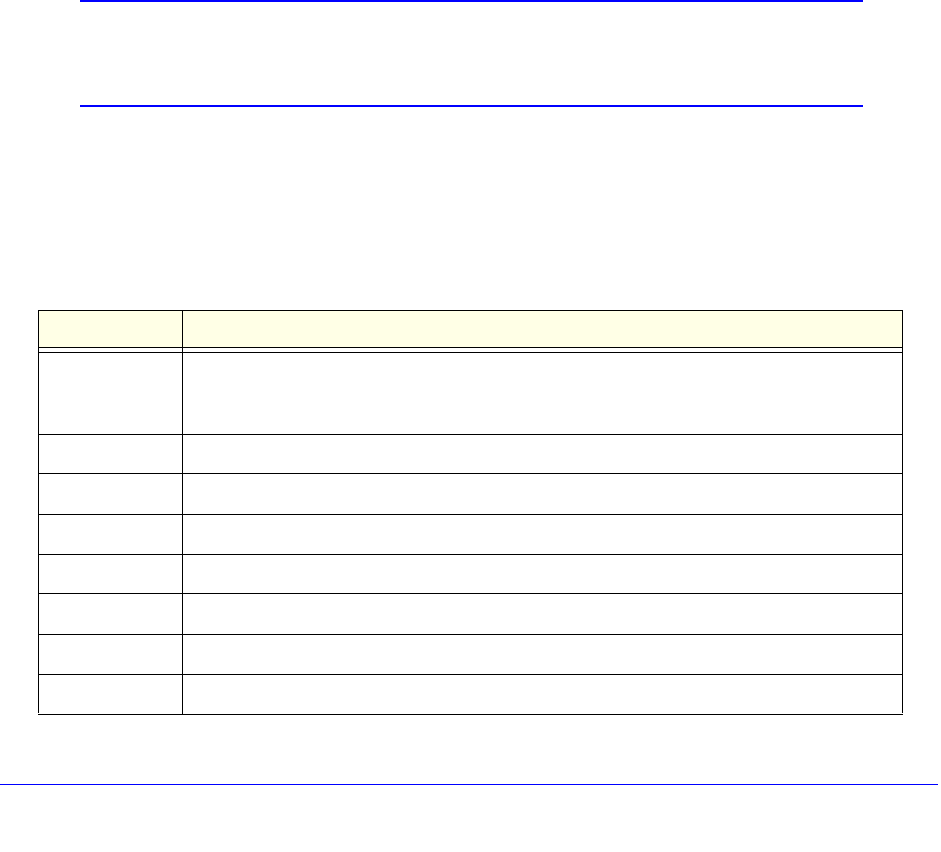
NETGEAR genie ADVANCED Home
52
D6200 WiFi Modem Router
setting than the other devices, the data packets have to be split or “fragmented” to
accommodate the device with the smallest MTU.
The best MTU setting for NETGEAR equipment is often just the default value, and changing
the value might fix one problem but cause another. Leave the MTU unchanged unless one of
these situations occurs:
•You have problems connecting to your ISP or other Internet service, and the technical
support of either the ISP or NETGEAR recommends changing the MTU setting. These
web-based applications might require an MTU change:
-A secure website that does not open, or displays only part of a web page
-Yahoo email
-MSN portal
-America Online’s DSL service
•You use VPN and have severe performance problems.
•You used a program to optimize MTU for performance reasons, and now you have
connectivity or performance problems.
Note: An incorrect MTU setting can cause Internet communication
problems such as the inability to access certain websites, frames
within websites, secure login pages, or FTP or POP servers.
If you suspect an MTU problem, a common solution is to change the MTU to 1400. If you are
willing to experiment, you can gradually reduce the MTU from the maximum value of 1500
until the problem goes away. The following table describes common MTU sizes and
applications.
Table 8. Common MTU sizes
MTU Application
1500 The largest Ethernet packet size and the default value. This is the typical setting for
non-PPPoE, non-VPN connections, and is the default value for NETGEAR WiFi modem
routers, adapters, and switches.
1492 Used in PPPoE environments.
1472 Maximum size to use for pinging. (Larger packets are fragmented.)
1468 Used in some DHCP environments.
1460 Usable by AOL if you do not have large email attachments, for example.
1436 Used in PPTP environments or with VPN.
1400 Maximum size for AOL DSL.
576 Typical value to connect to dial-up ISPs.
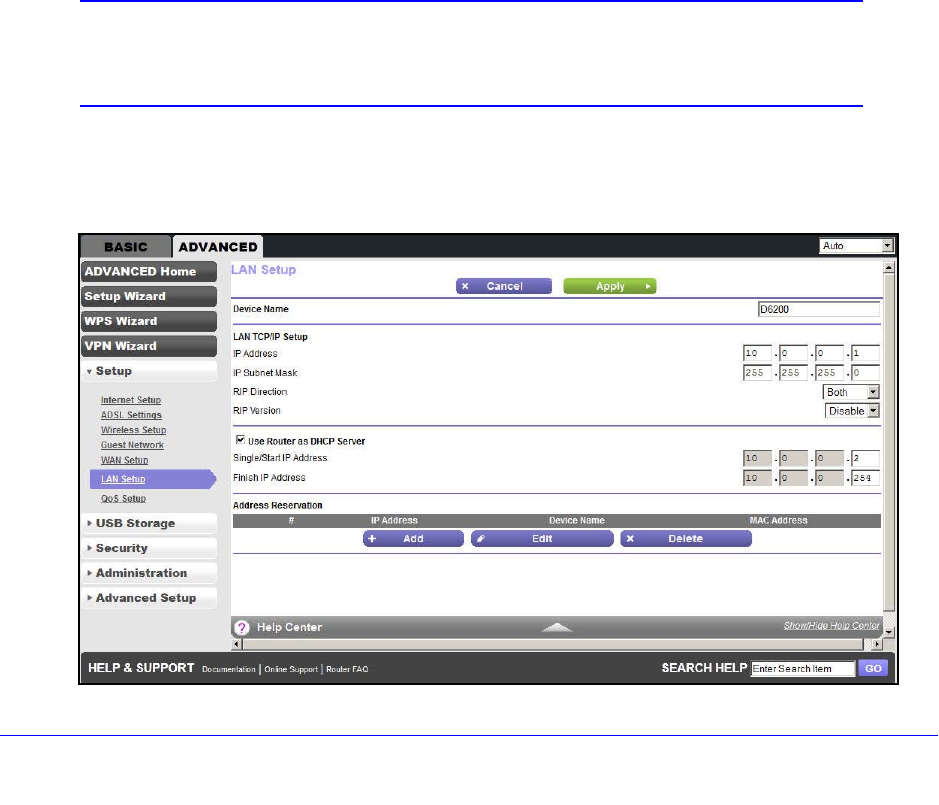
NETGEAR genie ADVANCED Home
53
D6200 WiFi Modem Router
To change the MTU size:
1. Select ADVANCED > Setup > WAN Setup.
2. In the MTU Size field, enter a new size from 64 through 1500.
3. Click Apply to save the settings.
LAN Setup
The LAN Setup screen allows configuration of LAN IP services such as Dynamic Host
Configuration Protocol (DHCP) and Routing Information Protocol (RIP).
The WiFi modem router is shipped preconfigured to use private IP addresses on the LAN
side and to act as a DHCP server. The WiFi modem router’s default LAN IP configuration is:
•LAN IP address. 192.168.0.1
•Subnet mask. 255.255.255.0
These addresses are part of the designated private address range for use in private networks
and should be suitable for most applications. If your network requires a different IP
addressing scheme, make changes in the LAN Setup screen.
Note: If you change the LAN IP address of the WiFi modem router while
connected through the browser, you are disconnected. You have to
open a new connection to the new IP address and log in again.
To change the LAN settings:
1. Select ADVANCED > Setup > LAN Setup to display the following screen:

NETGEAR genie ADVANCED Home
54
D6200 WiFi Modem Router
2. Enter the settings that you want to customize. These settings are described in the following
section, LAN Setup Screen Settings.
3. Click Apply to save your changes.
LAN Setup Screen Settings
LAN TCP/IP Setup
•IP Address. The LAN IP address of the WiFi modem router.
•IP Subnet Mask. The LAN subnet mask of the WiFi modem router. Combined with the IP
address, the IP subnet mask allows a device to know which other addresses are local to
it, and which have to be reached through a gateway or WiFi modem router.
•RIP Direction. Router Information Protocol (RIP) allows a router to exchange routing
information with other routers. This setting controls how the router sends and receives
RIP packets. Both is the default setting. With the Both or Out Only setting, the router
broadcasts its routing table periodically. With the Both or In Only setting, the router
incorporates the RIP information that it receives.
•RIP Version. This setting controls the format and the broadcasting method of the RIP
packets that the WiFi modem router sends. It recognizes both formats when receiving. By
default, the RIP function is disabled.
-RIP-1 is universally supported. It is adequate for most networks, unless you have an
unusual network setup.
-RIP-2 carries more information. Both RIP-2B and RIP-2M send the routing data in
RIP-2 format. RIP-2B uses subnet broadcasting. RIP-2M uses multicasting.
Use Router as a DHCP Server
This check box is selected so that the WiFi modem router functions as a Dynamic Host
Configuration Protocol (DHCP) server.
•Starting IP Address. Specify the start of the range for the pool of IP addresses in the
same subnet as the WiFi modem router.
•Ending IP Address. Specify the end of the range for the pool of IP addresses in the
same subnet as the WiFi modem router.
Address Reservation
When you specify a reserved IP address for a computer on the LAN, that computer receives
the same IP address each time it accesses the WiFi modem router’s DHCP server. Assign
reserved IP addresses to servers that require permanent IP settings.
Use the WiFi Modem Router as a DHCP Server
By default, the WiFi modem router functions as a DHCP server, allowing it to assign IP, DNS
server, and default gateway addresses to all computers connected to the WiFi modem
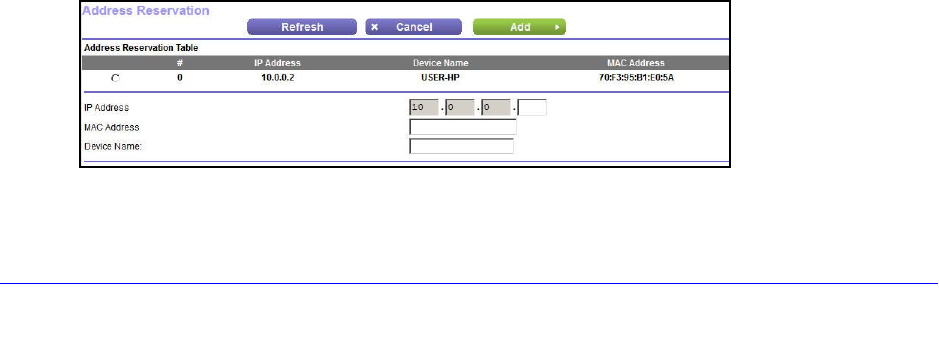
NETGEAR genie ADVANCED Home
55
D6200 WiFi Modem Router
router’s LAN. The assigned default gateway address is the LAN address of the WiFi modem
router. The WiFi modem router assigns IP addresses to the attached computers from a pool
of addresses specified in this screen. Each pool address is tested before it is assigned to
avoid duplicate addresses on the LAN. For most applications, the default DHCP and TCP/IP
settings of the WiFi modem router are satisfactory.
You can specify the pool of IP addresses that are assigned by setting the starting IP address
and ending IP address. These addresses should be part of the same IP address subnet as
the WiFi modem router’s LAN IP address. Using the default addressing scheme, you should
define a range between 192.168.0.2 and 192.168.0.254, although you might want to save
part of the range for devices with fixed addresses.
The WiFi modem router delivers the following parameters to any LAN device that requests
DHCP:
•An IP address from the range you defined
•Subnet mask
•Gateway IP address (the WiFi modem router’s LAN IP address)
•Primary DNS server (if you entered a primary DNS address in the Internet Basic Settings
screen; otherwise, the WiFi modem router’s LAN IP address)
•Secondary DNS server (if you entered a secondary DNS address in the Internet Basic
Settings screen)
To use another device on your network as the DHCP server, or to manually configure the
network settings of all of your computers, clear the Use Router as DHCP Server check box
and click Apply. Otherwise, leave this check box selected. If this service is not enabled and
no other DHCP server is available on your network, you need to set your computers’ IP
addresses manually or they are not able to access the WiFi modem router.
Address Reservation
When you specify a reserved IP address for a computer on the LAN, that computer always
receives the same IP address each time it accesses the WiFi modem router’s DHCP server.
Reserved IP addresses should be assigned to computers or servers that require permanent
IP settings.
To reserve an IP address:
1. In the Address Reservation section of the screen, click the Add button. The following
screen displays:
2. In the IP Address field, type the IP address to assign to the computer or server. (Choose an
IP address from the WiFi modem router’s LAN subnet, such as 192.168.0.x.)
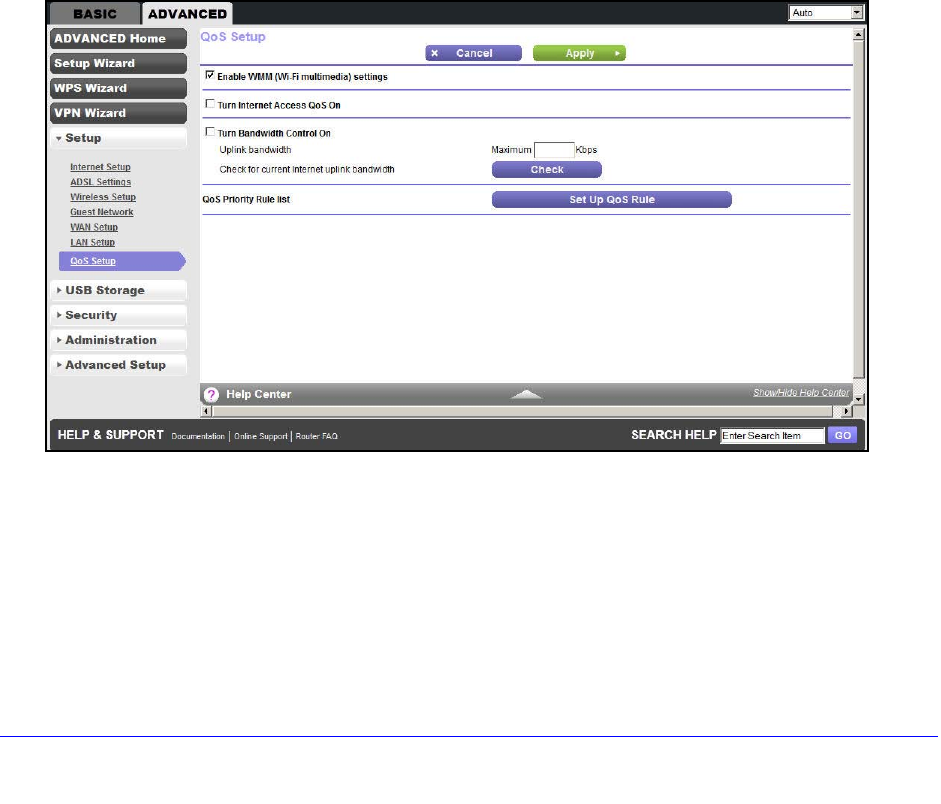
NETGEAR genie ADVANCED Home
56
D6200 WiFi Modem Router
3. Type the MAC address of the computer or server.
Tip: If the computer is already on your network, you can copy its MAC
address from the Attached Devices screen and paste it here.
4. Click Apply to enter the reserved address into the table.
The reserved address is not assigned until the next time the computer contacts the WiFi
modem router’s DHCP server. Reboot the computer or access its IP configuration and
force a DHCP release and renew.
To edit or delete a reserved address entry, select the radio button next to the reserved
address you want to edit or delete. Then click Edit or Delete.
Quality of Service Setup
Quality of Service (QoS) is an advanced feature that can be used to prioritize some types of
traffic ahead of others. The WiFi Modem Router can provide QoS prioritization over the
wireless link and on the Internet connection. To configure QoS, use the QoS Setup screen.
Select ADVANCED > Setup > QoS Setup to display the following screen:
Enable WMM QoS for Wireless Multimedia Applications
The WiFi Modem Router supports Wi-Fi Multimedia Quality of Service (WMM QoS) to
prioritize wireless voice and video traffic over the wireless link. WMM QoS provides
prioritization of wireless data packets from different applications based on four access
categories: voice, video, best effort, and background. For an application to receive the
benefits of WMM QoS, both the application and the client running that application must have
WMM enabled. Legacy applications that do not support WMM and applications that do not
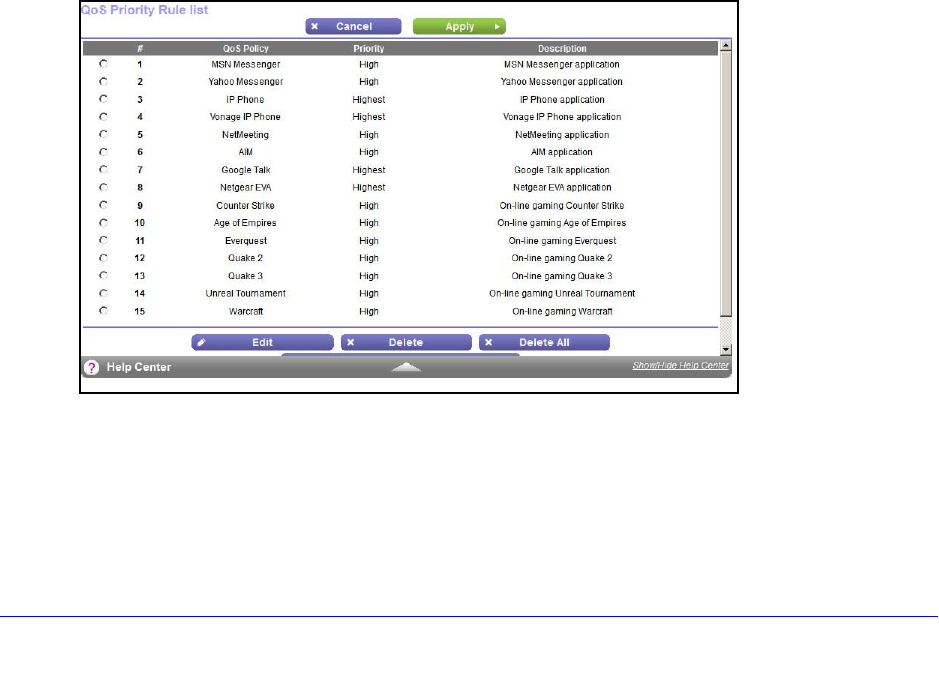
NETGEAR genie ADVANCED Home
57
D6200 WiFi Modem Router
require QoS are assigned to the best effort category, which receives a lower priority than
voice and video.
WMM QoS is enabled by default. You can disable it in the QoS Setup screen by clearing the
Enable WMM check box and clicking Apply.
Set Up QoS for Internet Access
You can give prioritized Internet access to the following types of traffic:
•Specific applications
•Specific online games
•Individual Ethernet LAN ports of the WiFi modem router
•A specific device by MAC address
To specify prioritization of traffic, you have to create a policy for the type of traffic and add the
policy to the QoS Policy table in the QoS Setup screen. For convenience, the QoS Policy
table lists many common applications and online games that can benefit from QoS handling.
QoS for Applications and Online Gaming
To create a QoS policy for applications and online games:
1. In the QoS Setup screen, select the Turn Internet Access QoS On check box.
2. Click the Setup QoS Rule button to see the existing priority rules. On this screen, you can
edit or delete a rule by selecting its radio button and clicking either the Edit or Delete button.
To delete all of the rules, click the Delete All button.
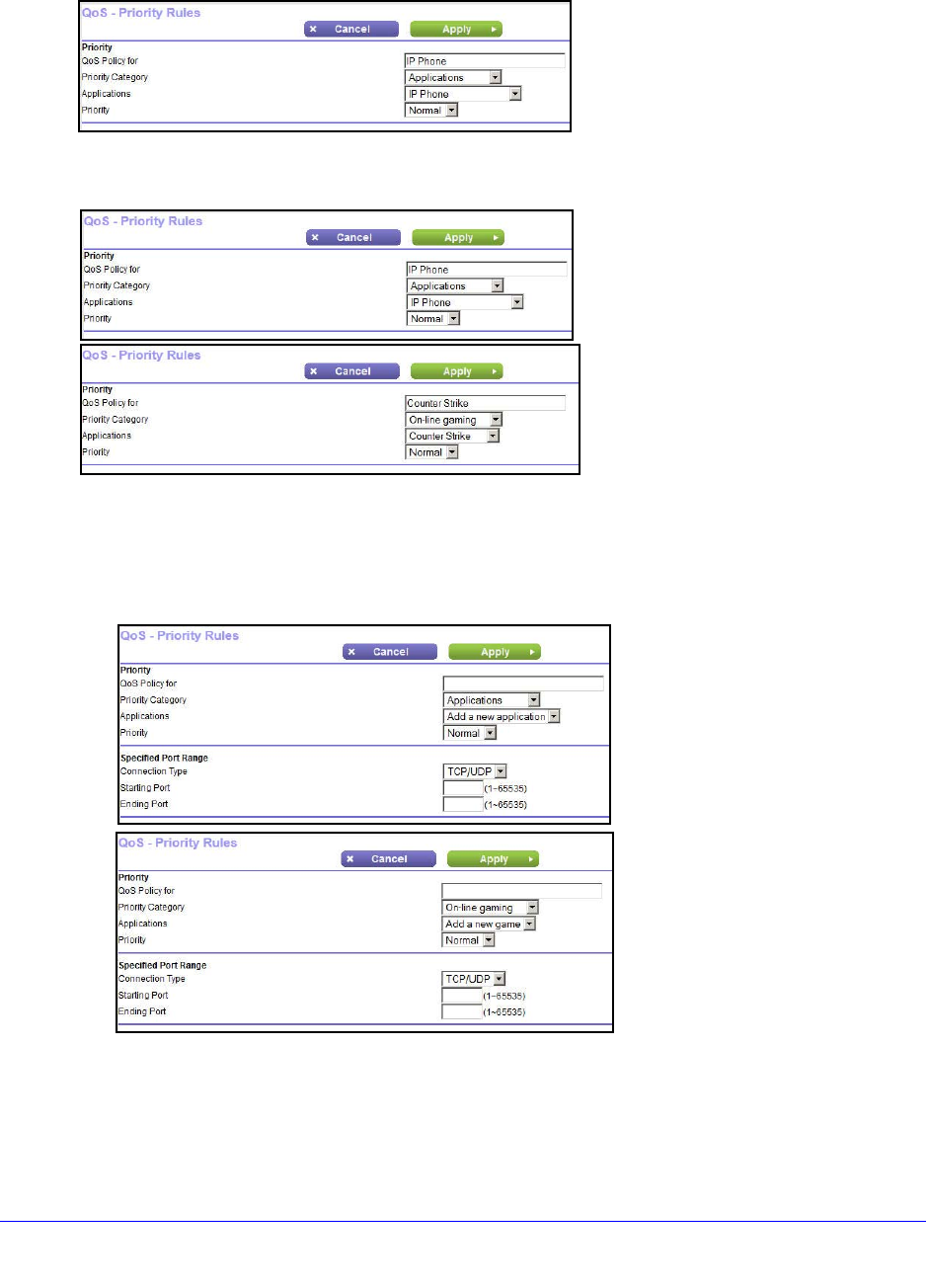
NETGEAR genie ADVANCED Home
58
D6200 WiFi Modem Router
3. To add a priority rule, scroll down to the bottom of the QoS Setup screen and click Add
Priority Rule to display the following screen:
4. In the QoS Policy for field, type the name of the application or game.
5. In the Priority Category list, select either Applications or Online Gaming.
In either case, a list of applications or games displays in the list.
6. In the Applications list, you can select an existing item, or you can scroll and select Add a
New Application or Add a New Game, as applicable.
a. When you add an entry, the QoS - Priority Rules screen expands as shown:
b. In the QoS Policy for field, enter a descriptive name for the new application or game.
c. In the Connection Type list, select either TCP, UDP, or both (TCP/UDP), and specify
the port number or range of port numbers used by the application or game.
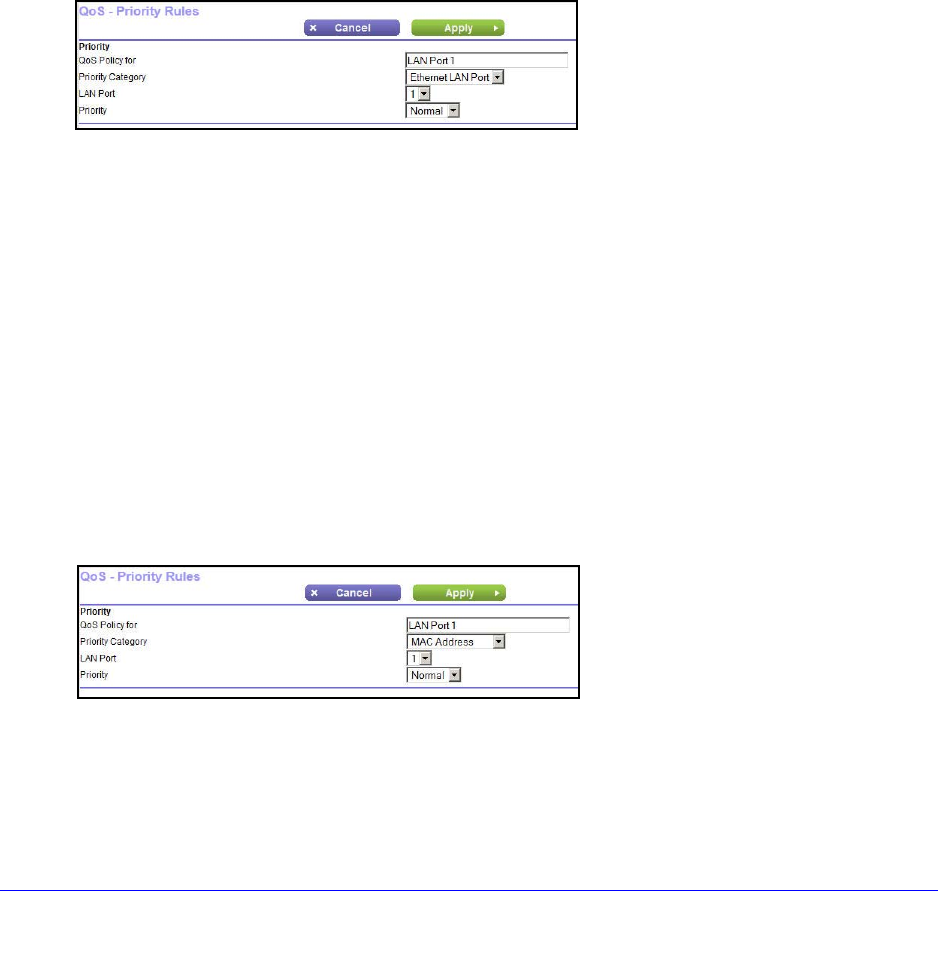
NETGEAR genie ADVANCED Home
59
D6200 WiFi Modem Router
7. From the Priority list, select the priority that this traffic should receive relative to other
applications and traffic when accessing the Internet. The options are Low, Normal, High, and
Highest.
8. Click Apply to save this rule to the QoS Policy list and return to the QoS Setup screen.
QoS for a WiFi Modem Router LAN Port
To create a QoS policy for a device connected to one of the WiFi modem router’s LAN
ports:
1. Select ADVANCED > Setup > QoS Setup to display the QoS Setup screen. Select the
Turn Internet Access QoS On check box.
2. Click the Setup QoS Rule button.
3. Click the Add Priority Rule button.
4. From the Priority Category list, select Ethernet LAN Port, as shown in the following figure:
5. From the LAN port list, select the LAN port that has a QoS policy.
6. From the Priority list, select the priority that this port’s traffic should receive relative to other
applications and traffic when accessing the Internet. The options are Low, Normal, High, and
Highest.
7. Click Apply to save this rule to the QoS Policy list and return to the QoS Setup screen.
8. In the QoS Setup screen, click Apply.
QoS for a MAC Address
To create a QoS policy for traffic from a specific MAC address:
1. Select ADVANCED > Setup > QoS Setup, and click the Setup QoS Rule button. The
QoS Setup screen displays.
2. Click Add Priority Rule.
3. From the Priority Category list, select MAC Address to display the following screen:
4. From the Priority list, select the priority that this device’s traffic should receive relative to
other applications and traffic when accessing the Internet. The options are Low, Normal,
High, and Highest. Click Add to add this rule to MAC Device List.
5. Click Apply to save this rule to the QoS Policy list and return to the QoS Setup screen.
6. In the QoS Setup screen, select the Turn Internet Access QoS On check box.

NETGEAR genie ADVANCED Home
60
D6200 WiFi Modem Router
7. Click Apply.
Edit or Delete an Existing QoS Policy
To edit or delete a QoS policy:
1. Select ADVANCED > QoS Setup to display the QoS Setup screen.
2. Select the radio button next to the QoS policy to be edited or deleted, and do one of the
following:
•Click Delete to remove the QoS policy.
•Click Edit to edit the QoS policy. Follow the instructions in the preceding sections to
change the policy settings.
3. Click Apply in the QoS Setup screen to save your changes.
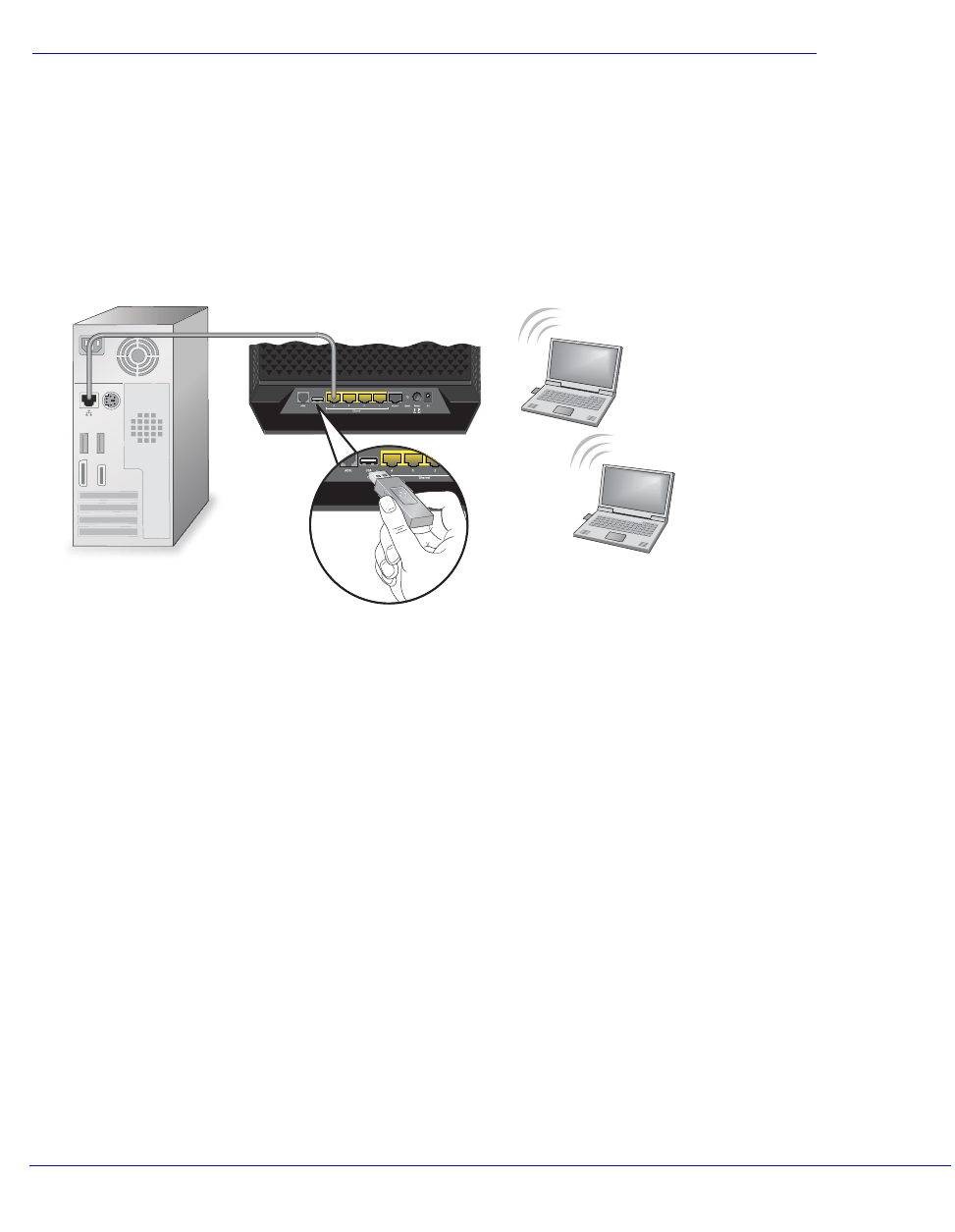
61
5
5. USB Storage
Access and configure a USB storage drive
This chapter describes how to access and configure a USB storage drive attached to your WiFi
modem router. The USB port on the WiFi modem router can connect only to USB storage
devices like flash drives or hard drives. Do not connect computers, USB modems, printers, CD
drives, or DVD drives to the WiFi modem router USB port.
This chapter contains the following sections:
•USB Drive Requirements
•ReadySHARE Access
•File-Sharing Scenarios
•USB Storage Basic Settings
•USB Storage Advanced Settings
•Safely Remove a USB Drive
•Media Server Settings
•Specify Approved USB Devices
•Connect to the USB Drive from a Remote Computer

USB Storage
62
D6200 WiFi Modem Router
USB Drive Requirements
The WiFi modem router works with 1.0 and 1.1 (USB Full Speed) and 2.0 (USB High Speed)
standards. The approximate USB bus speeds are shown in the following table. Actual bus
speeds can vary, depending on the CPU speed, memory, speed of the network, and other
variables.
Table 9. USB drive speeds
Bus Speed/Sec
USB 1.1 12 Mbits
USB 2.0 480 Mbits
The WiFi modem router should work with most USB-compliant external flash and hard drives.
For the most up-to-date list of USB drives supported by the WiFi modem router, visit:
http://kbserver.netgear.com/readyshare
The WiFi modem router supports both read and write access for FAT16, FAT32, NTFS, and
Linux file systems (EXT2 and EXT3).
Note: Some USB external hard drives and flash drives require drivers to
be loaded into the computer before the computer can access the
USB device. Such USB devices do not work with the WiFi modem
router.
ReadySHARE Access
Once you have set up your WiFi modem router, you can connect any USB storage device
and share the contents with other users on your network.
You can access your USB device in any of the following ways:
•On Windows 7, Windows XP, Windows Vista, and Windows 2000 systems, select Start >
Run and enter \\readyshare in the dialog box. Click OK.
•On Windows 7, Windows XP, Windows Vista, and Windows 2000 systems, open either
Internet Explorer or Safari, and enter \\readyshare in the address bar.
•On Mac OS X (version 10.2 or later), enter smb://readyshare in the address bar.
•In My Network Places, enter \\readyshare in the address bar.

USB Storage
63
D6200 WiFi Modem Router
File-Sharing Scenarios
You can share files on the USB drive for a wide variety of business and recreational
purposes. The files can be any Windows, Mac, or Linux file type including text, Word,
PowerPoint, Excel, and MP3 files, pictures, and multimedia. USB drive applications include:
•Sharing multimedia such as MP3 files, pictures, and other multimedia with local and
remote users.
•Sharing resources on your network. You might want to store files in a central location so
that you do not need to power up a computer to perform local sharing. In addition, you
can share files between Macintosh, Linux, and Windows computers by using the USB
drive as a go-between across the systems.
•Sharing files such as Word documents, PowerPoint presentations, and text files with
remote users.
A few common uses are described in the following sections.
Share Photos
You can create your own central storage location for photos and multimedia. This approach
eliminates the need to log in to (and pay for) an external photo-sharing site.
To share files with your friends and family:
1. Insert your USB drive into the USB port on the WiFi modem router either directly or with
a USB cable.
Computers on your local area network (LAN) can automatically access this USB drive
using a web browser or Microsoft Networking.
2. If you want to specify read-only access or to allow access from the Internet, see USB
Storage Advanced Settings on page 67.
Store Files in a Central Location for Printing
This scenario is for a family that has one high-quality color printer directly attached to a
computer, but not shared on the local area network (LAN). This family does not have a print
server.
•One family member has photos on a Macintosh computer that she wants to print.
•The photo-capable color printer is directly attached to a computer, but not shared on the
network.
•The Mac and Windows computer are not visible to each other on the network.
To print photos from a Mac on the printer attached to a Windows computer:
1. On the Mac, access the USB drive by typing \\readyshare in the address field of a web
browser. Then copy the photos to the USB drive.
2. On the Windows computer, use a web browser or Microsoft Networking to copy the files
from the USB drive to the Windows computer. Then print the files.

USB Storage
64
D6200 WiFi Modem Router
Share Large Files over the Internet
Sending files that are larger than 5 MB can pose a problem for many email systems. The
WiFi modem router allows you to share large files such as PowerPoint presentations or .zip
files over the Internet. FTP can be used to easily download shared files from the WiFi modem
router.
Sharing files with a remote colleague involves the following considerations:
•There are two user accounts: admin and guest. The password for admin is the same one
that you use to access the WiFi modem router. By default, it is password. The guest user
account has no password.
•On the FTP site, the person receiving the files should use the guest user account and
enter any password (FTP requires that you type something in the password field).
•Be sure to select the FTP (via Internet) check box in the USB Storage Advanced
Settings screen. This option supports both downloading and uploading of files.
Note: You can enable the HTTP (via Internet) option on the USB Storage
(Advanced Settings) screen to share large files. This option supports
downloading files only.
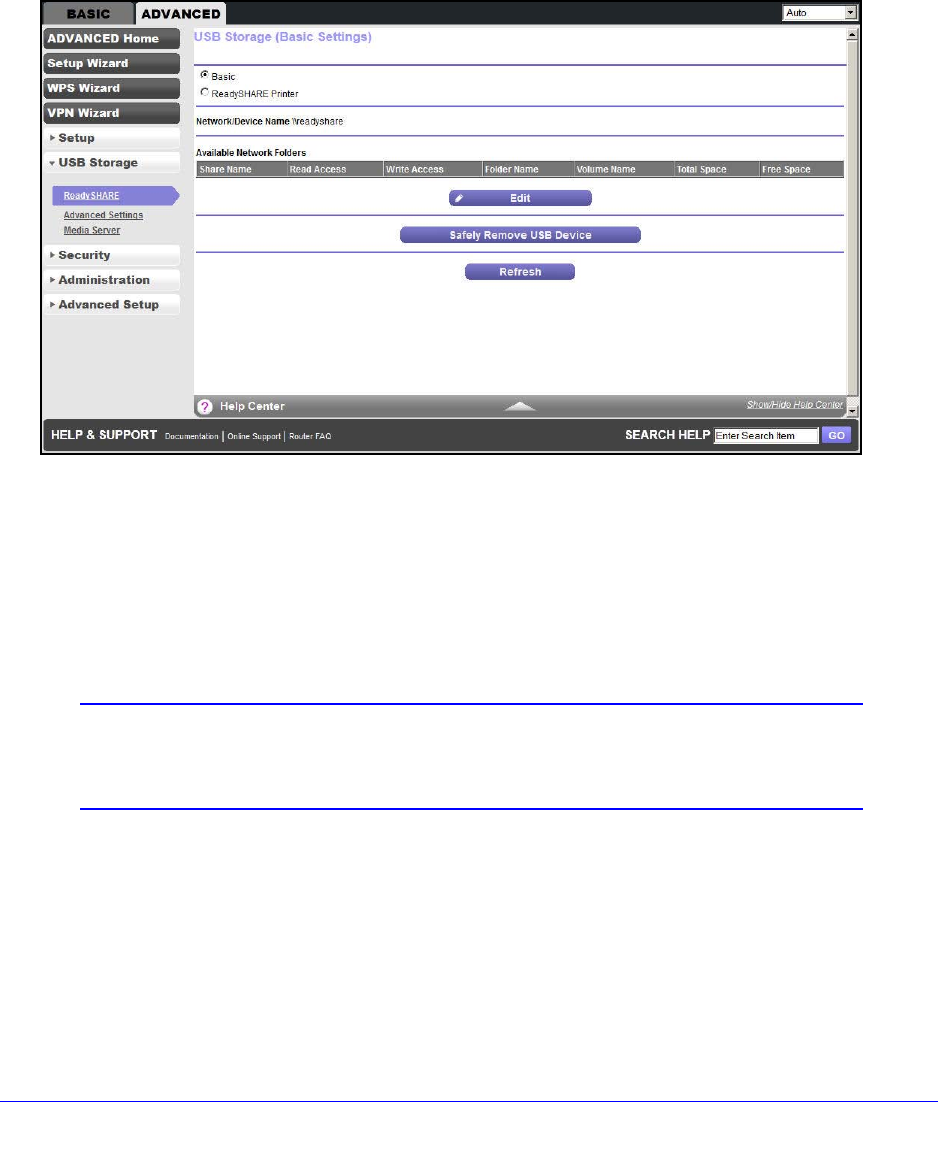
USB Storage
65
D6200 WiFi Modem Router
USB Storage Basic Settings
You can view or edit basic settings for the USB storage device attached to your WiFi modem
router.
You can access this feature by selecting BASIC > ReadySHARE, or ADVANCED > USB
Storage > ReadySHARE. The USB Storage (Basic Settings) screen displays:
By default, the USB storage device is available to all computers on your local area network
(LAN).
To access your USB device:
1. Click the network device name or the share name in your computer’s network folders
list.
2. For SMB://readyshare, click Connect.
Note: If you logged in to the WiFi modem router before you connected
your USB device, you might not see your USB device in the WiFi
modem router screens until you log out and then log back in again.
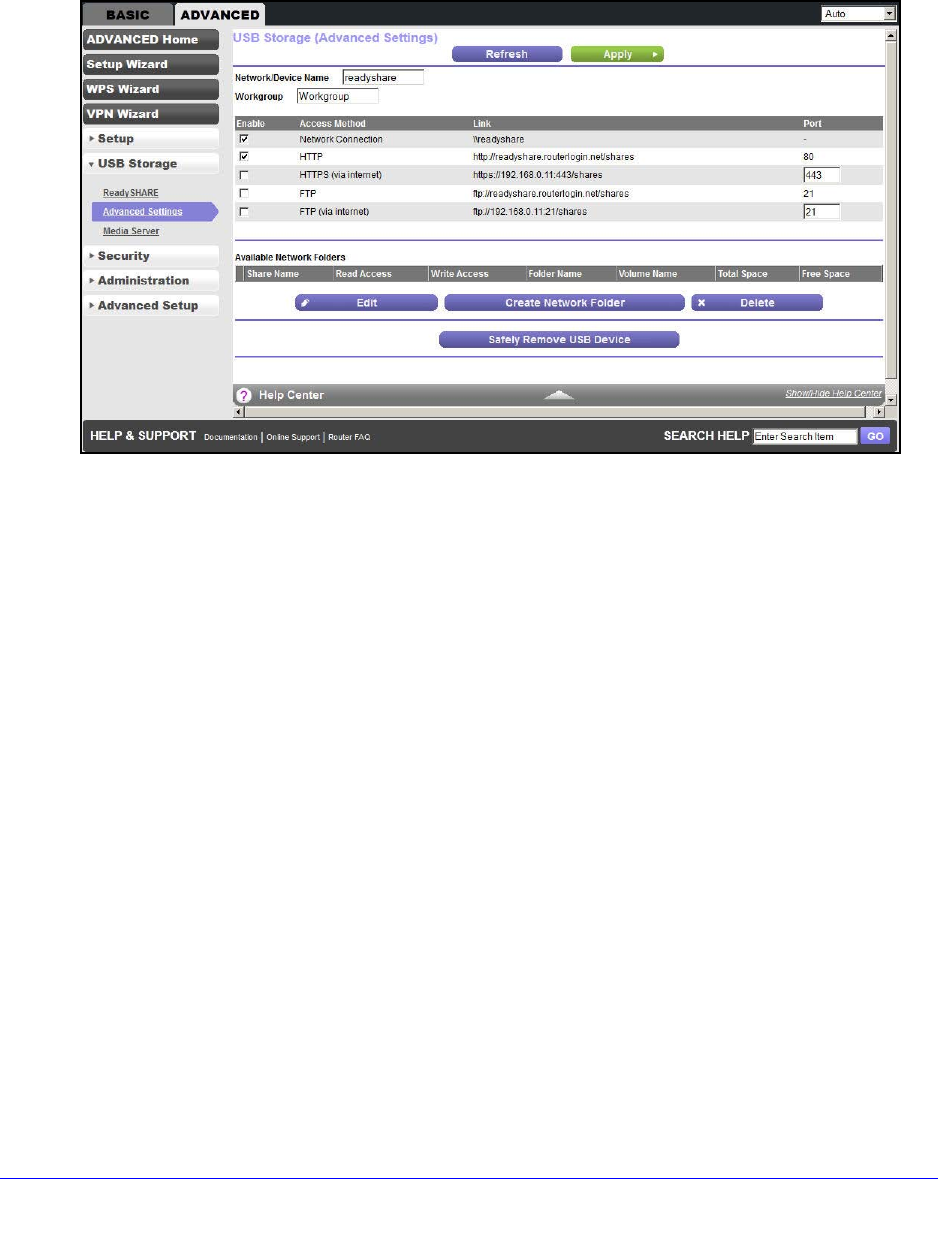
USB Storage
66
D6200 WiFi Modem Router
Add or Edit a Network Folder
1. You can access this feature by selecting BASIC > ReadyShare > Edit, or ADVANCED
> USB Storage > Advanced Settings.
2. Specify the changes that you want to make:
•To add a folder, click Create Network Folder.
•To edit a folder, select its radio button and click Edit.
3. You can use this screen to select a folder, to change the share name, or to change the read
access or write access from All - no password to admin.
The user name (account name) for All - no password is guest. The password for admin is
the same one that is used to log in to the WiFi modem router. By default, it is password.
4. Click Apply for your changes to take effect.
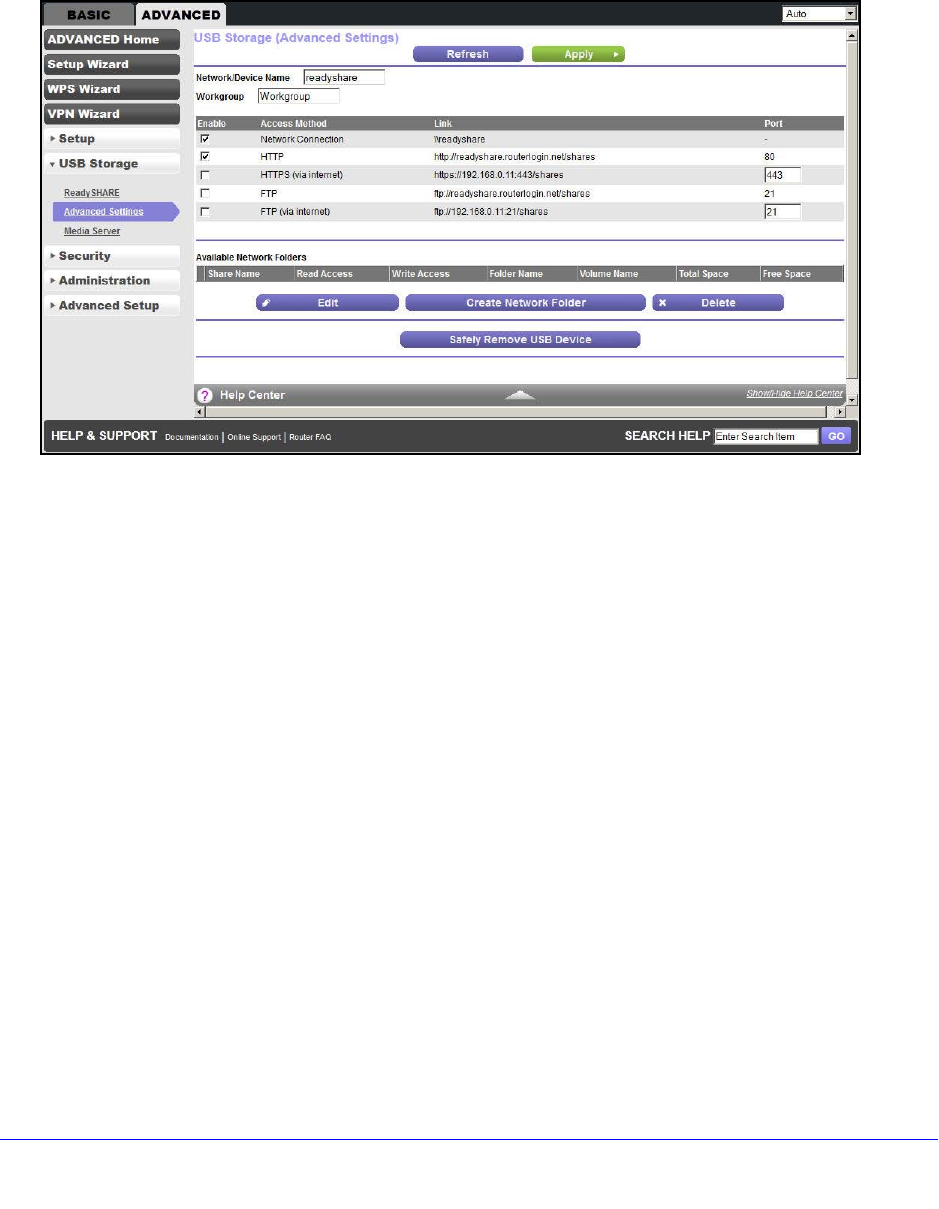
USB Storage
67
D6200 WiFi Modem Router
USB Storage Advanced Settings
You can set up the device name, workgroups, and network folders for your USB device. On
the Advanced tab, select USB Storage > Advanced Settings to display the following
screen:
You can use this screen to specify access to the USB storage device.
•Network Device Name. The default is ReadySHARE. This name is used to access the
USB device connected to the WiFi modem router.
•Workgroup. If you are using a Windows workgroup rather than a domain, the workgroup
name is displayed here. The name works only in an operating system that supports
NetBIOS, such as Microsoft Windows.
•Access Method. The access methods are described here.
-Network Connection. Enabled by default, this connection allows all users on the
LAN to have access to the USB drive.
-HTTP. Enabled by default. You can type http://readyshare.routerlogin.net/shares
to access the USB drive.
-HTTP (via internet). Disabled by default. If you enable this setting, remote users can
type http://<public IP address>/shares (for example, http://1.1.10.102/shares) or a
URL domain name to access the USB drive over the Internet. This setting supports
file uploading only.
-FTP. Disabled by default.
-FTP (via internet). Disabled by default. If you enable this setting, remote users can
access the USB drive through FTP over the Internet. This setting supports both
downloading and uploading of files.

USB Storage
68
D6200 WiFi Modem Router
Available Network Folders
You might need to scroll down to view this section of the screen:
•Share Name. If only one device is connected, the default share name is USB_Storage.
You can click the name shown, or you can type it in the address field of your web browser.
If Not Shared is shown, the default share was deleted and no other share for the root
folder exists. Click the link to change this setting.
•Read Access and Write Access. Show the permissions and access controls on the
network folder: All - no password (the default) allows all users to access the network
folder. The password for admin is the same one that you use to log in to the WiFi modem
router.
•Folder Name. Full path used by the network folder.
•Volume Name. Volume name from the storage device (either USB drive or HDD).
•Total Space and Free Space. Show the current utilization of the storage device.
Safely Remove a USB Drive
To safely remove a USB disk drive so that no users can access it, select USB Storage >
Basic Settings, or ADVANCED > USB Storage > Advanced Settings, and click the Safely
Remove USB Device button. This procedure takes the drive offline.
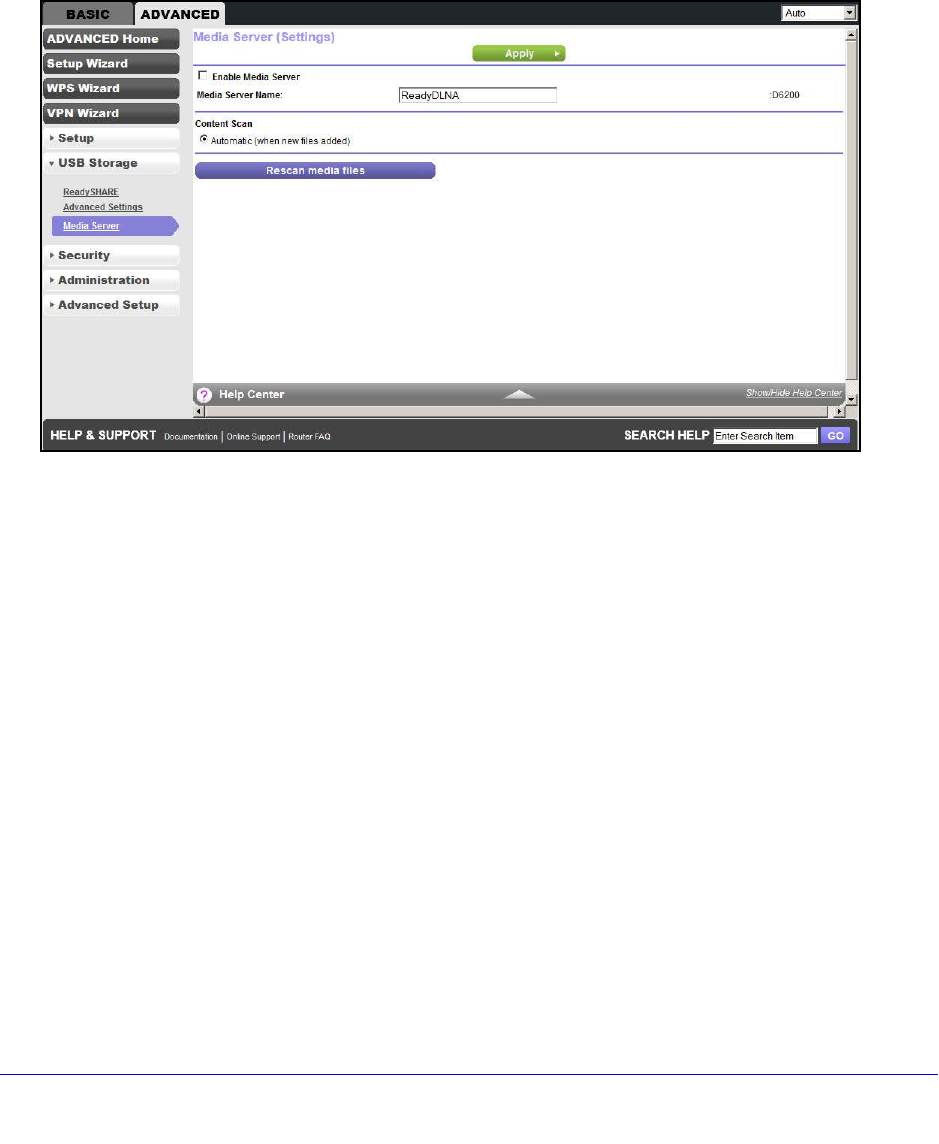
USB Storage
69
D6200 WiFi Modem Router
Media Server Settings
By default, the WiFi modem router is set up to act as a ReadyDLNA media server, which lets
you view movies and photos on DLNA/UPnP AV–compliant media players, such as Xbox360,
Playstation, and NETGEAR’s Digital Entertainer Live.
To view these settings, select ADVANCED > USB Storage > Media Server to display the
following screen:
By default the Enable Media Server check box and the Automatic (when new files are added)
radio button are selected. When these options are selected, the WiFi modem router scans for
media files whenever new files are added to the ReadySHARE USB hard drive.
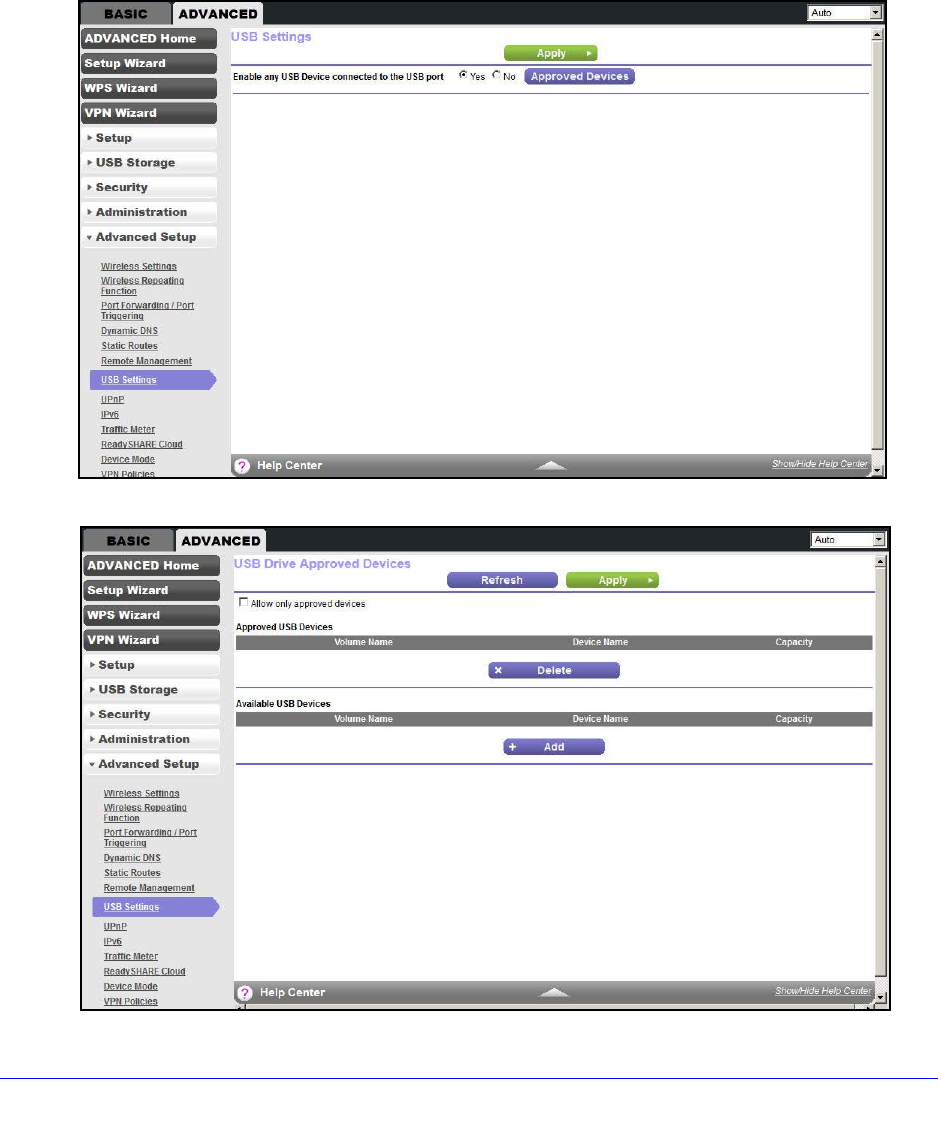
USB Storage
70
D6200 WiFi Modem Router
Specify Approved USB Devices
For more security, you can set up the WiFi modem router to share approved USB devices
only. You can access this feature from the Advanced Setup menu on the Advanced tab.
To set up approved USB devices:
1. Select ADVANCED > Advanced Setup > USB Settings. The following screen displays:
2. Click the Approved Devices button. The USB Drive Approved Devices screen displays:

USB Storage
71
D6200 WiFi Modem Router
This screen shows the approved USB devices and the available USB devices. You can
remove or add approved USB devices.
3. To add an approved USB device, select it from the Available USB Devices list and click
Add.
4. Select the Allow only approved devices check box.
5. Click Apply so that your change takes effect.
If you want to work with another USB device, you have to click the Safely Remove USB
Device button for the currently connected USB device. Connect the other USB device and
repeat this process.
Connect to the USB Drive from a Remote Computer
To connect to the USB drive from remote computers with a web browser, you have to use the
WiFi modem router’s Internet port IP address. If you are using Dynamic DNS, you can type
the DNS name rather than the IP address. You can view the WiFi modem router’s Internet IP
address from the dashboard on the BASIC Home screen or the ADVANCED Home screen.
Access the WiFi Modem Router USB Drive Remotely Using FTP
To connect to the WiFi modem router’s USB drive using a web browser:
1. Connect to the WiFi modem router by typing ftp:// and the Internet port IP address in
the address field of Internet Explorer or Netscape Navigator, for example:
ftp://10.1.65.4
If you are using Dynamic DNS, you can type the DNS name rather than the IP address.
2. Type the account name and password for the account that has access rights to the USB
drive. The user name (account name) for All - no password is guest.
3. The directories of the USB drive that your account can access are displayed, for example,
share/partition1/directory1. You can now read and copy files from the USB directory.
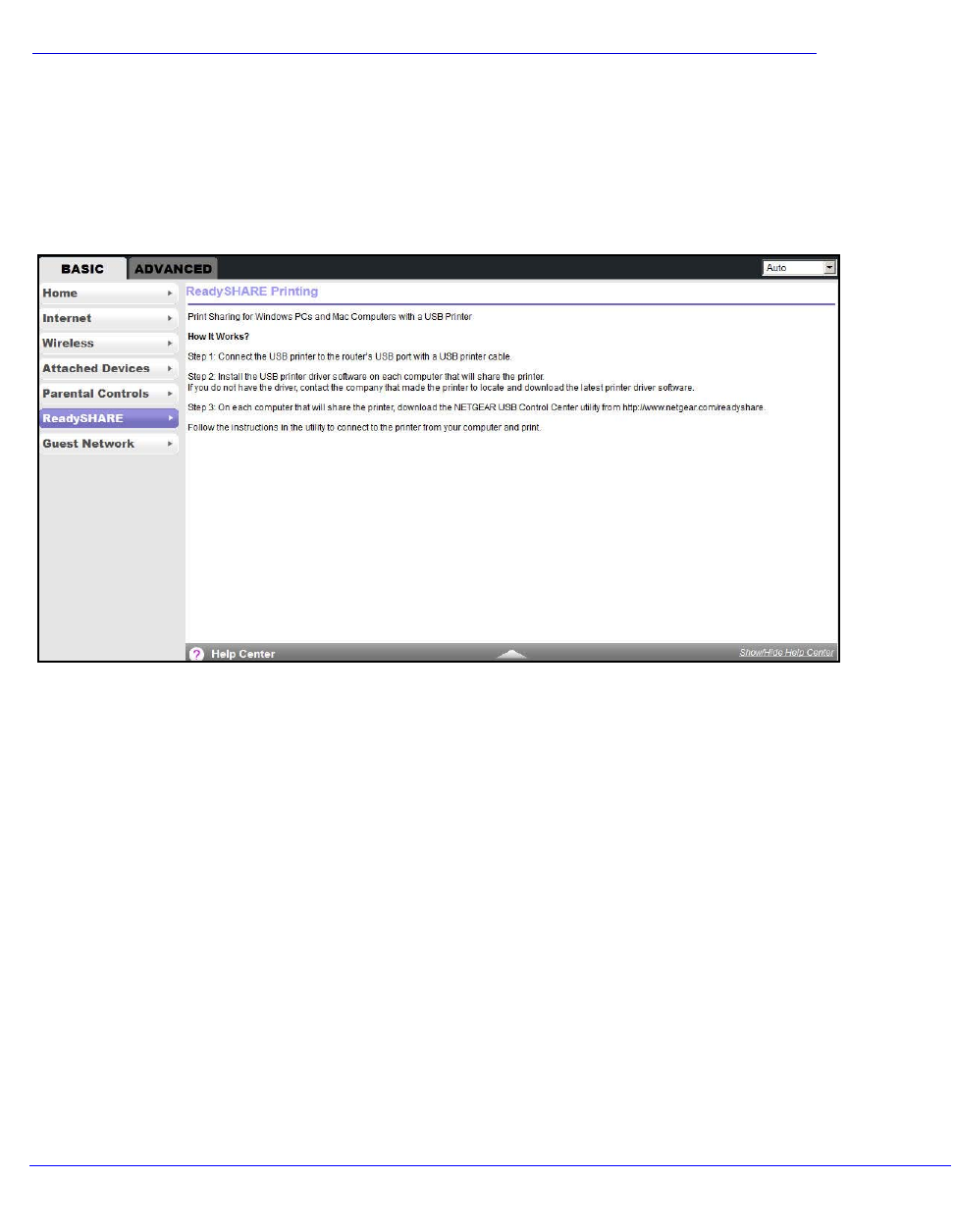
72
6
6. USB Printer Control
Access and configure a USB printer
This chapter describes how to access and configure a USB printer attached to your WiFi modem
router.
The USB Control Center utility allows you to control a shared USB device such as a printer from
your computer that is connected to the USB port on your router.
The utility has to be installed on each computer on your network from which you want to control
the device. You can download this utility at www.netgear.com/landing/en-us/readyshare.aspx.
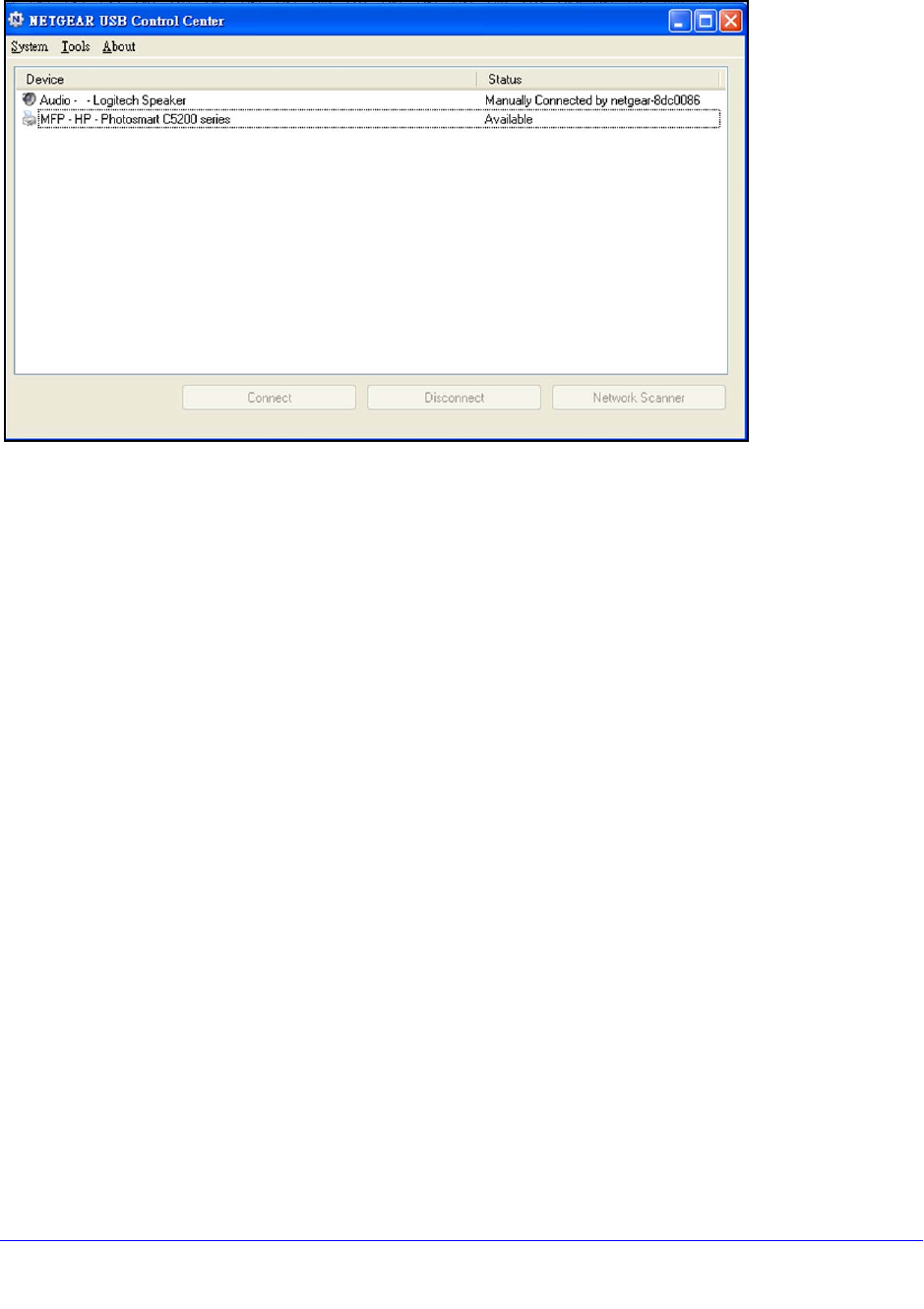
USB Printer Control
73
D6200 WiFi Modem Router
When you launch the USB Control Center Utility, a screen similar to the following displays:
This screen is the main screen, which shows a device icon, the description for this USB device,
and its status.
•Available. The device is available from the computer that you are using.
•Waiting to Connect. You need to connect to this device from the computer that you are
using. If you are connecting for the first time, you might be prompted to install the device
driver.
The following menu selections are available:
•System. Exit the utility.
•Tools. Access the Control Center Configuration to set up your shared USB device. See
the following section, Control Center Configuration.
•About. View details about the USB Control Center software.
This chapter includes the following sections:
•Control Center Configuration
•USB Printer
•Scan with a Multifunction Printer
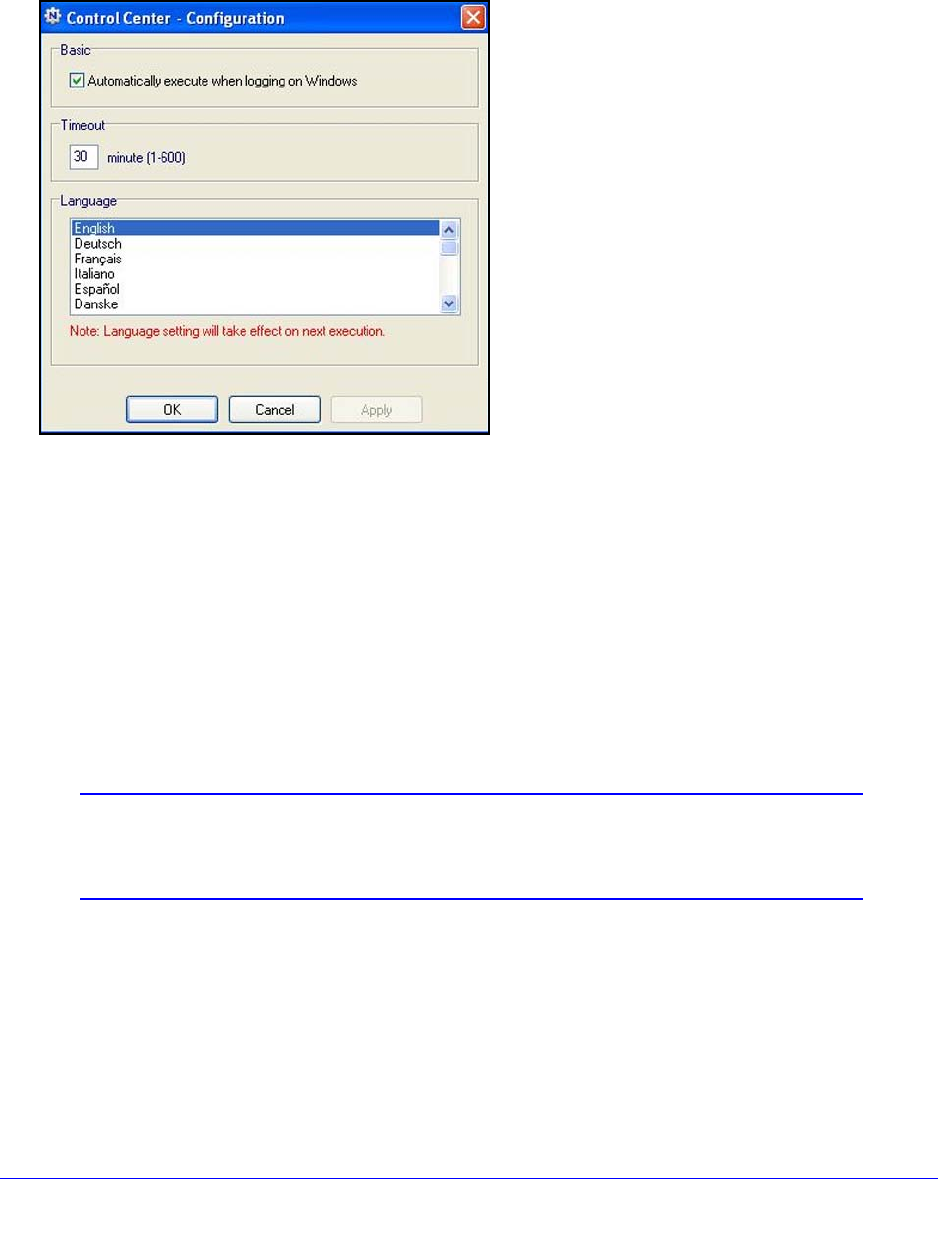
USB Printer Control
74
D6200 WiFi Modem Router
Control Center Configuration
Select Tools > Configuration to display the following screen:
Automatically execute when logging on Windows. Select this check box to have the utility
start automatically when you are logged in to Windows.
Timeout. Specify the time-out value for holding the USB resource when it is not in use.
Language. Select the display language for this utility.
USB Printer
The first time you use a printer, you need to click Connect. You might be asked to install the
driver for this printer. After the driver is installed, the printer status changes to Available.
Note: Some USB printers (for example, HP and Lexmark printer) request
that you do not connect the USB cable until the installation software
prompts you.
If the USB printer is detected and connected automatically, you need to disconnect the printer
and wait for the prompt asking you to click Connect.
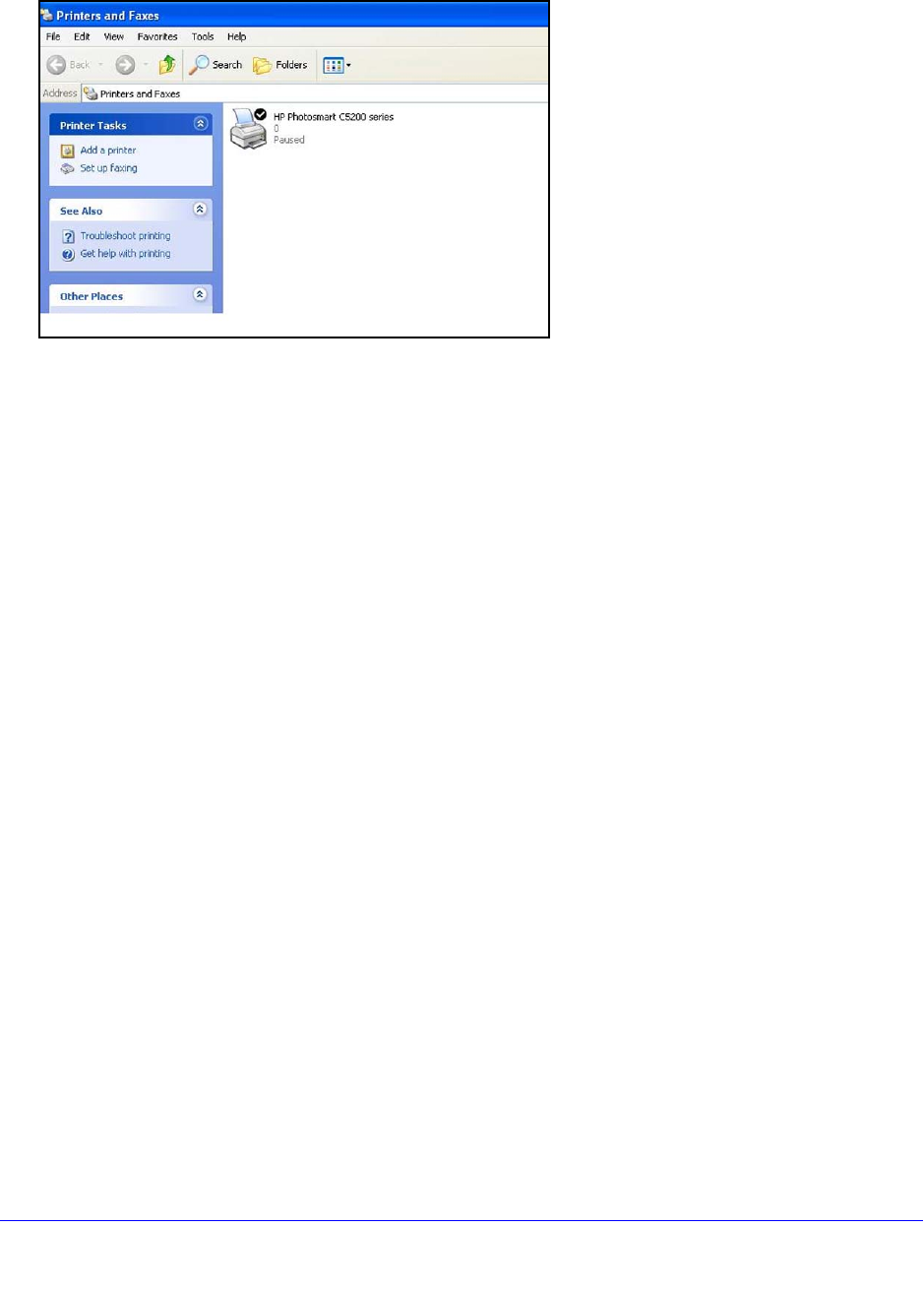
USB Printer Control
75
D6200 WiFi Modem Router
Once the printer shows Available status, the grayed out Paused state no longer displays in
the Windows Printers and Faxes window.
This USB printer is ready. The utility does not need to always hold the connection of this USB
printer. After a print job is created for this printer, the USB utility connects to this USB printer
automatically and prints. After the print job is done, the printer status returns to the Paused
state.
Scan with a Multifunction Printer
You can use the scan feature of a multifunction printer.
1. Make sure that the printer’s status shows as Available.
2. Click the Network Scanner button.
This procedure activates the scanner window that is used to perform the scans.

76
7
7. Security
Keep unwanted content out of your network
This chapter explains how to use the basic firewall features of the WiFi modem router to prevent
objectionable content from reaching the computers and other devices connected to your
network.
This chapter includes the following sections:
•Keyword Blocking of HTTP Traffic
•Firewall Rules
•Add Custom Services to Allow or Block
•Schedule for Firewall Rules
•Security Event Email Notifications
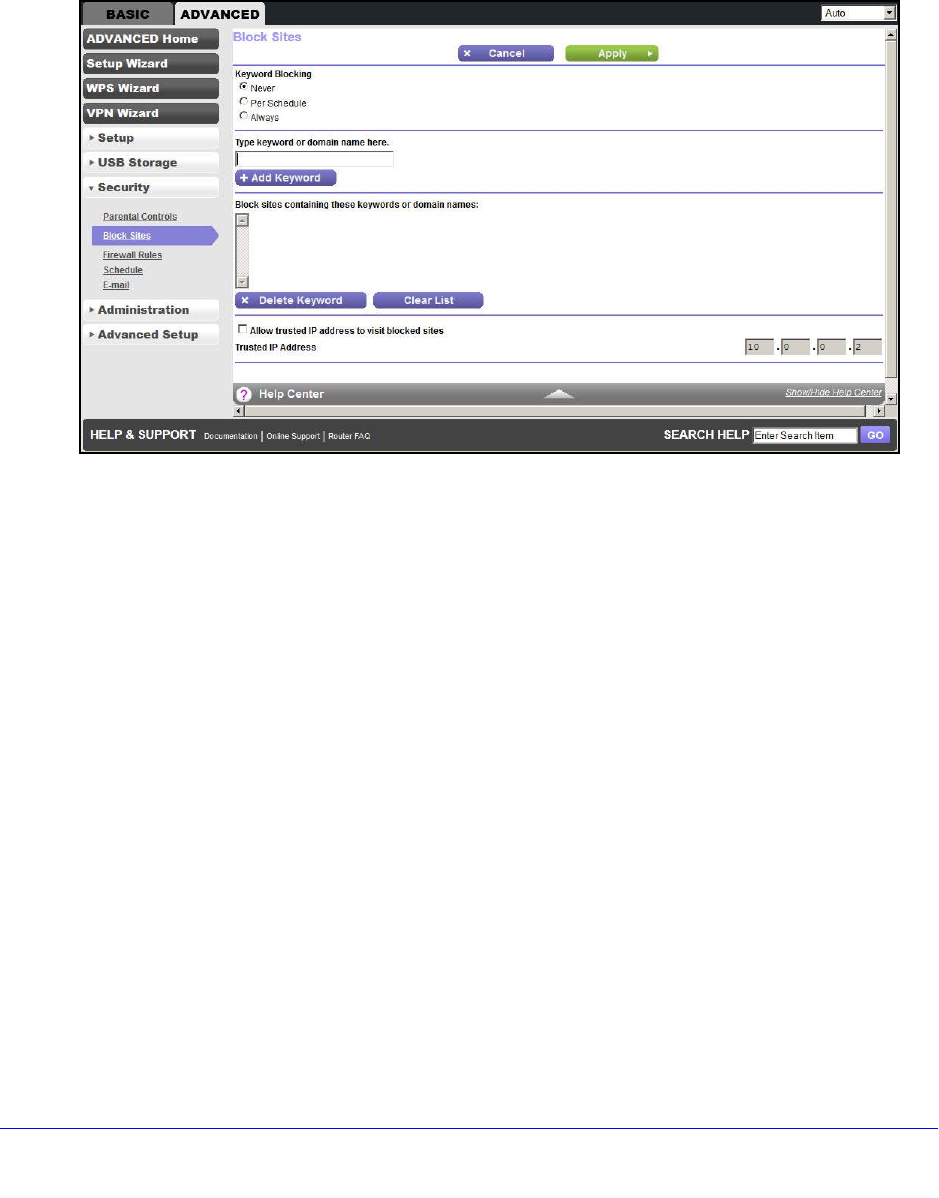
Security
77
D6200 WiFi Modem Router
Keyword Blocking of HTTP Traffic
Use keyword blocking to prevent certain types of HTTP traffic from accessing your network.
The blocking can be always or according to a schedule.
1. Select ADVANCED > Security > Block Sites to display the following screen:
2. Select one of the keyword blocking options:
•Per Schedule. Turn on keyword blocking according to the Schedule screen settings.
•Always. Turn on keyword blocking all the time, independent of the Schedule screen.
3. In the Keyword field, enter a keyword or domain, click Add Keyword, and click Apply.
The Keyword list supports up to 32 entries. Here are some sample entries:
•Specify XXX to block http://www.badstuff.com/xxx.html.
•Specify .com if you want to allow only sites with domain suffixes such as .edu or .gov.
•Enter a period (.) to block all Internet browsing access.
To delete a keyword or domain:
1. Select the keyword you want to delete from the list.
2. Click Delete Keyword and then Apply to save your changes.
To specify a trusted computer:
You can exempt one trusted computer from blocking and logging. The computer you exempt
must have a fixed IP address.
1. In the Trusted IP Address field, enter the IP address.
2. Click Apply to save your changes.
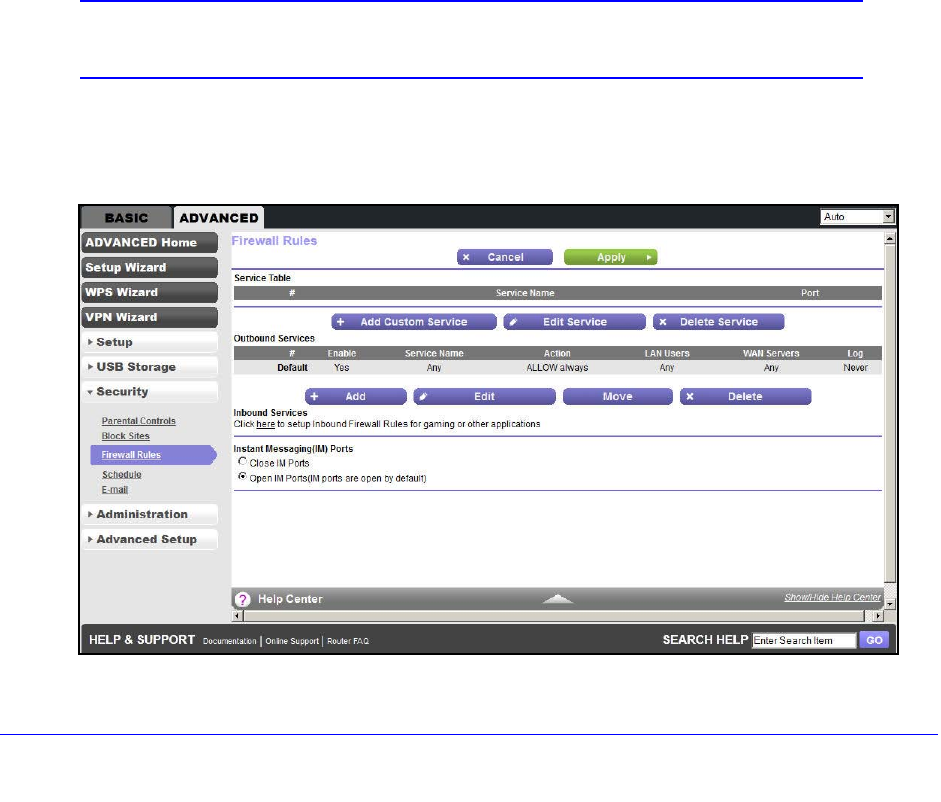
Security
78
D6200 WiFi Modem Router
Firewall Rules
Services are functions performed by server computers at the request of client computers. For
example, web servers serve web pages, time servers serve time and date information, and
game hosts serve data about other players’ moves. When a computer on the Internet sends a
request for service to a server computer, the requested service is identified by a service or
port number. This number appears as the destination port number in the transmitted IP
packets. For example, a packet that is sent with the destination port number 80 is an HTTP
(web server) request.
The service numbers for many common protocols are defined by the Internet Engineering
Task Force (IETF at http://www.ietf.org/) and published in RFC1700, “Assigned Numbers.”
Service numbers for other applications are typically chosen from the range 1024–65535 by
the authors of the application. Although the WiFi modem router already holds a list of many
service port numbers, you are not limited to these choices. You can often determine port
number information by contacting the publisher of the application, by asking user groups or
newsgroups, or by searching.
The Firewall Rules screen lets you block or allow specific Internet traffic services by
computers on your network. This process is called service blocking or port filtering.
Note: This feature is for Advanced Administrators only! Incorrect
configuration can cause serious problems.
To create firewall rules:
1. Select ADVANCED > Security > Firewall Rules to display the following screen:
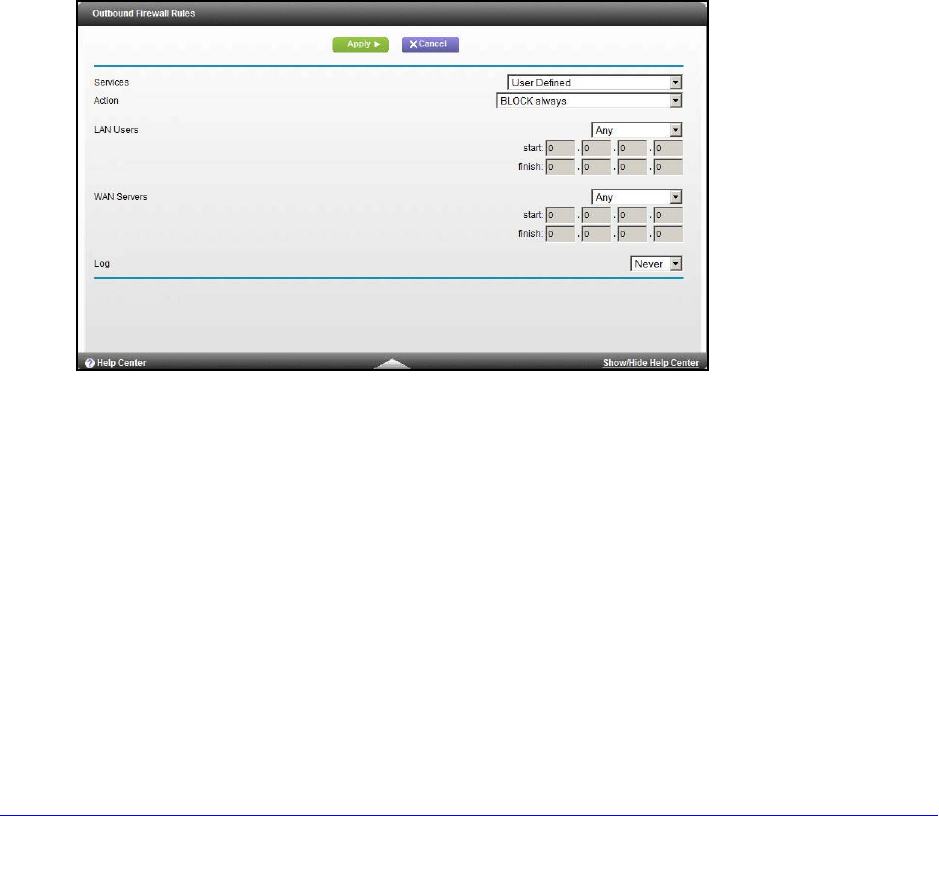
Security
79
D6200 WiFi Modem Router
The Firewall Rules screen lists all firewall rules that have been changed from their default
settings. The default rules allow all outgoing traffic and block all incoming traffic.
•To change the firewall rules for outbound traffic, you need to edit them from the
Outbound Services screen as described in Step 2.
•To change the firewall rules for inbound traffic, you need to edit them from the Port
Forwarding/Port Triggering screen as described in Port Forwarding and Triggering on
page 103.
The Outbound Services and Inbound Services screens list the available services you can
allow or block. You can also define your own custom services to allow or block with the
Add Service screen as described in Add Custom Services to Allow or Block on page 80.
Once you add your own custom services, they are available on the Outbound Services
and Inbound Services screens.
You can also specify whether these services are always allowed or blocked, or allowed or
blocked per schedule as described in Schedule for Firewall Rules on page 82.
2. Outbound Services. To allow or block an outbound service, click Add to display the
following screen:
Use the Outbound Services screen to define a new outbound firewall rule, or edit an
existing rule. The outbound firewall rules are used to block or allow access by computers
on your network to services or applications on the Internet.
a. Service. Select the service or application to be covered by this rule. If the service or
application you want does not appear in the list, you have to define it as described in
Add Custom Services to Allow or Block on page 80.
b. Action. Select the action you want for traffic covered by this rule:
•BLOCK always. Always block the traffic covered by this rule.
•BLOCK by schedule, otherwise Allow. Allow the traffic covered by this rule,
unless it is blocked according to the schedule specified on the Schedule screen in
Schedule for Firewall Rules on page 82.
•ALLOW always. Always allow the traffic covered by this rule (this selection is the
default setting).

Security
80
D6200 WiFi Modem Router
•ALLOW by schedule, otherwise Block. Block the traffic covered by this rule,
unless it is blocked according to the schedule specified on the Schedule screen in
Schedule for Firewall Rules on page 82.
ALLOW rules are useful only when the traffic is already covered by a BLOCK rule.
You would use these rules when you want to allow a subset of traffic that is blocked by
another rule.
c. LAN Users. These settings determine which computers on your network are
affected by this rule, based on their source (LAN) IP address. Select the option you
want:
•Any. All local IP addresses are covered by this choice.
•Address range. You have to provide the Start and End fields when this option is
selected.
•Single address. Enter the required address in the Start field.
d. WAN Servers. These settings determine which Internet locations are covered by the
rule, based on their destination (WAN) IP address. Select the option you want:
•Any. All Internet IP addresses are covered by this choice.
•Address range. You have to provide the Start and End fields when this option is
selected.
•Single address. Enter the required address in the Start field.
e. Log. This setting determines whether traffic covered by this rule is logged. Select the
action you want:
•Always. This choice always logs traffic that is covered by this rule, whether it
matches or not. (This feature is useful when you are debugging your rules.)
•Never. This choice never logs traffic covered by this rule, whether it matches or
not.
f. Click Apply to have your changes take effect, or click Cancel to return to the
previous screen.
3. Inbound Services. To allow or block an inbound service, click here to set up inbound
firewall rules for gaming or other applications. You are redirected to the Port Forwarding/Port
Triggering screen as described in Port Forwarding and Triggering on page 103.
4. Instant Messaging (IM) Ports. To close or open the instant messaging ports, select the
appropriate radio button:
•Close IM Ports
•Open IM Ports (IM ports are open by default)
5. Click Apply to enable your Firewall Rules selections.
Add Custom Services to Allow or Block
You can define your own incoming and outgoing custom services to allow or block. Once you
add your own custom services, they are available on the Outbound Services screen (as
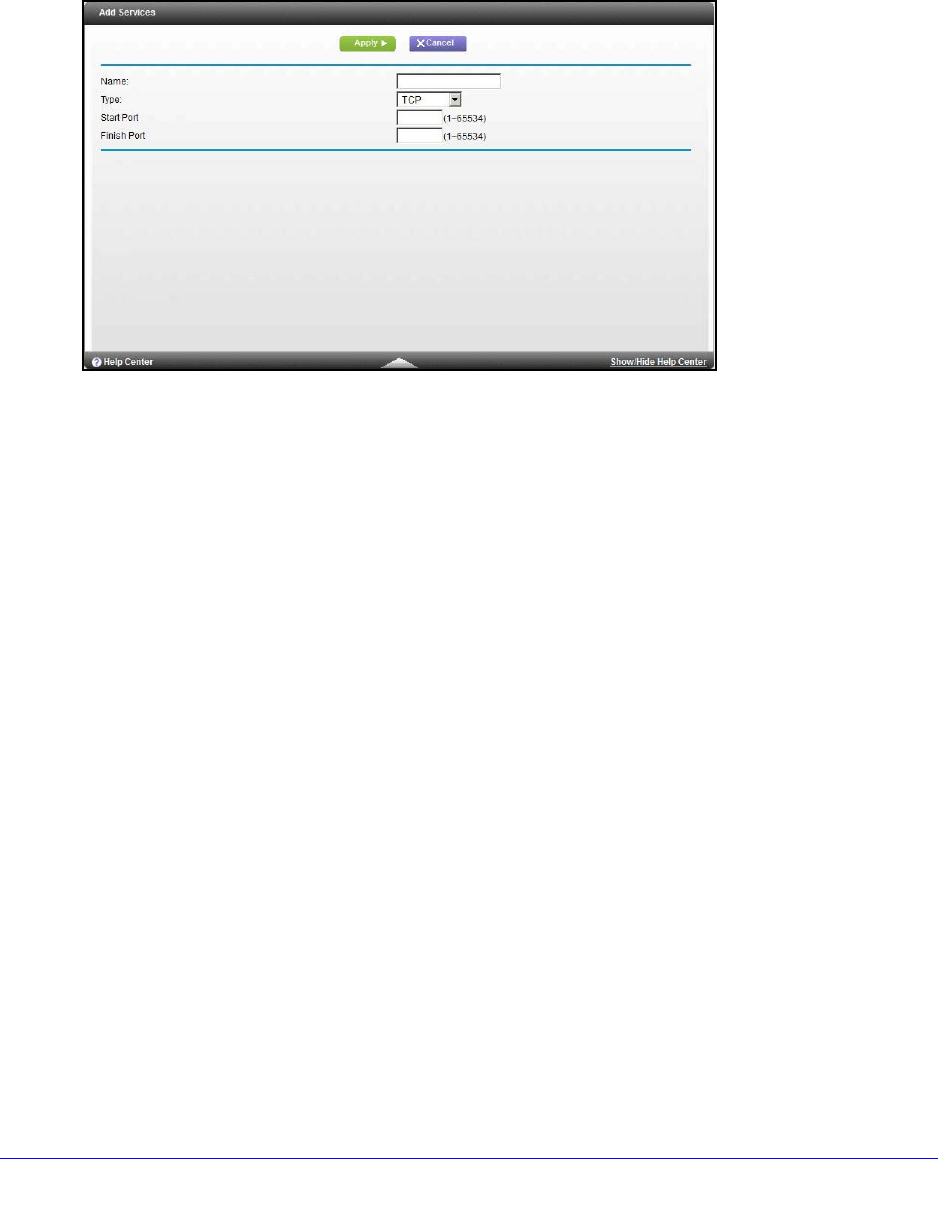
Security
81
D6200 WiFi Modem Router
described in Firewall Rules on page 78) and the Inbound Services screen (as described in
Port Forwarding and Triggering on page 103).
To add a custom service:
1. Click Add Custom Service to add a service. The Add Service screen displays:
The Add Service screen allows you to specify or edit your own custom service definition.
You can then use the custom service when creating firewall rules.
2. To add a service for blocking, first determine which port number or range of numbers is used
by the application.
3. In the Name field, enter a suitable name for this service.
4. In the Type list, select the correct type for this service (if in doubt, select TCP/UDP):
•TCP
•UDP
•TCP/UDP
5. Enter the starting and ending port numbers. If the application uses a single port number,
enter that number in both fields.
6. Click Apply to save your information and return to the previous screen.
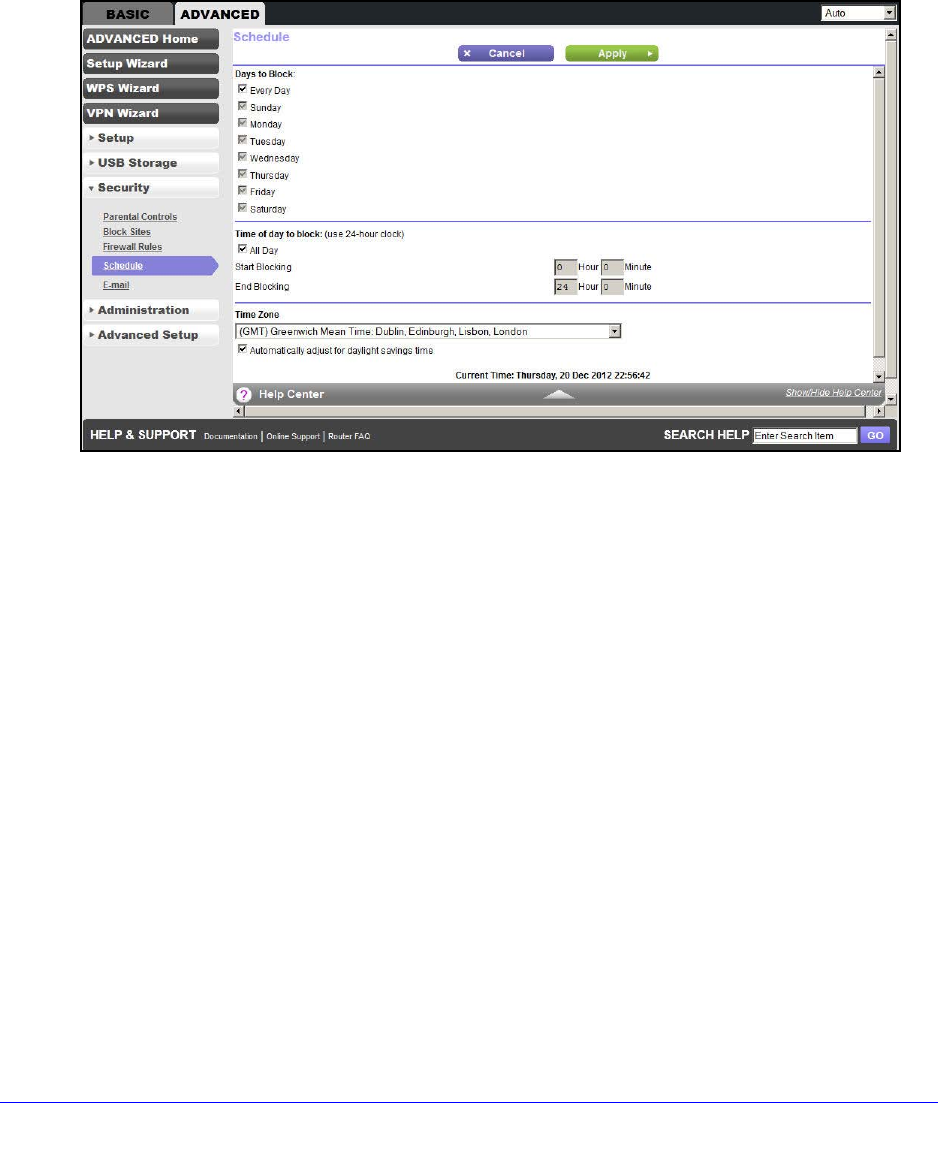
Security
82
D6200 WiFi Modem Router
Schedule for Firewall Rules
You can specify the days and time that you want to block Internet access.
To specify the firewall rule schedule:
1. Select ADVANCED > Security > Schedule to display the following screen:
2. Set up the schedule for blocking keywords and services.
•Days to Block. Select days on which you want to apply blocking by selecting the
appropriate check boxes, or select Every Day to select the check boxes for all days.
•Time of Day to Block. Select a start and end time in 24-hour format, or select All
Day for 24-hour blocking.
3. Select your time zone from the list. If you use daylight saving time, select the Automatically
adjust for daylight savings time check box.
4. Click Apply to save your settings.
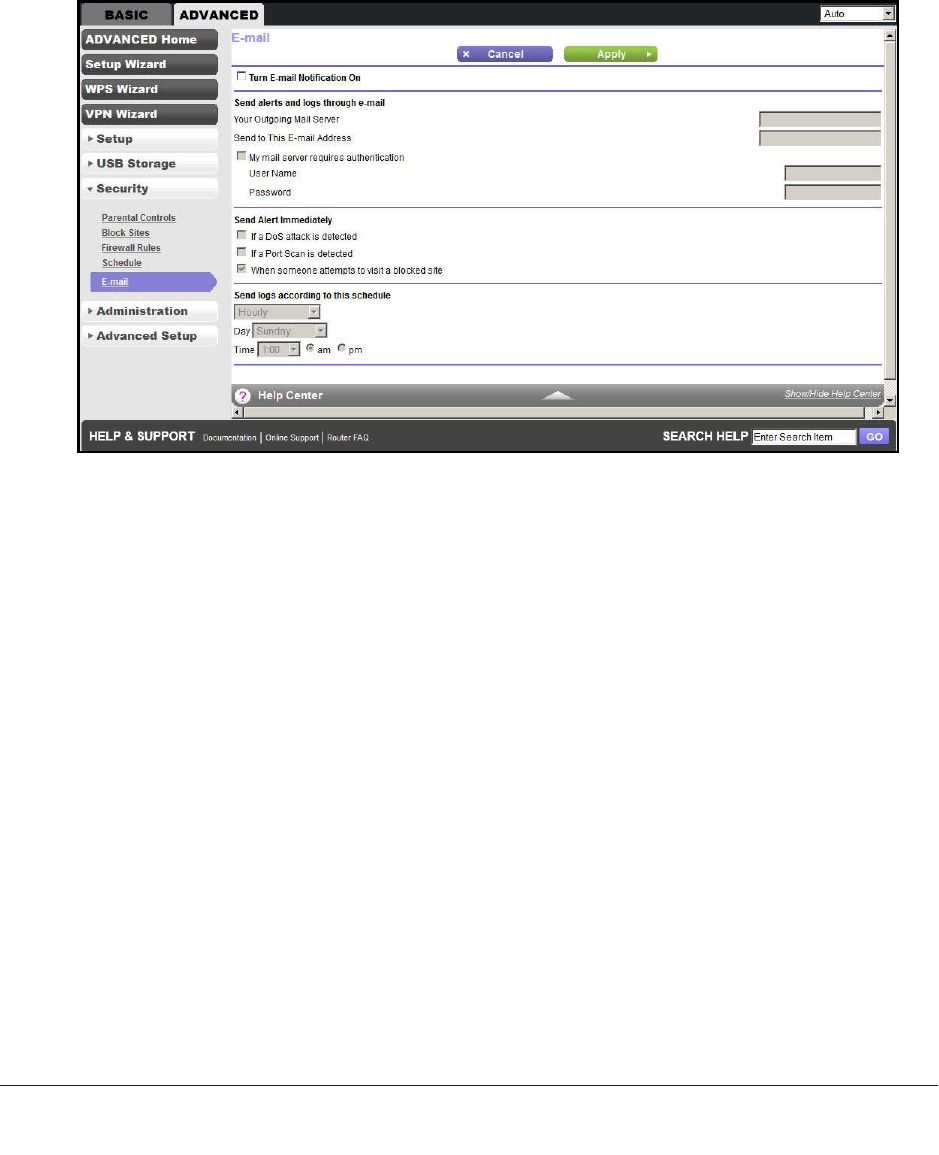
Security
83
D6200 WiFi Modem Router
Security Event Email Notifications
To receive logs and alerts by email, provide your email information in the E-mail screen and
specify which alerts you want to receive and how often.
To set up email notifications:
1. Select ADVANCED > Security > E-mail to display the following screen:
2. To receive email logs and alerts from the WiFi modem router, select the Turn E-mail
Notification On check box.
3. In the Your Outgoing Mail Server field, enter the name of your ISP outgoing (SMTP) mail
server (such as mail.myISP.com). You might be able to find this information in the
configuration screen of your email program. When you leave this field blank, log and alert
messages are not sent by email.
4. In the Send to This E-mail Address field, enter the email address to which logs and alerts
are sent. This email address is also used for the From address. When you leave this field
blank, log and alert messages are not sent by email.
5. If your outgoing email server requires authentication, select the My Mail Server requires
authentication check box. Fill in the User Name and Password fields for the outgoing email
server.
6. You can have email alerts sent immediately when someone attempts to visit a blocked site
and you can specify that logs are sent automatically.
If you select the Weekly, Daily, or Hourly option and the log fills up before the specified
period, the log is automatically emailed to the specified email address. After the log is
sent, the log is cleared from the WiFi modem router’s memory. If the WiFi modem router
cannot email the log file, the log buffer might fill up. In this case, the WiFi modem router
overwrites the log and discards its contents.
7. Click Apply to save your settings.

84
8
8. Administration
Manage your network
This chapter describes the settings for administering and maintaining your WiFi modem router
and home network. See also:
•Remote Management on page 116 for information about upgrading or checking the
status of your WiFi modem router over the Internet
•Traffic Meter on page 119 for information about monitoring the volume of Internet traffic
passing through your WiFi modem router’s Internet port
This chapter includes the following sections:
•Upgrade the WiFi Modem Router Firmware
•View WiFi Modem Router Status
•View VPN Status
•View Logs of Web Access or Attempted Web Access
•Attached Devices
•Manage the Configuration File
•Set Password
•Diagnostics
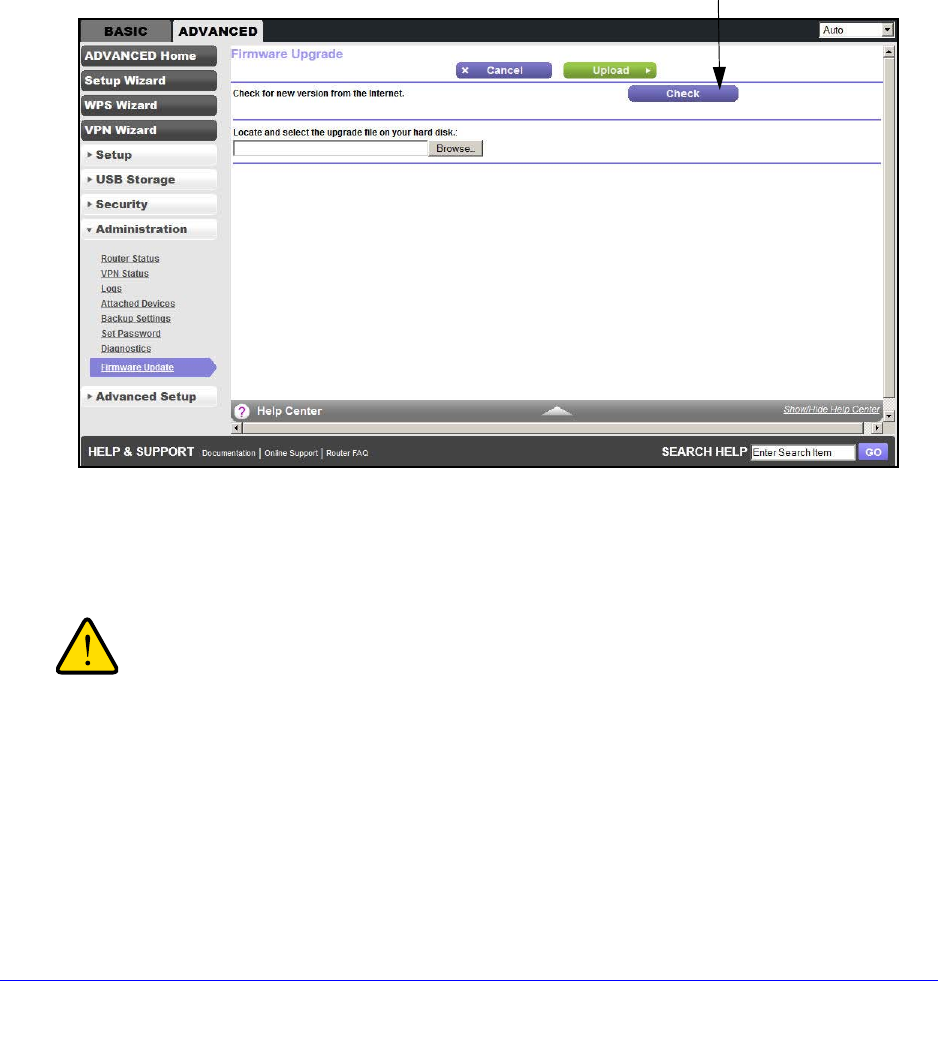
Administration
85
D6200 WiFi Modem Router
Upgrade the WiFi Modem Router Firmware
The WiFi modem router firmware (routing software) is stored in flash memory. You can
update the firmware from the Administration menu on the Advanced tab. You might see a
message at the top of the genie screens when new firmware is available for your product.
You can use the Check button on the Firmware Upgrade screen to check and update to the
latest firmware for your product when new firmware is available.
To check for new firmware and update your WiFi modem router:
1. Select ADVANCED > Administration > Router Update to display the following screen:
Click Check.
2. Click Check.
The WiFi modem router finds new firmware information when any is available.
3. Click Yes to update and locate the firmware you downloaded (the file ends in .img).
WARNING:
When uploading firmware to the WiFi modem router, do not
interrupt the web browser by closing the window, clicking a link,
or loading a new page. If the browser is interrupted, it could
corrupt the firmware.
When the upload is complete, your WiFi modem router restarts. The upgrade process
typically takes about one minute. Read the new firmware release notes to determine
whether you need to reconfigure the WiFi modem router after upgrading.
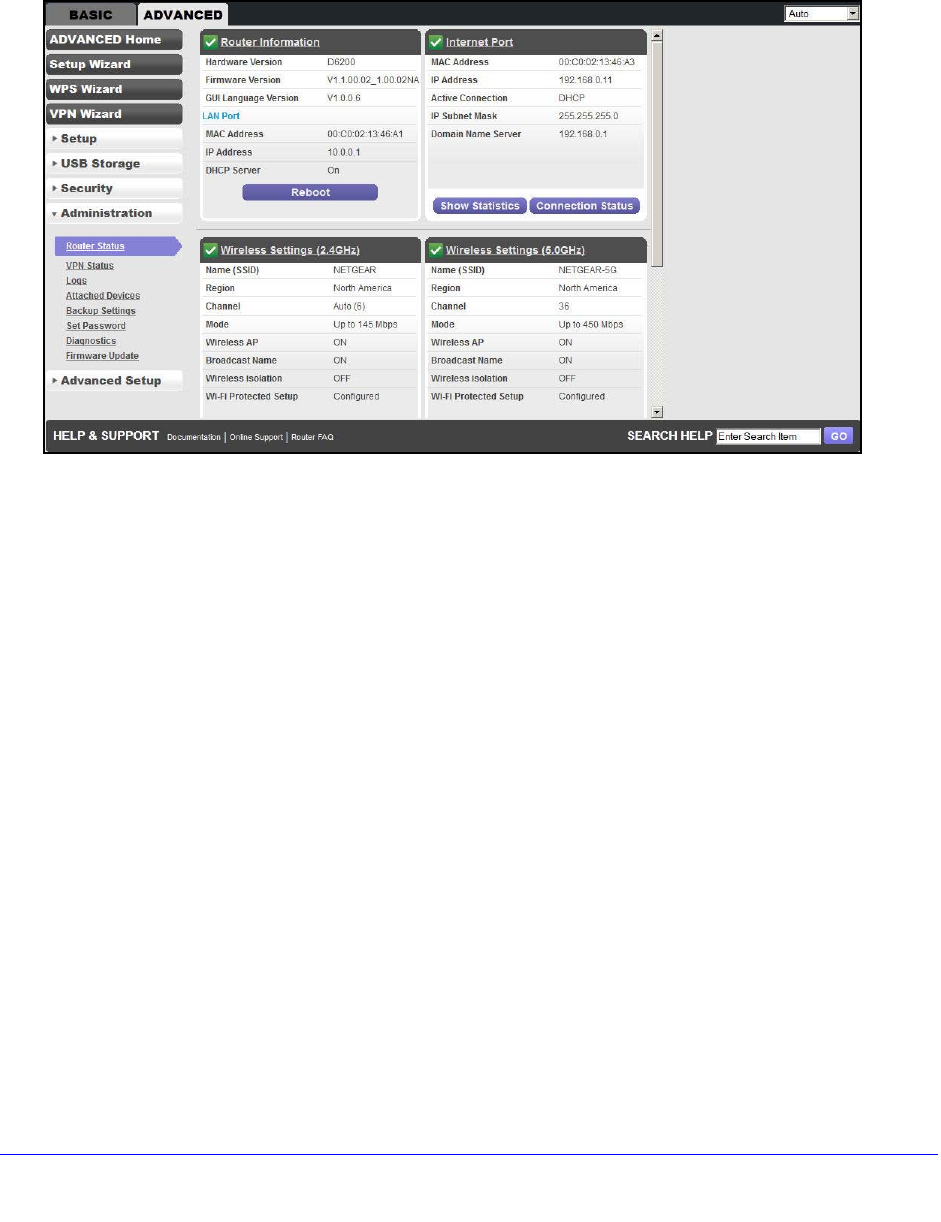
Administration
86
D6200 WiFi Modem Router
View WiFi Modem Router Status
To view WiFi modem router status and usage information, select ADVANCED Home, or
select Administration > Router Status to display the following screen:
Router Information
Hardware Version. The WiFi modem router model.
Firmware Version. The version of the WiFi modem router firmware. It changes if you
upgrade the WiFi modem router firmware.
GUI Language Version. The localized language of the user interface.
LAN Port.
•MAC Address. The Media Access Control address. This address is the unique physical
address used by the Ethernet (LAN) port of the WiFi modem router.
•IP Address. The IP address used by the Ethernet (LAN) port of the WiFi modem router.
The default is 192.168.1.1.
•DHCP Server. Identifies whether the WiFi modem router’s built-in DHCP server is active
for the LAN-attached devices.
Internet Port
MAC Address. The Media Access Control address. This address is the unique physical
address used by the Internet (WAN) port of the WiFi modem router.
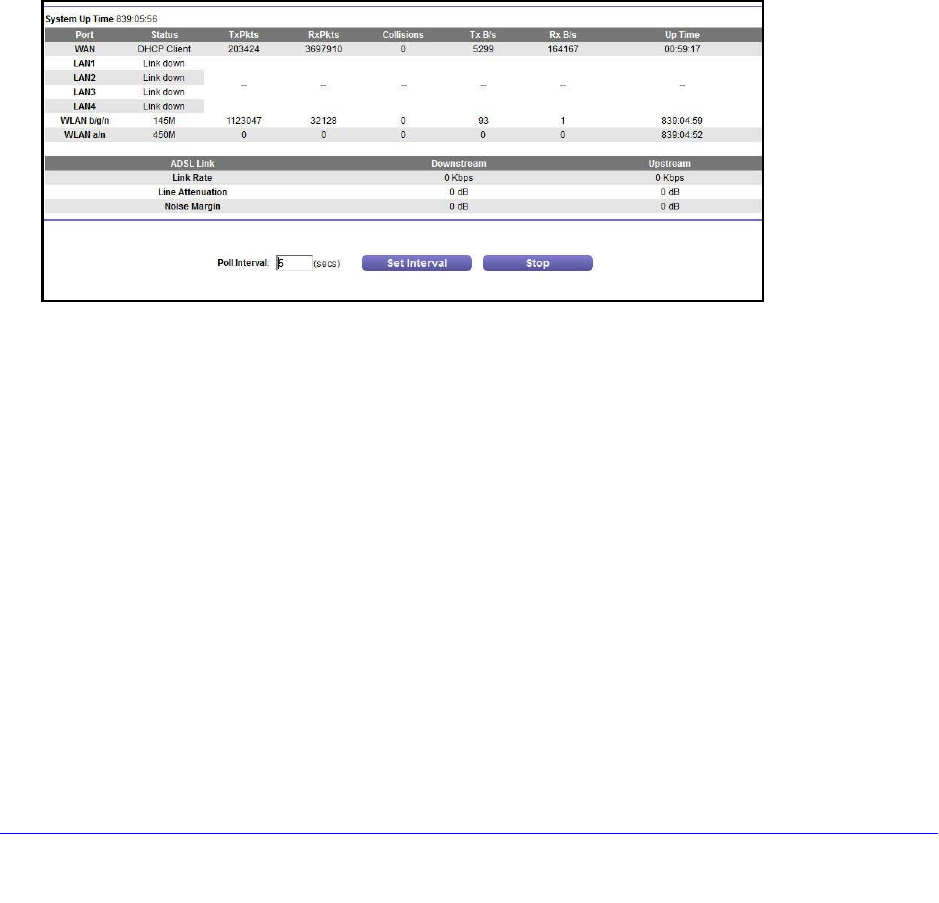
Administration
87
D6200 WiFi Modem Router
IP Address. The IP address used by the Internet (WAN) port of the WiFi modem router. If no
address is shown or the address is 0.0.0, the WiFi modem router cannot connect to the
Internet.
Active Connection. This shows if the WiFi modem router is using a fixed IP address on the
WAN. If the value is DHCP Client, the WiFi modem router obtains an IP address dynamically
from the ISP.
IP Subnet Mask. The IP subnet mask used by the Internet (WAN) port of the WiFi modem
router.
Domain Name Server. The Domain Name Server addresses used by the WiFi modem
router. A Domain Name Server translates human-language URLs such as www.netgear.com
into IP addresses.
Show Statistics Button
On the Router Status screen, in the Internet Port pane, click the Show Statistics button to
display the following screen:
Figure 10. System up time and poll interval statistics
System Up Time. The time elapsed since the WiFi modem router was last restarted.
Port. The statistics for the WAN (Internet) and LAN (Ethernet) ports. For each port, the
screen displays:
•Status. The link status of the port.
•TxPkts. The number of packets transmitted on this port since reset or manual clear.
•RxPkts. The number of packets received on this port since reset or manual clear.
•Collisions. The number of collisions on this port since reset or manual clear.
•Tx B/s. The current transmission (outbound) bandwidth used on the WAN and LAN ports.
•Rx B/s. The current reception (inbound) bandwidth used on the WAN and LAN ports.
•Up Time. The time elapsed since this port acquired the link.
•Poll Interval. The interval at which the statistics are updated in this screen.
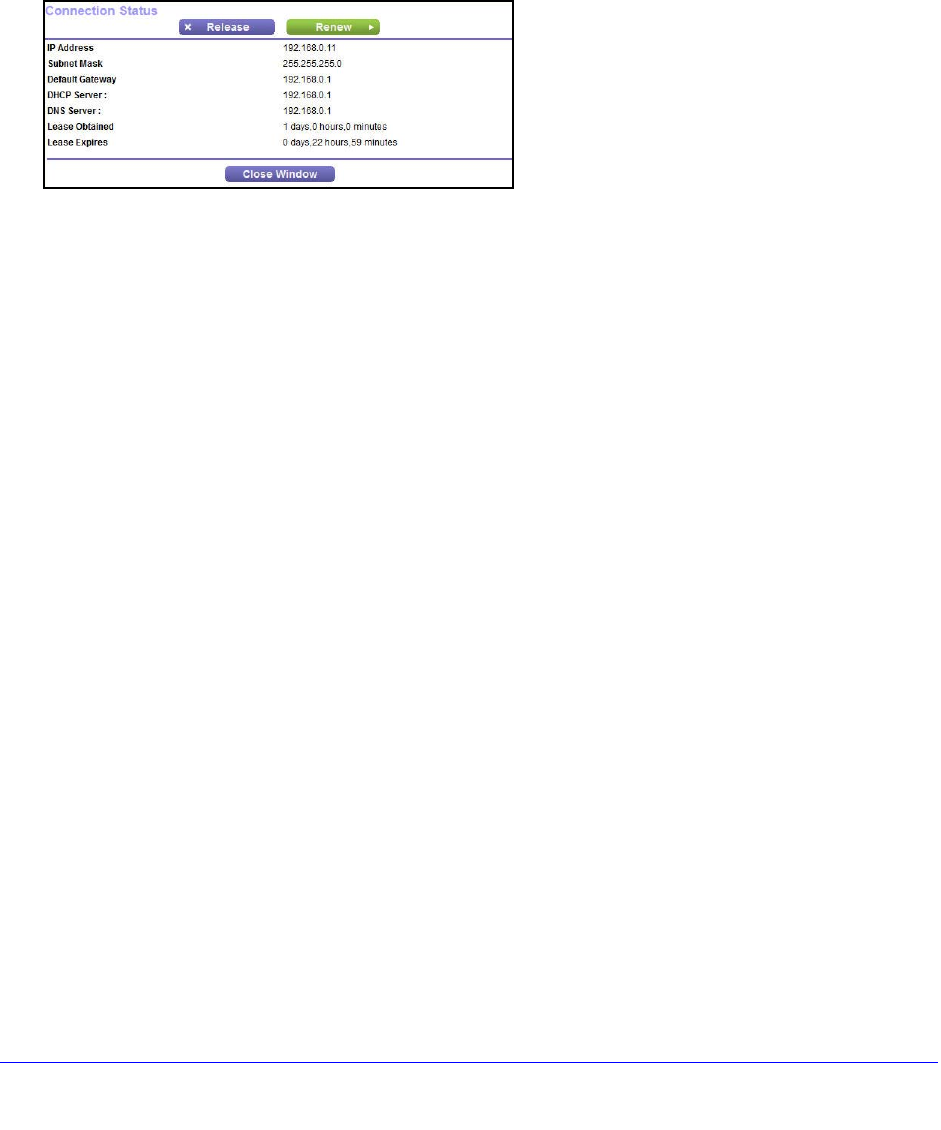
Administration
88
D6200 WiFi Modem Router
To change the polling frequency, enter a time in seconds in the Poll Interval field and click Set
Interval.
To stop the polling entirely, click Stop.
Connection Status Button
On the Router Status screen in the Internet Port pane, click the Connection Status button to
view connection status information.
Figure 11. View connection status information
The Release button returns the status of all items to 0. The Renew button refreshes the
items. The Close Window button closes the Connection Status screen.
IP Address. The IP address that is assigned to the WiFi modem router.
Subnet Mask. The subnet mask that is assigned to the WiFi modem router.
Default Gateway. The IP address for the default gateway that the WiFi modem router
communicates with.
DHCP Server. The IP address for the Dynamic Host Configuration Protocol server that
provides the TCP/IP configuration for all the computers that are connected to the WiFi
modem router.
DNS Server. The IP address of the Domain Name Service server that provides translation of
network names to IP addresses.
Lease Obtained. The date and time when the lease was obtained.
Lease Expires. The date and time that the lease expires.
Wireless Settings (2.4 GHz and 5 GHz)
The following settings are displayed:
Name (SSID). The wireless network name (SSID) used by the WiFi modem router. The
default names for the 5 GHz ends in -5G to distinguish it from the 2.4-GHz network.
Region. The geographic region where the WiFi modem router is being used. It might be
illegal to use the wireless features of the WiFi modem router in some parts of the world.
Channel. Identifies the operating channel of the wireless port being used. The default
channel is Auto. When Auto is selected, the WiFi modem router finds the best operating

Administration
89
D6200 WiFi Modem Router
channel available. If you notice interference from nearby devices, you can select a different
channel. Channels 1, 6, and 11 do not interfere with each other.
Mode. Indicates the wireless communication mode: Up to 54 Mbps, Up to 130 Mbps
(default), and Up to 300 Mbps.
Wireless AP. Indicates whether the radio feature of the WiFi modem router is enabled. If this
feature is not enabled, the Wireless LED on the front panel is off.
Broadcast Name. Indicates whether the WiFi modem router is broadcasting its SSID.
Wireless Isolation. Indicates whether wireless connections to the WiFi modem router are
prevented.
Wi-Fi Protected Setup. Indicates whether Wi-Fi Protected Setup is configured for this
network.
Guest Network (2.4 GHz and 5 GHz)
Name (SSID). The 11N wireless network name (SSID) used by the WiFi modem router. The
default names are NETGEAR-Guest and NETGEAR-5G-Guest.
Wireless AP. Indicates whether the radio feature of the WiFi modem router is enabled. If this
feature is not enabled, the Wireless LEDs on the front panel are off.
Broadcast Name. Indicates whether the WiFi modem router is broadcasting its SSID.
Wireless Isolation. Indicates whether wireless connections to the WiFi modem router are
prevented.
Allow guest to access My Local Network. Indicates whether any user who connects to this
SSID can access local networks associated with the WiFi modem router.
View VPN Status
The log is a detailed record of the websites you accessed or attempted to access. Up to
256 entries are stored in the log. Log entries appear only when keyword blocking is enabled
and no log entries are made for the trusted user.
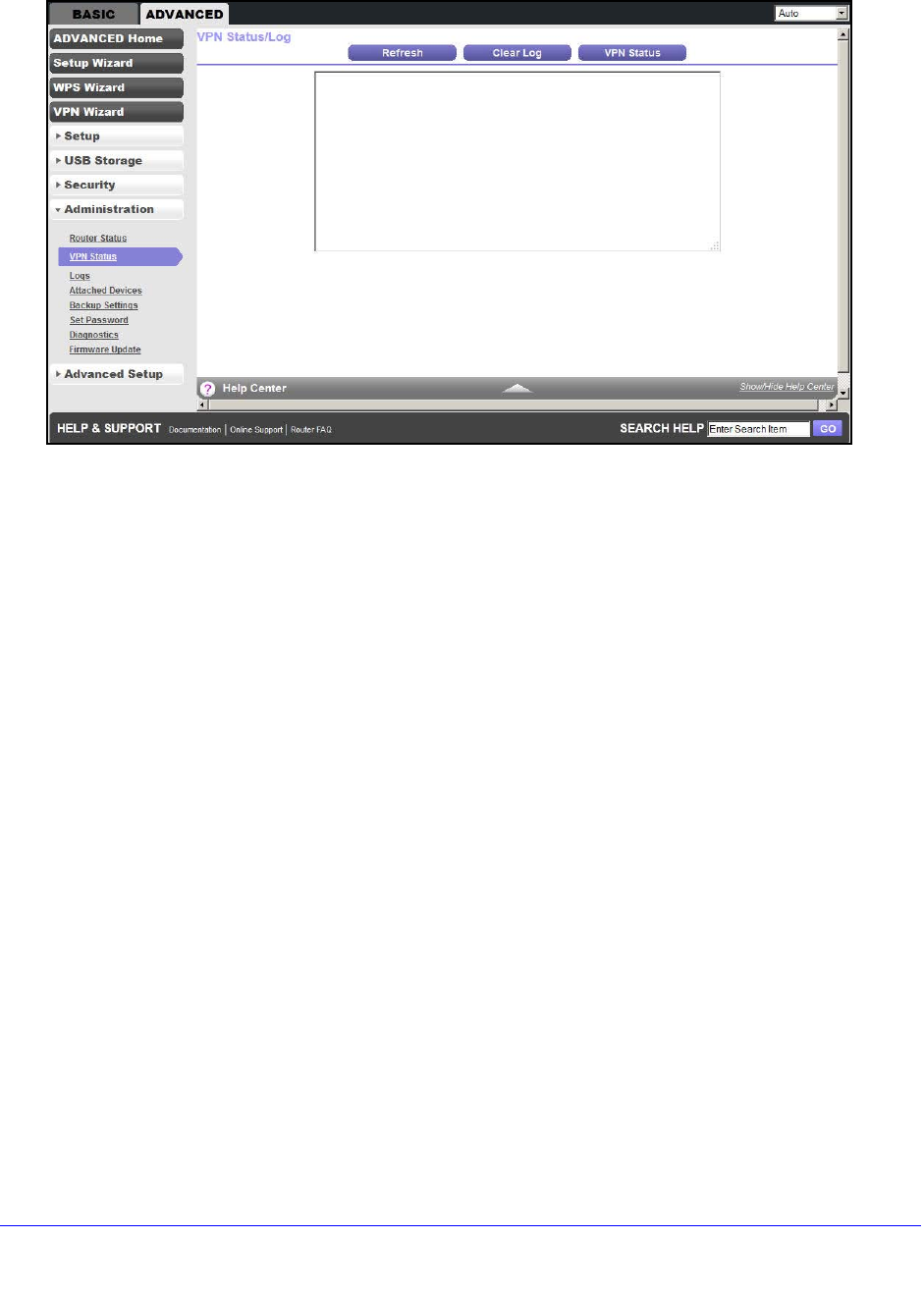
Administration
90
D6200 WiFi Modem Router
Select ADVANCED > Administration > VPN Status. The VPN Status/Log screen displays:
The VPN Status/Log screen shows the details of recent VPN activity.
To refresh the log screen, click the Refresh button.
To clear the log entries, click the Clear Log button.
To email the log immediately, click the Send Log button.
View Logs of Web Access or Attempted Web Access
The log is a detailed record of the websites you accessed or attempted to access. Up to
256 entries are stored in the log. Log entries appear only when keyword blocking is enabled
and no log entries are made for the trusted user.
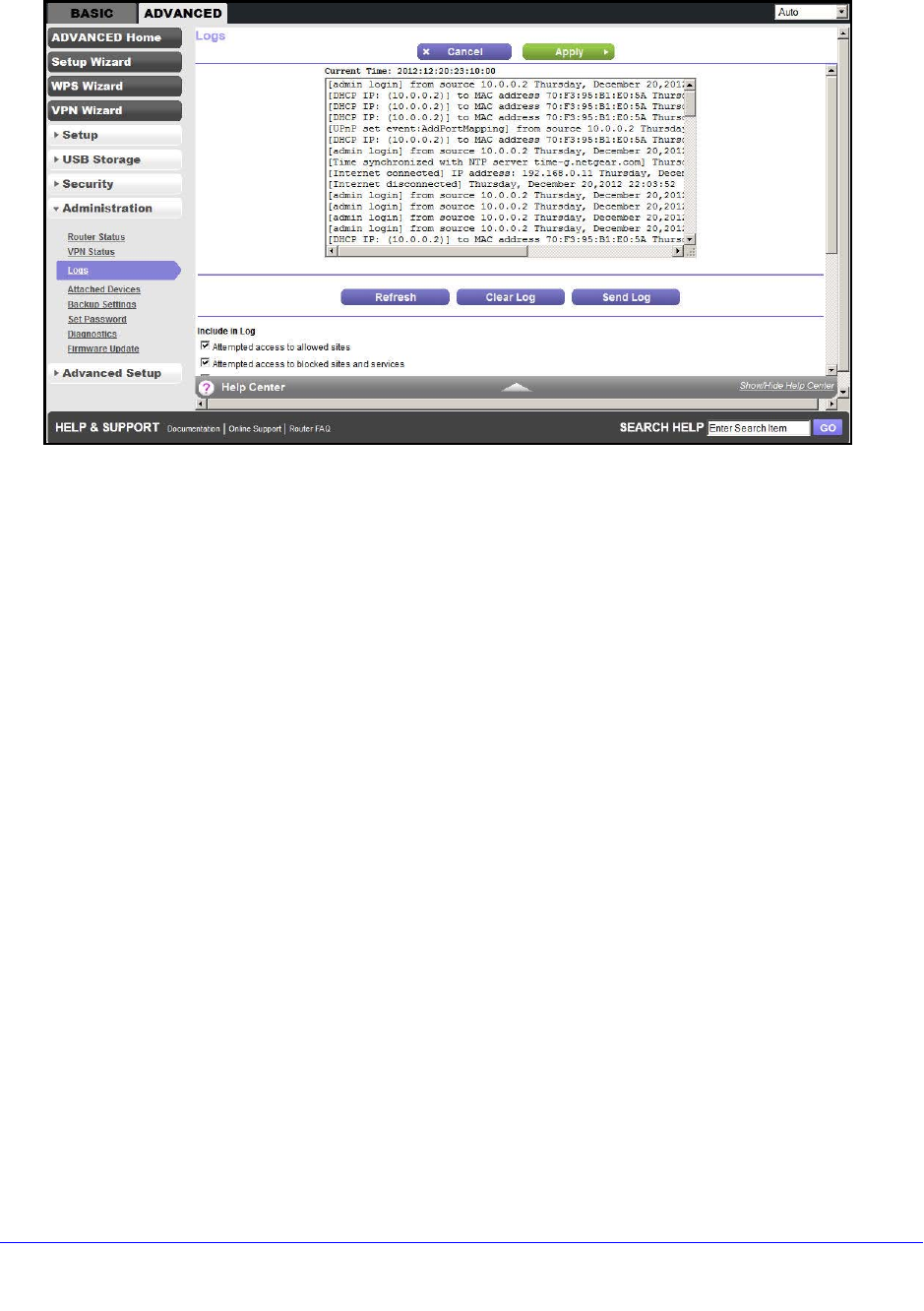
Administration
91
D6200 WiFi Modem Router
Select ADVANCED > Administration > Logs. The Logs screen displays.
The Logs screen shows the following information:
•Date and time. The date and time the log entry was recorded.
•Source IP. The IP address of the initiating device for this log entry.
•Target address. The name or IP address of the website or news group visited or to which
access was attempted.
•Action. Whether the access was blocked or allowed.
•Include in Log. A log is a detailed record of the websites that users on your network
have accessed or attempted to access. If you have set up content filtering on the Block
Sites screen, the Logs screen shows you when someone on your network tried to access
a blocked site. When you have email notification on, you receive these logs in an email
message. when you do not have email notification set up, you can view the logs here.
•Syslog. The logs can be sent to a syslog server. Enable one of these three options, as
required:
-Disable. Select this option when you do not have a syslog server.
-Broadcast on LAN. The syslog data is broadcast rather than sent to a specific syslog
server. Use this option when your syslog server does not have a fixed IP address.
-Send to this Syslog server IP address. When your syslog server has a fixed IP
address, select this option and enter the IP address of your syslog server.
To refresh the log screen, click the Refresh button.
To clear the log entries, click the Clear Log button.
To email the log immediately, click the Send Log button.
To save your settings, click the Apply button.
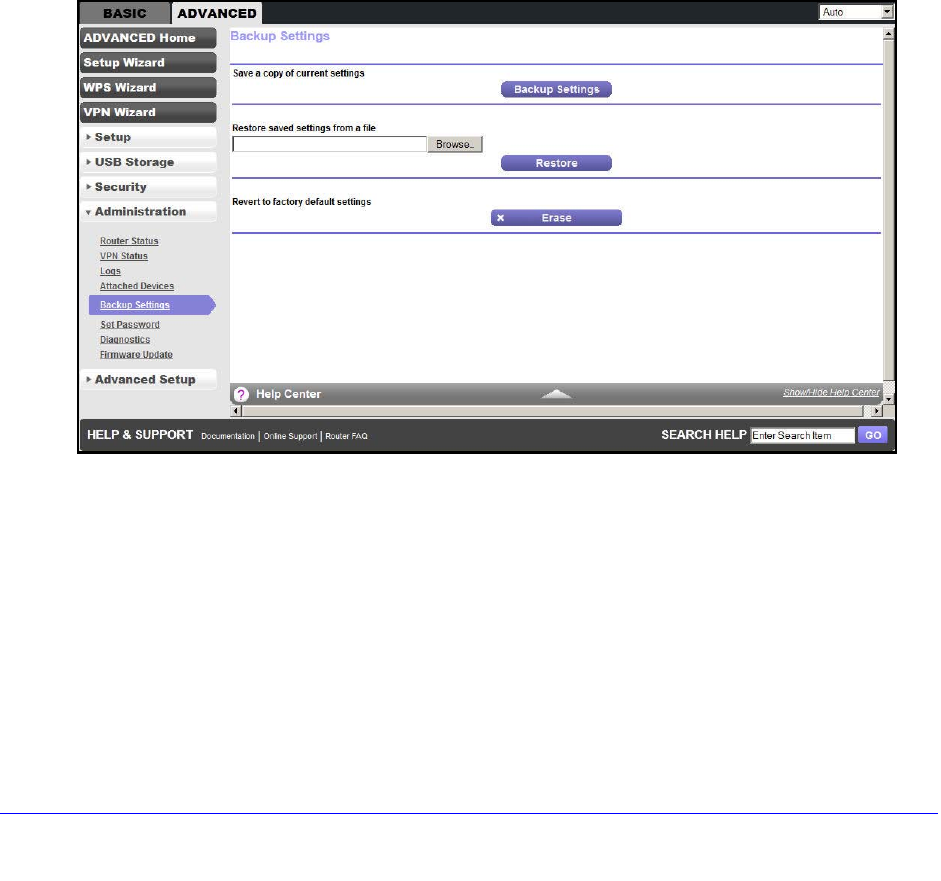
Administration
92
D6200 WiFi Modem Router
Attached Devices
See Attached Devices on page 32.
Manage the Configuration File
The configuration settings of the WiFi Modem Router are stored within the WiFi modem
router in a configuration file. You can back up (save) this file to your computer, restore it, or
reset it to the factory default settings.
Back Up Settings
To back up the WiFi modem router’s configuration settings:
1. Select ADVANCED > Administration > Backup Settings to display the following
screen:
2. Click Backup Settings to save a copy of the current settings.
3. Choose a location to store the .cfg file that is on a computer on your network.
Restore Configuration Settings
To restore configuration settings that you backed up:
1. Enter the full path to the file on your network or click the Browse button to find the file.
2. When you have located the .cfg file, click the Restore button to upload the file to the WiFi
modem router.
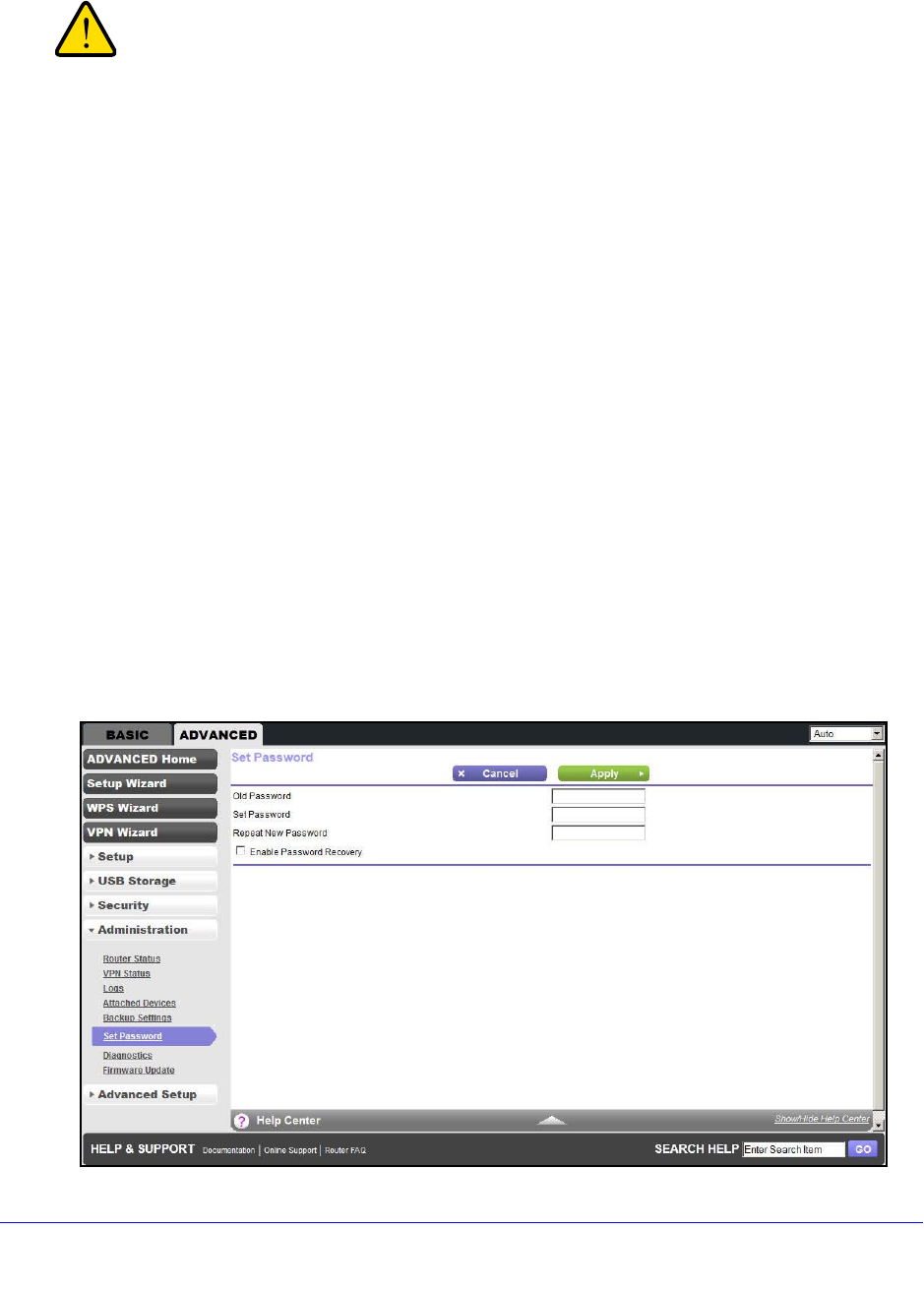
Administration
93
D6200 WiFi Modem Router
Upon completion, the WiFi modem router reboots.
WARNING:
Do not interrupt the reboot process.
Erase
Under some circumstances (for example, if you move the WiFi modem router to a different
network or if you have forgotten the password), you might want to erase the configuration
and restore the factory default settings.
Either you can use the Restore Factory Settings button on the back of the WiFi modem router
(see Factory Settings on page 141), or you can click the Erase button in this screen.
Erase sets the user name to admin, the password to password, and the LAN IP address to
192.168.1.1, and enables the WiFi modem router’s DHCP.
Set Password
This feature allows you to change the default password that is used to log in to the WiFi
modem router with the user name admin.
This procedure is not the same as changing the password for wireless access. The label on
the bottom of your WiFi modem router shows your unique wireless network name (SSID) and
password for wireless access (see Label on page 12).
To set the password for the user name admin:
1. Select ADVANCED > Administration > Set Password to display the following screen:
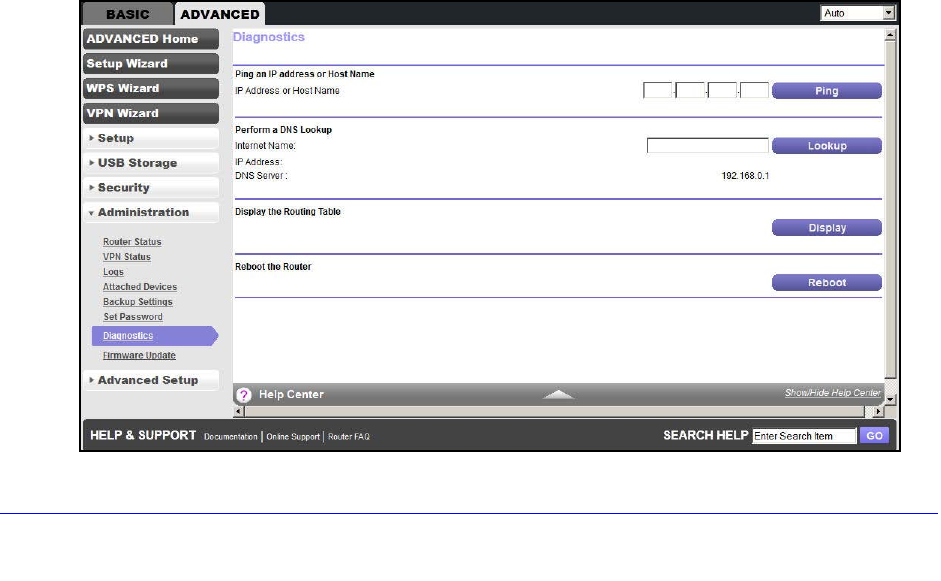
Administration
94
D6200 WiFi Modem Router
2. Type the old password and type the new password twice in the fields on this screen.
3. If you want to be able to recover the password, select the Enable Password Recovery
check box.
4. Click Apply so that your changes take effect.
Password Recovery
NETGEAR recommends that you enable password recovery if you change the password for
the router’s user name of admin. Then you have an easy way to recover the password if it is
forgotten. This recovery process is supported in Internet Explorer, Firefox, and Chrome
browsers, but not in the Safari browser.
To set up password recovery:
1. Select the Enable Password Recovery check box.
2. Select two security questions and provide answers to them.
3. Click Apply to save your changes.
When you use your browser to access the router, the login window displays. If password
recovery is enabled, when you click Cancel, the password recovery process starts. You can
then enter the saved answers to the security questions to recover the password.
Diagnostics
You can perform various diagnostics. For normal operation, these tests are not required.
To perform diagnostic tests:
1. Select ADVANCED > Administration > Diagnostics to display the following screen:

Administration
95
D6200 WiFi Modem Router
2. Perform the following diagnostics as needed:
•Ping an IP address or Host Name. Use this test to send a ping packet request to the
specified IP address or host name. This test is often used to test a connection. If the
request times out (in other words, no reply is received), this result usually means that
the destination is unreachable. Note, however, that some network devices can be
configured not to respond to a ping.
•Perform a DNS Lookup. A DNS (Domain Name Server) converts the Internet name
(for example, www.netgear.com) to an IP address. If you need the IP address of a
web, FTP, mail, or other server on the Internet, do a DNS lookup to find the IP
address.
•Display the Routing Table. This operation displays the internal routing table.
•Reboot the Router. Click this button to perform a remote restart of the router. Use
this operation if the router seems to have become unstable or is not operating
normally.
Note: Rebooting breaks any existing connections either to the router (such
as this one) or through the router (LAN users accessing the
Internet). However, connections to the Internet are automatically
reestablished when possible.